The Hawaiian islands are a highlight on virtually everyone’s bucket list, offering breathtaking mountain hikes, pristine white sand beaches, world class surfing, award-winning dining, luxury shopping, and five-star resorts featuring pro golf courses, all presented with the beauty and warmth of the aloha spirit. We are lucky to call Oahu home, where we’ve been adhering to strict stay-at-home orders for the past four months.
With 28,000 travelers reportedly pouring into Hawai’i every day during the months of January and February earlier this year, including 20 percent of them from Asia, the state seemed fertile ground for a major COVID-19 outbreak. That was especially true on Oahu, according to an online POLITICO article, where at least one-third of the state’s visitors cram into the hotels, stores, restaurants and beaches that line Waikiki’s two miles. Even without tourists, Oahu, where the bulk of the state’s population lives, is jam-packed—significantly more so than New Jersey, the nation’s most densely populated state.
We seemed to be living in a petri dish on Oahu so most of us hunkered down in fear. But a catastrophe never came. Instead of a massive, uncontrolled outbreak, Hawai’i has experienced the lowest infection and mortality rates in the country.
At the onset of the coronavirus pandemic, on March 26, Hawai’i Governor David Ige instituted a mandatory 14-day quarantine for incoming and inter-island travelers, including all visitors and residents. In addition to risking the health of yourself and others, ignoring the quarantine requirement can subject you to arrest and fines of up to $5,000. There have been multiple arrests of both visitors and residents who have violated the quarantine.
As part of the screening process, upon arriving in Hawai’i, everyone must complete state government forms and provide an address where they will quarantine. Follow-up calls are made to ensure compliance.
If you don’t have a place to stay or if you violate quarantine, my friend, Jessica Lani-Rich will provide you with a return ticket home courtesy of the Visitor Aloha Society of Hawaii (VASH). Jessica is the CEO of VASH and has recently been featured in Pacific Business News and Time magazine proclaiming that “safety in tourism is a top priority.” Over 150 visitors have been sent home. For example, she recently had to send over 20 members of a cult back to the mainland.
Jessica and I are both members of the Rotary Club of Honolulu, and VASH was founded by the Rotary Club of Honolulu in 1997. Jessica was the featured speaker during one of our recent weekly club meetings, which now take place via Zoom. She talked about the quarantine violators and how VASH is managing during the pandemic, “Hawai’i has the lowest COVID-19 cases in the nation, and I’m glad to be part of a team of dedicated people who are playing an important role in keeping Hawai’i safe.” Jessica explained that in addition to safety, “it’s all to help preserve the tourism industry for the future.”
As an additional layer of protection beyond the travel restrictions, Hawai’i also enforced strict stay-at-home orders for residents that only recently have begun to slowly lift, resulting in an anticipated but manageable uptick in positive cases. Hawaii’s exemplary COVID-19 response has largely been influenced by Josh Green, the Lieutenant Governor and a practicing emergency room doctor, whose encouraging video updates on the daily infection and recovery rates fill local residents’ social media feeds. He encourages us to diligently wash our hands, wear our masks and practice social distancing. Although they sometimes seemed at odds during the early, roller coaster days of the pandemic, the Governor usually heeded the Lieutenant Governor’s medical expertise.
In Hawai’i, the state also relied on the spirit of aloha to flatten the curve. “Maybe it’s because we’re on an island, but people here understand that what we do impacts our neighbors and friends,” Gov. Ige said. “People took the mandates to stay at home and self-isolate seriously, and they encouraged each other to implement it.”
But the success hasn’t come without a price. According to the Wall Street Journal, Hawaii’s workforce has sought unemployment benefits at the highest rate in the nation since mid-March, reflecting how hard the coronavirus pandemic has hit the state’s vital tourism industry.
The state’s $18 billion tourism industry ground to a near-halt in March, after the federal administration recommended Americans avoid unnecessary travel and bars and restaurant dining rooms closed. The scale of the job losses highlights how important tourism is to the state’s economy. More than 10 million people traveled to Hawai’i last year, generating $2 billion in state tax revenue, according to the state tourism authority. Leisure and hospitality, including food service, account for 19% of all employment on the islands.
Trying to balance the importance of reopening tourism to re-start the economy while keeping both visitors and residents safe, especially our vulnerable kupuna (elders), is a complicated process. The first phase involved lifting the mandatory quarantine for inter-island travel on June 16.
A second step was slated to begin August 1, allowing all trans-Pacific travelers arriving in Hawai’i from out-of-state to have the option of getting a valid COVID-19 test prior to their arrival, and showing proof of a negative test result, to avoid the 14-day quarantine. Evidence of a negative test result would be required upon arrival in Hawai’i.
The plan was considered by many to be a lifeline to Hawaii’s flat-lining visitor industry and would require travelers to get tested before they arrive in the islands. But the plan hit a number of roadblocks after being announced, including a surge in infections on the mainland and a subsequent shortage of tests in some areas.
Gov. Ige thus extended the 14-day mandatory quarantine for all trans-Pacific travelers through the end of August as the state continues to hammer out the details of how the testing program would work ― and ensure that visitors don’t slip through the cracks.
The period of time between the June 16 lifting of the mandatory quarantine for local inter-island travel and the pre-testing program for out-of-state visitors presented us with an unprecedented window of opportunity for a relatively safe staycation devoid of the usual abundance of tourists.
The exciting invitation proclaimed, “We are pleased to announce the reopening of Four Seasons Resort Lana’i! Kama’Aina (Hawai’i residents) are invited to hop over to the island paradise starting July 1, 2020. Welcoming guests through our doors is at the heart of what we do. And now, we are ready to welcome you once again.”
The enticing Four Seasons Resort Lana’i has been on my bucket list for the last few years that I’ve been watching the jaw-dropping footage of the breathtaking property from our living room on the Scenic Hawai’i television station. Currently, they are offering Kama’Aina (local discounted) room rates of 20 percent off bookings, as well as 15 percent off spa services. Golfers can enjoy a round on the Jack Nicklaus-designed Manele Golf Course for $275 per player for 18 holes and, through July 31, 2020, guests receive 20 percent off island activities including all ocean activities except private charters, sporting clays and archery at the Lana’i Archery and Shooting Range, and horseback riding at Lana’i Ranch.
Beyond August 31, there are special offers that extend to out-of-state travelers as well, and all guests booking a stay by August 31, 2020 for travel arriving by January 4, 2021 will also enjoy round-trip luxury private flights on Lana’i Air from Honolulu to Lana’i City with a reservation of any room or suite in addition to airport transfers and intra-island transportation.
Kama’Aina rates can be booked only by phone 800 321 4666 or email res.lanai@fourseasons.com and other offerings can be booked online https://www.fourseasons.com/lanai/
We took advantage of the “Stay Longer” promotion, offering a complimentary fifth night with every four consecutive paid nights as well as the round-trip private air included.
Travelers on Lana’i Air depart from a private hangar at the Daniel K. Inouye International Airport in Honolulu. The opportunity to avoid having to traverse the airports was an important factor in deciding if the temptation of the getaway was worth the risk.
My travel companion is my partner’s Mom, Geri Yoder “Mama G.” Her age and underlying health conditions have kept her quarantined safely at home for four months in Mililani Town on Oahu, but she was ready to fly the coop! Given her vulnerability, we gave several factors serious consideration before committing to the trip. Not being exposed to the travelers inside the airport made us feel safer. We knew there would be no out-of-state travelers at the resort during our stay. Additionally, there have been zero cases of COVID-19 on Lana’i.
Finally, as one can imagine, guest and employee health and safety remain a top priority as the resort resumes operations. Along with closely monitoring and adhering to federal, state, and local government mandates, the resort is implementing Lead With Care, the new Four Seasons global standard of hotel cleanliness and safety protocols.
“Along with already-commonplace measures such as more sanitizers, masks and heightened cleaning and hygiene, our Lead With Care program will enhance our tools and training to deliver an experience grounded in safety and trust,” Christian Clerc, president of global operations at Four Seasons Hotels and Resorts, said in a statement. “While the Four Seasons experience may look different in this new environment, it will ultimately feel the same — our dedicated people will continue to deliver the same intuitive service and personalized care for which Four Seasons is known and trusted the world over.”
According to Travel Weekly, the new Lead With Care protocols include: a hygiene officer for each property to monitor implementation of the new standards; daily disinfection of guestrooms with blacklight inspection; hourly cleaning of public areas, including high-touch surfaces; guestrooms equipped with kits stocked with masks, hand sanitizer and sanitizing wipes; limited capacity or altered layouts for social distancing at restaurants and bars; a contactless delivery option for in-room dining; employee training on the new procedures, COVID-19 transmission, proper use of PPE, and appropriate social distancing, as well as behavioral training geared at providing customer service in the new environment.
NanoSeptic Self-Cleaning surfaces, including elevator buttons and other high touch areas, were a new and reassuring mitigation effort that I observed during our stay. A cleaning system based on technology, not toxins, NanoSeptic skins and mats turn dirty, high traffic public touch points into continuously self-cleaning surfaces. I had never seen them before. We also received welcome gift bags in our room with hand sanitizer and face masks designed by Hawaiian clothier Reyn Spooner, known for classic aloha shirts. A nice touch for the “new normal.”
 On the highly anticipated day of our departure, we anxiously put on our brave faces (underneath our masks of course) and our neighbor, Aunty June, delivered us directly to the private Lana’i Air lounge where we were escorted to the tarmac like the Kardashians and boarded with our two Yorkies, LuLu and Spike, otherwise known as High and Maintenance, in tow.
On the highly anticipated day of our departure, we anxiously put on our brave faces (underneath our masks of course) and our neighbor, Aunty June, delivered us directly to the private Lana’i Air lounge where we were escorted to the tarmac like the Kardashians and boarded with our two Yorkies, LuLu and Spike, otherwise known as High and Maintenance, in tow.
Lana’i Air offers luxurious daily flights between Lana’i City and Daniel K. Inouye International Airport on Oahu. Lana’i Air is an ultra-lux and convenient way to begin your island adventure. We experienced the comfort and quality of Lana’i Air’s Pilatus PC-12, a legendary Swiss turboprop with an outstanding safety record proven over six million flight hours. For added safety, two pilots operate each Lana’i Air flight. The elegant yet reliable aircraft is large enough to seat a party of six comfortably. Lana’i Air offers a seamless and exceptional travel experience that begins the moment you board your plane.
From the moment you enter the cabin, it is apparent the PC-12 is truly in a class of its own. BMW Designworks crafted the PC-12’s modern, elegant interior. The executive seats are stately and engineered for comfort. You will appreciate the old-world craftsmanship and attention to detail presented in the form of custom leather work, rare-wood cabinetry and elegant upholstery. The aircraft has been individually and exquisitely crafted to make your Lana’i flying experience extraordinary.
Upon your arrival at the Daniel K. Inouye Airport in Honolulu, Four Seasons guests are escorted from a private hangar with direct tarmac access to your Lana’i Air plane. The VIP waiting lounge was modern and clean and we were offered refreshments. When you arrive on Lana’i, luxury ground transportation is included for Four Seasons guests from the airport to the resort.
Mama G was nervous to fly in a single engine plane but this eagle was state of the art and it looked damn spectacular parked on the tarmac glimmering in the sunlight with a red carpet leading to the stairs. Justin, our hunky pilot with long hair and biceps popping out of his uniform, was standing outside the aircraft, and he helped ease her nerves. Once Mama G got a look at Justin, her flying anxiety vanished. Indeed, everyone that sees our photo with Justin comments on how “hot” the pilot is. Have a look for yourself. Don’t get your hopes up, though, Justin is married and he wasn’t on our return flight because he was celebrating his anniversary.


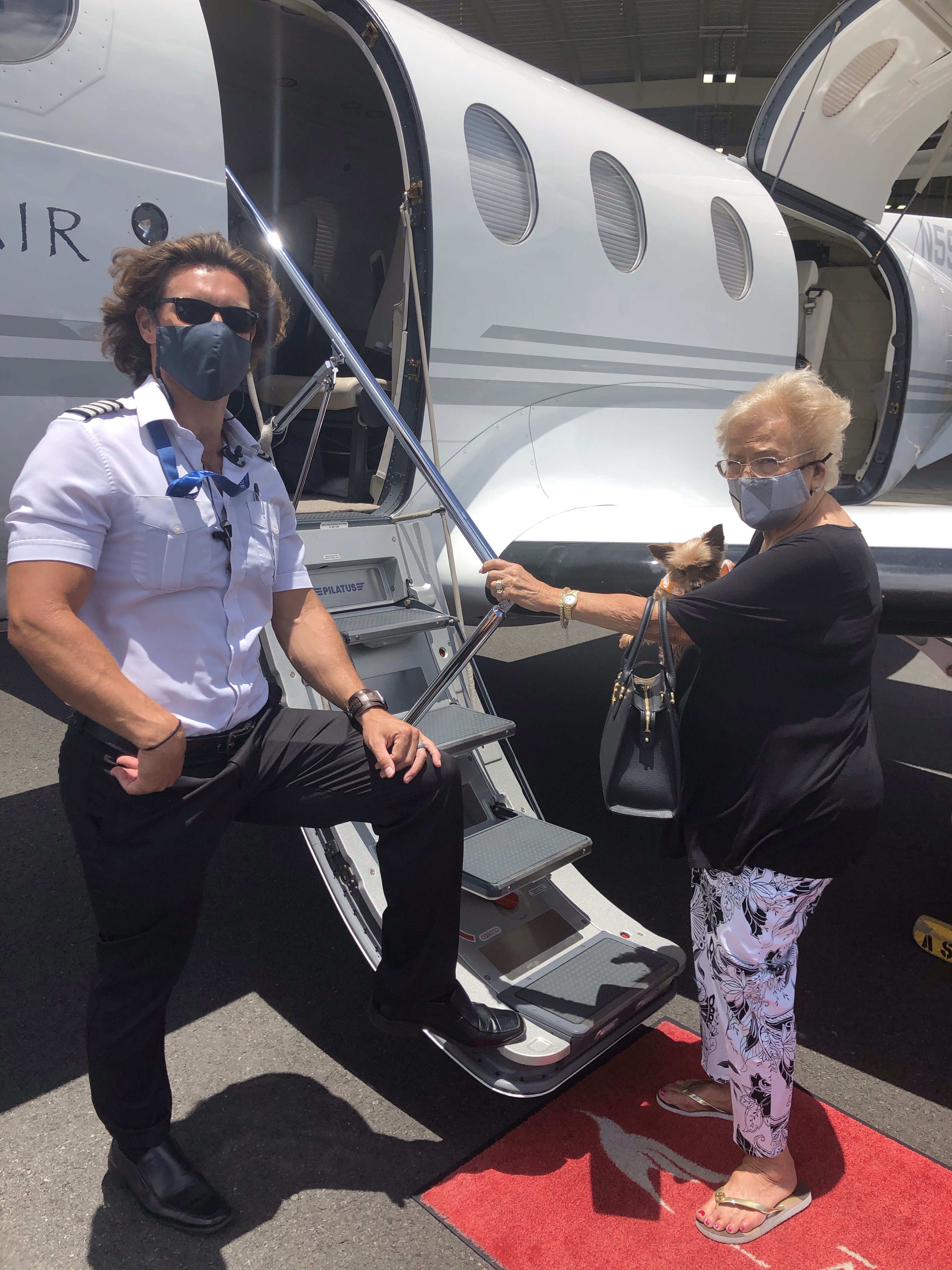 It was a beautiful day to fly with bright blue skies and a few cotton candy clouds. Departing Oahu, the waters off Waikiki and Hanauma Bay were an electric neon turquoise due to the lack of pollution from tourists. Justin offered to fly us over the resort to have a bird’s eye view before landing, which was a special treat.
It was a beautiful day to fly with bright blue skies and a few cotton candy clouds. Departing Oahu, the waters off Waikiki and Hanauma Bay were an electric neon turquoise due to the lack of pollution from tourists. Justin offered to fly us over the resort to have a bird’s eye view before landing, which was a special treat.






The resort is an oasis that requires a 30-minute long drive on a two-lane road that begins with a straight, long stretch lined meticulously on both sides with stately pine trees. The road almost looks like something out of a children’s storybook that looks and feels more like England or France than Hawai’i. Spotting axis deer and wild turkey along the way only adds to the enchantment.
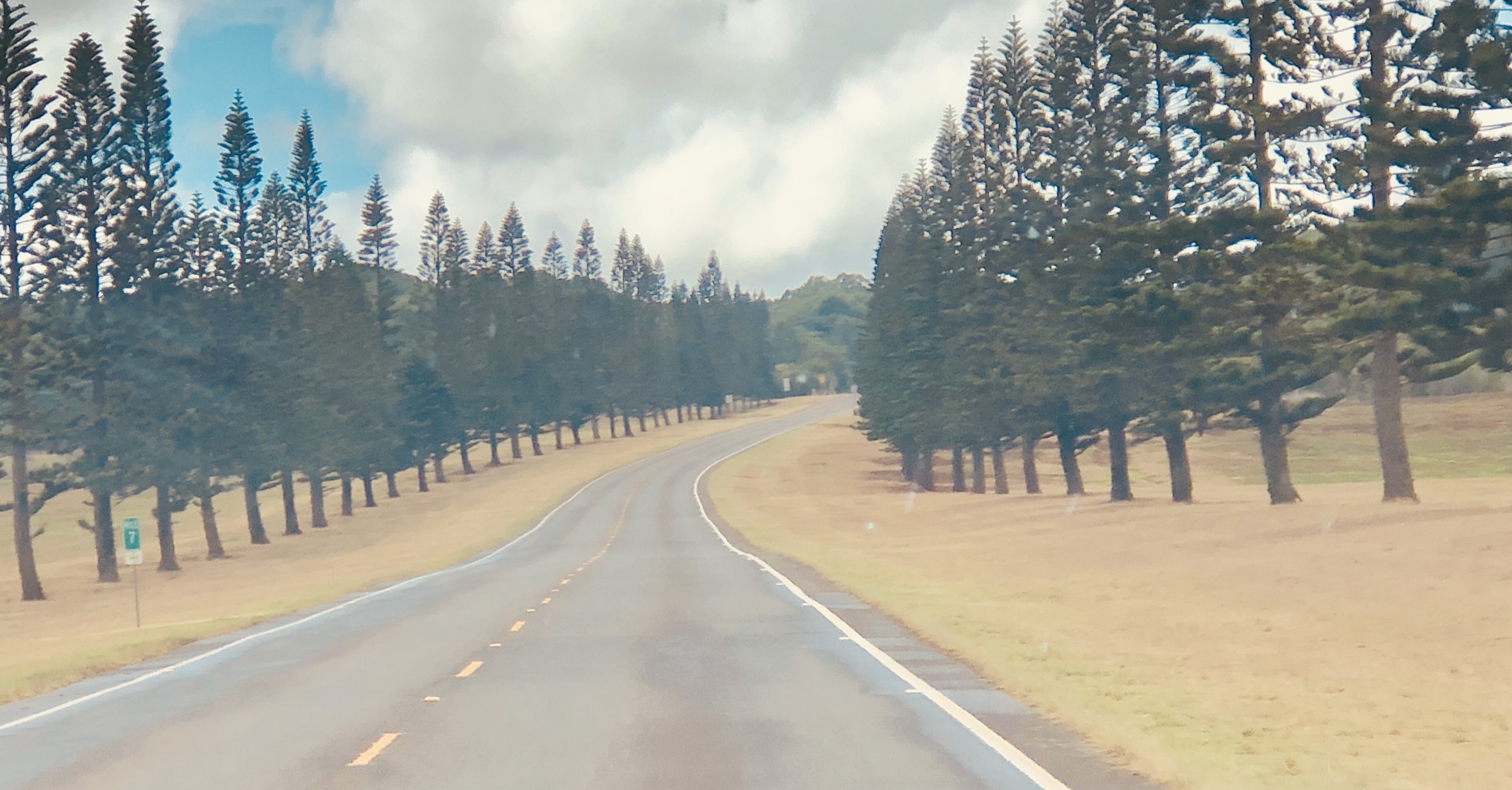
The pine trees are a signature of Lana’i and have an interesting history and purpose. The first thing you need to know is Lana’i is a rather dry island. It has the least amount of rainfall of all the Hawaiian islands because the mountains on Molokai and Maui capture most of the rainfall which comes its way.
The first pine tree on the island was a Norfolk Pine, which was planted in 1878. In 1911, manager of the ranch on Lana’i, George C. Munro, noticed that water was dripping from the pine tree onto a tin roof. George figured that the pine tree was taking water out of the fog and condensing it. He figured that if they planted more pine trees, it could bring much needed water to the island and make use of the heavy fog, which would often collect near the high points on the island.
Instead of receiving Norfolk Pines, they got Cook Island Pines by mistake. Today you can see Cook Island pines all over Lana’i City and on the highest ridge on the island, Lanaihale. It is estimated that each tree creates 200 gallons of fresh water for the island each day, all of which is taken right out of thin air.
Lana’i was once known for cultivating approximately 75 percent of the world’s pineapples following James Dole’s purchase of the island in 1922 for $1.1 million. At one time it supported nearly 20,000 acres of cultivated pineapple, making Lana’i the world’s largest plantation and earning the name, “Pineapple Island.” In order to accommodate these workers, Dole built a plantation camp in the flatlands, now Lana’i City, where most of the the island’s tiny population 3,000 live.
The late 1980’s saw a shift away from agriculture and the island began its next chapter with development as a tourist destination, and closure of the plantation. Larry Ellison, the Oracle Corp. founder who now owns 98% of Lana’i, is moving forward with a broad plan to diversify the economy on the island where luxury tourism reigns. A core piece of this vision calls for adding 546 acres to triple the size of Lana’i City to accommodate more affordable housing, a university campus, film studios and a tennis academy in the island’s center, where residents and businesses are concentrated.
Ellison is the sixth richest man in the world according to Forbes. His life story is interesting and worth a quick google. The locals say he is kind and nice. He made sure all resort employees were paid during the mandatory stay-at-home orders.
Ellison’s first huge investment was the $75 million renovation of the former Manele Bay Hotel, which reopened as the Four Seasons Resort Lana’i in 2016. The billionaire also spent an additional $75 million to convert the other luxury hotel on the island, the Lodge at Koele in Lana’i City, into a wellness retreat that is also managed by Four Seasons. Called Sensei Lana’i, it opened late last year and it’s absolutely jaw-dropping gorgeous—inside and out.
Since we are both Pisces who crave water views, we opted for the beach resort instead of the wellness retreat. Besides, who wants to do sunrise yoga when you can sleep in and order room service?
On the southeastern coast of the pristine island of Lana’i, the five-diamond Four Seasons Resort Lana’i at Manele Bay sits just a moment away from many of the most scenic spots, best reached by foot or 4-by-4, and where the Hawai’i found in vintage postcards comes vibrantly to life.
The contemporary décor of the beachside resort reflects the tones and textures of Lana’i and adds a Hawaiian aesthetic, featuring rich colors from the earth, sand and brush as well as thoughtfully curated artwork from across Polynesia, Micronesia and Hawai’i. A total of 213 rooms and suites spread over four stories overlook the protected marine preserve of Hulupoe Bay and neighboring islands Maui, Molokai and Kahoolawe.
Inspired by Hawaii’s diverse and storied Polynesian influences, the décor for the cliffside resort above the beach showcases bespoke furnishings and artwork, rich materials and contemporary amenities such as intuitive lighting, temperature, service, and privacy controls and a 75″ platinum bezel LED television panel for unparalleled in-room entertainment. The room had so many bells and whistles it was not easy to learn how to operate everything. A tutorial on how to use all of the gizmos and gadgets would have been helpful. The Toto washlet in the water closet was a nice touch, no doubt inspired by many Asian tourists who visit the property. Toto washlets are common throughout Asian countries. After a trip there a few years ago, I had one installed in my condo in Ohio before moving to the Aloha State.




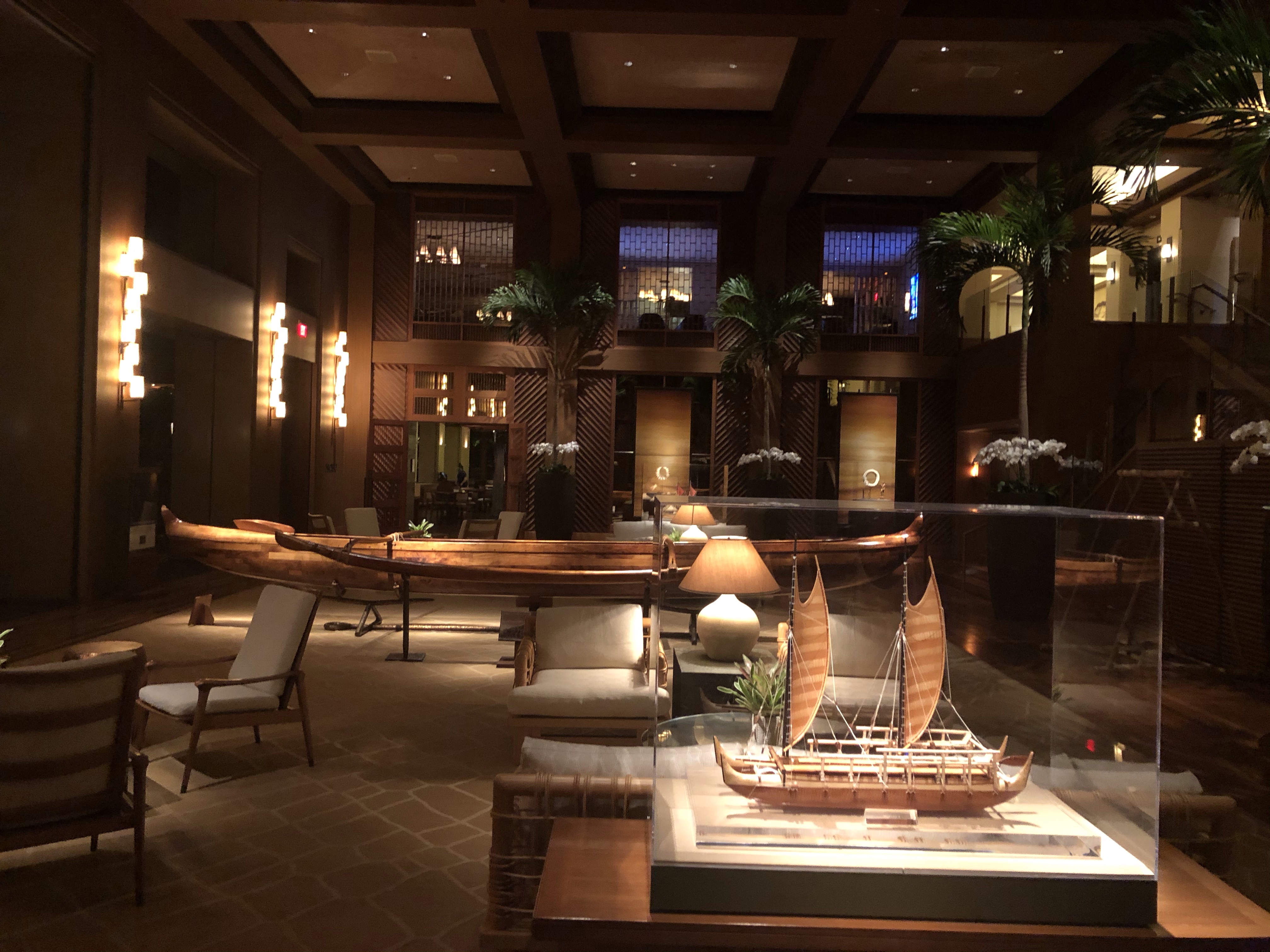


 The automatic black out shades were perfect for sleeping in late in the feather beds, which LuLu and Spike would burrow into and snuggle for hours. The hotel staff even had a pet welcoming package with dog bowls and dog beds with their names spelled out in sponge letters that doubled as toys as they flung them around the room. Every time we returned after housekeeping had been there, all of the letters were perfectly returned to their beds, spelling out their names, only to be quickly and delightfully destroyed.
The automatic black out shades were perfect for sleeping in late in the feather beds, which LuLu and Spike would burrow into and snuggle for hours. The hotel staff even had a pet welcoming package with dog bowls and dog beds with their names spelled out in sponge letters that doubled as toys as they flung them around the room. Every time we returned after housekeeping had been there, all of the letters were perfectly returned to their beds, spelling out their names, only to be quickly and delightfully destroyed.


 On the southeastern shores of Hawaii’s last unspoiled island, Four Seasons Resort Lana’i is your gateway to an exotic, private paradise where opportunities for adventure and relaxation abound. By land, sea and sky, Lanai’s riches are all yours to discover.
On the southeastern shores of Hawaii’s last unspoiled island, Four Seasons Resort Lana’i is your gateway to an exotic, private paradise where opportunities for adventure and relaxation abound. By land, sea and sky, Lanai’s riches are all yours to discover.
Frequent shuttles are offered to Lana’i City to explore the charming plantation town as well as access to hiking, horseback riding, archery, clay shooting and more in the green uplands of the island. In addition to activities and tours to explore and satiate the adventurous spirit, there are also a plethora of dining and refreshment offerings throughout the property. Following is a list of tempting options, all of which we thoroughly enjoyed.
NOBU LANAI
Take a seat at the intimate sushi bar for a hand-selected meal of fresh-caught fish, share a one-of-a-kind dining experience at our private teppan table, or join friends and family on the cliff-side terrace. At any spot, you’ll savor the innovative Japanese cuisine of world-renowned Chef Nobu Matsuhisa, next to sweeping views of the Pacific Ocean. Our personal favorites included tempura shrimp sushi rolls, signature black cod in lettuce cups, and Alaskan King Crab tempura in a sweet and sour ponzu sauce with jalapeños and cilantro. For dessert, we devoured the chocolate soufflé bento box and the Japanese cheesecake with fresh mangoes. 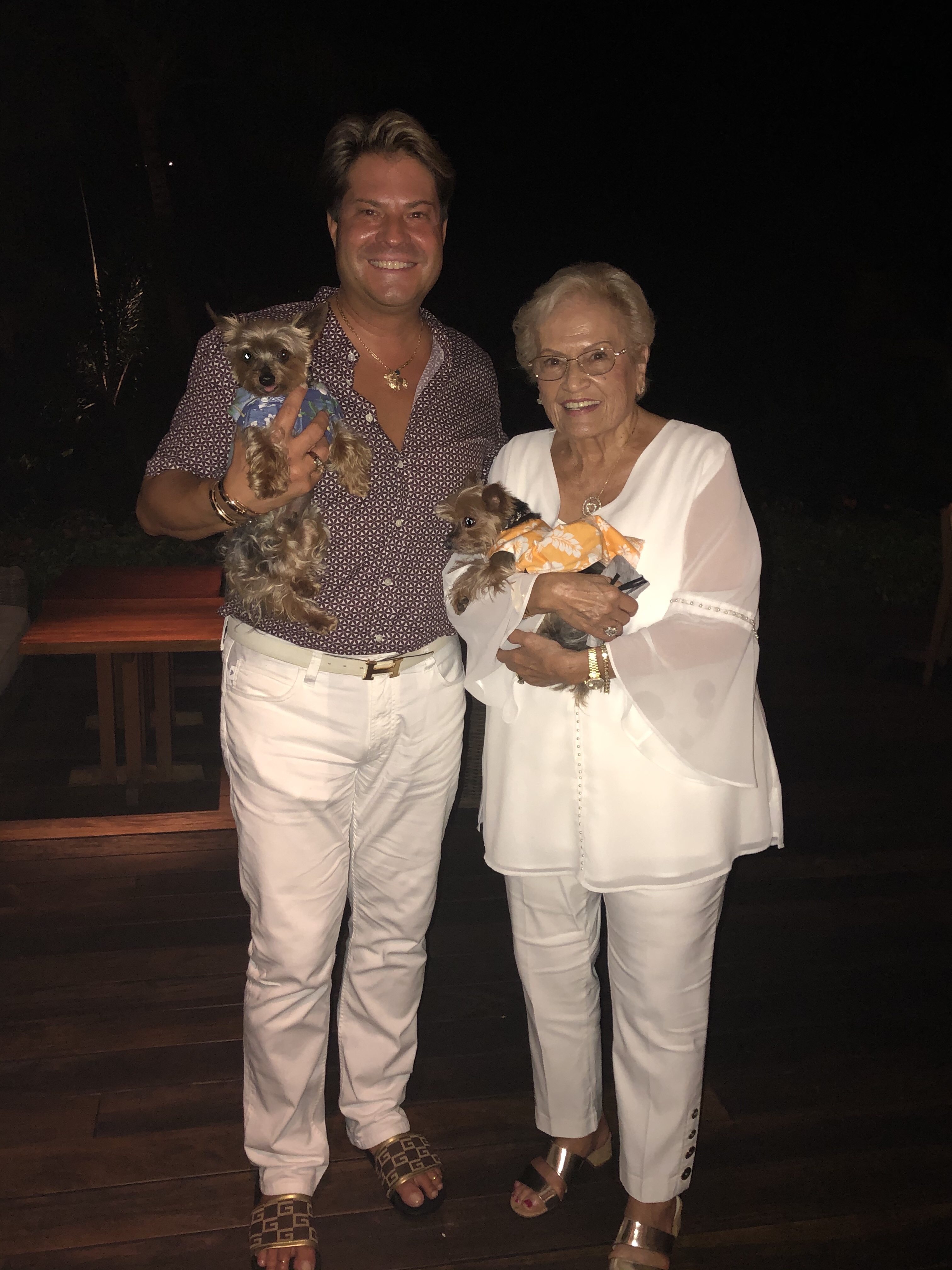


 MALIBU FARM
MALIBU FARM
Perched above Hulopoe Bay, this poolside restaurant specializes in fresh, organic and flavorful, locally sourced food, with most of the fruits and vegetables coming directly from their Malibu Farm Harvest Garden. We had lunch delivered from Malibu Farm to our beach setup where we enjoyed fish tacos on our lounge chairs shaded by umbrellas while being hypnotized by the sight and sound of the surf. 

ONE FORTY STEAKHOUSE
This was our favorite. If you’re looking for a hearty meal, ONE FORTY’s menu is filled with cuts of prime and Wagyu beef, as well as seasonal Hawaiian fish grilled to perfection, all complemented by traditional side dishes and an extensive wine list. The Maui Waipoli butter lettuce salad with dried mango, macadamia nuts, pears, and blue cheese crumbles was to die for. The melt-in-your-mouth filets are cooked to perfection and served on a butcher’s block with your choice of sauces. I chose tarragon Bearnaise and Mama G had the ONE FORTY signature steak sauce. Lobster mashed potatoes and the most perfectly grilled asparagus were our sides to share. We refused to share dessert, though, so I ordered chocolate soufflé and she had the macadamia nut sphere and pecan and dulce de leche tart with Guanaja dark chocolate sorbet. Her dessert was a work of art that the waiter topped off with freshly poured hot caramel fudge table side. 




THE BREAK
This open-air hangout is a combo of restaurant, bar, bakery and coffee shop, offering Hawaiian coffee and light breakfast items, salads, sandwiches and house-made gelato. As the day winds down, gather for sharing plates, local beer, wine and craft cocktails or end the evening with nightcaps and dessert. Guests can enjoy pool and other table games, relax with sports programs, or simply enjoy the view. I visited The Break in the mornings and afternoons for iced lattes with almond milk. They also have scrumptious fruit danish and chocolate croissant. Their peanut butter açaí bowl was ono (delicious). We even enjoyed a casual but delectable take out dinner from there on our final evening. We wanted to eat on our lanai and take advantage of the view. We enjoyed watching the setting sun change the white sand beach to a beautiful golden color before the twinkling stars came out to give us a light show. We shared Dakine salad (kale, shaved cabbage, carrots, quinoa, toasted pecans, mango, and avocado with lilikoi dressing) and Kauai shrimp fried rice with Portuguese sausage, Hawaiian peppers and scallions. For dessert we couldn’t say no to the lilikoi (passion fruit) cheesecake and the seven layer chocolate cake. We even made ourselves espresso and cappuccino in the room to accompany our sweets.



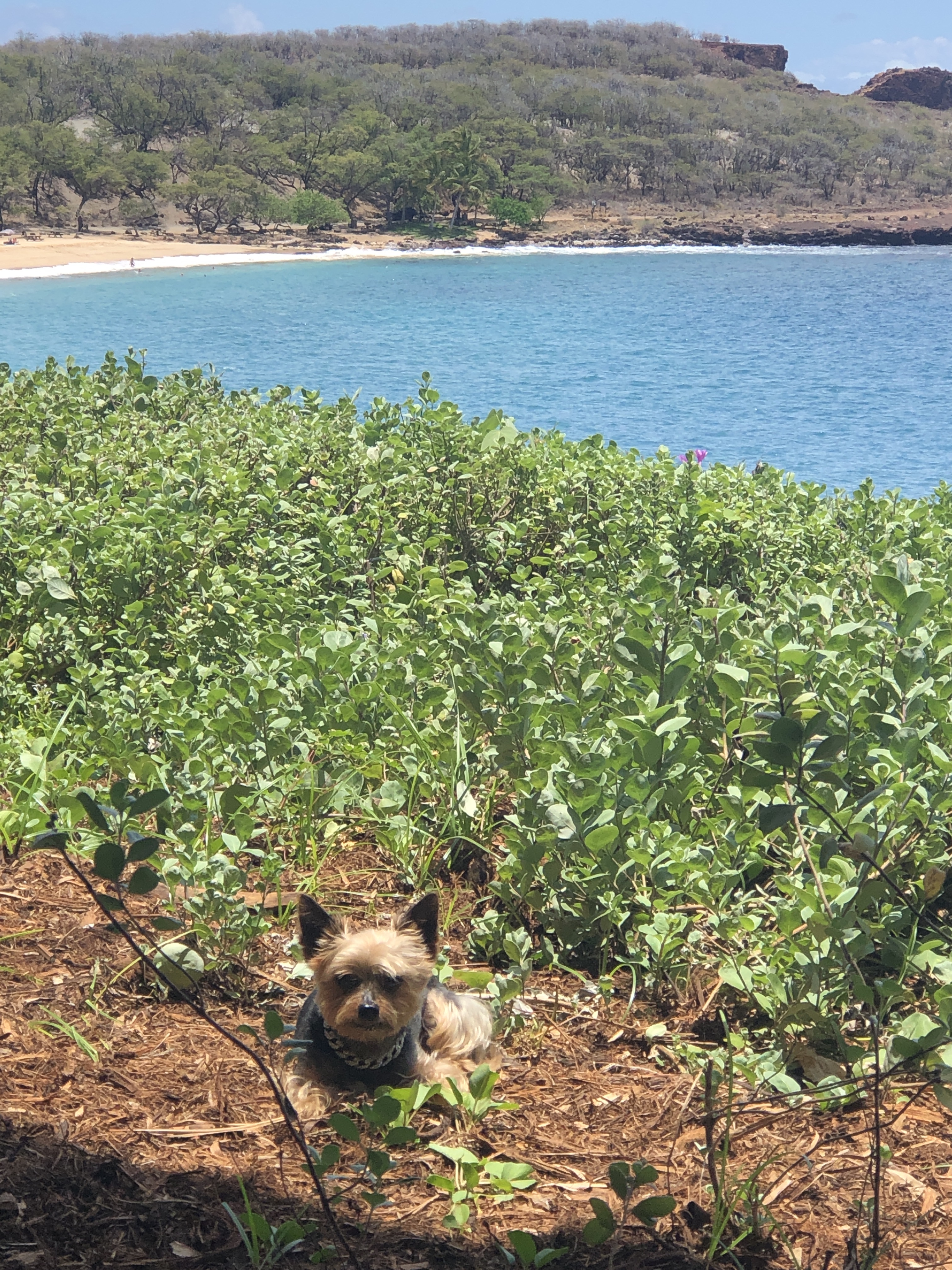


 VIEWS
VIEWS
The perfect spot for a post-golf lunch, Manele Golf Course’s aptly named restaurant offers 180-degree views of the Pacific Ocean and a delicious selection of salads, appetizers and wraps. Or skip the round altogether and relax over cocktails with one of the house-made, ice-cream sandwiches. Mama G has the oatmeal cookie with mango sorbet and I devoured a chocolate cookie with Kona coffee ice cream. We went there twice because the name says it all—the views are to die for! You feel as if you’ve ascended into heaven looking out over the turquoise waters with views of Maui and Kahoolawe behind Sweetheart Rock. And you can literally order a cheeseburger in paradise. The French fries are hot and crispy. Mama G had a BLT on one visit and Kalbi beef short ribs served in lettuce cups with local garnishes the second time.


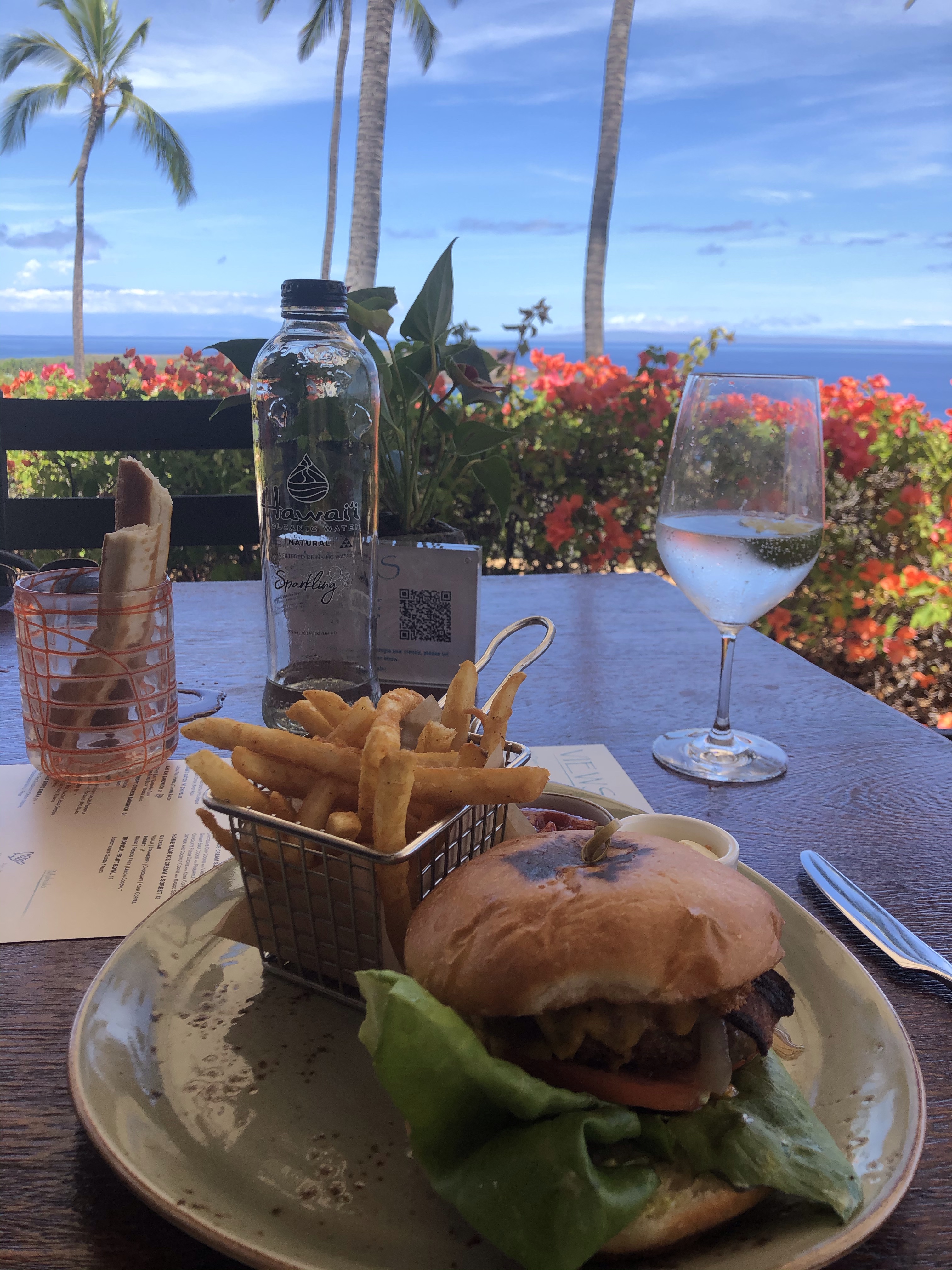


 Earlier this year, the Four Seasons Lana’i was named the No. 1 Best Hotel in the USA by U.S. News & World Report, the global authority in rankings and consumer advice. The 10th annual Best Hotels rankings evaluated more than 30,000 luxury properties across 400-plus destinations in the United States, Europe, Bermuda, Mexico, Canada and the Caribbean.
Earlier this year, the Four Seasons Lana’i was named the No. 1 Best Hotel in the USA by U.S. News & World Report, the global authority in rankings and consumer advice. The 10th annual Best Hotels rankings evaluated more than 30,000 luxury properties across 400-plus destinations in the United States, Europe, Bermuda, Mexico, Canada and the Caribbean.
Four Seasons Resort Lana’i received the the No. 1 ranking “because it impresses both experts and travelers with its countless amenities, ranging from sunset yoga to a world-class golf course, and encourages guests to explore the property’s idyllic setting.”
From our panoramic ocean front room, we could gaze across Hulopoe Bay and see the top of Puu Pehe, or Sweetheart Rock, a gorgeous spectacle, and the stuff that legends are made from, literally.
The folklore is a tale of two lovers, Pehe, a Hawaiian maiden from Lahaina and Makakehau, a young warrior from Lana’i who fell in love. Makakehau brought Pehe to Lana’i and hid her in the sea caves under Manele’s cliffs, only to discover one day that the sea had claimed her life. Makakehau, Maka (eyes) Kehau (mist) was so stricken with grief that he leaped 80 feet to his death. Legend holds that his (misty) tears are the spray when the waves crash.
Be sure to take the 15- to 20-minute hike along the cliffs just southeast of the tide pools to view the Lana’i landmark, Puu Pehe up close. Hike up the path along the rocky cliffs and you’ll soon overlook the iconic Sweetheart Rock that rises majestically 80 feet out of the water. It’s breathtaking!


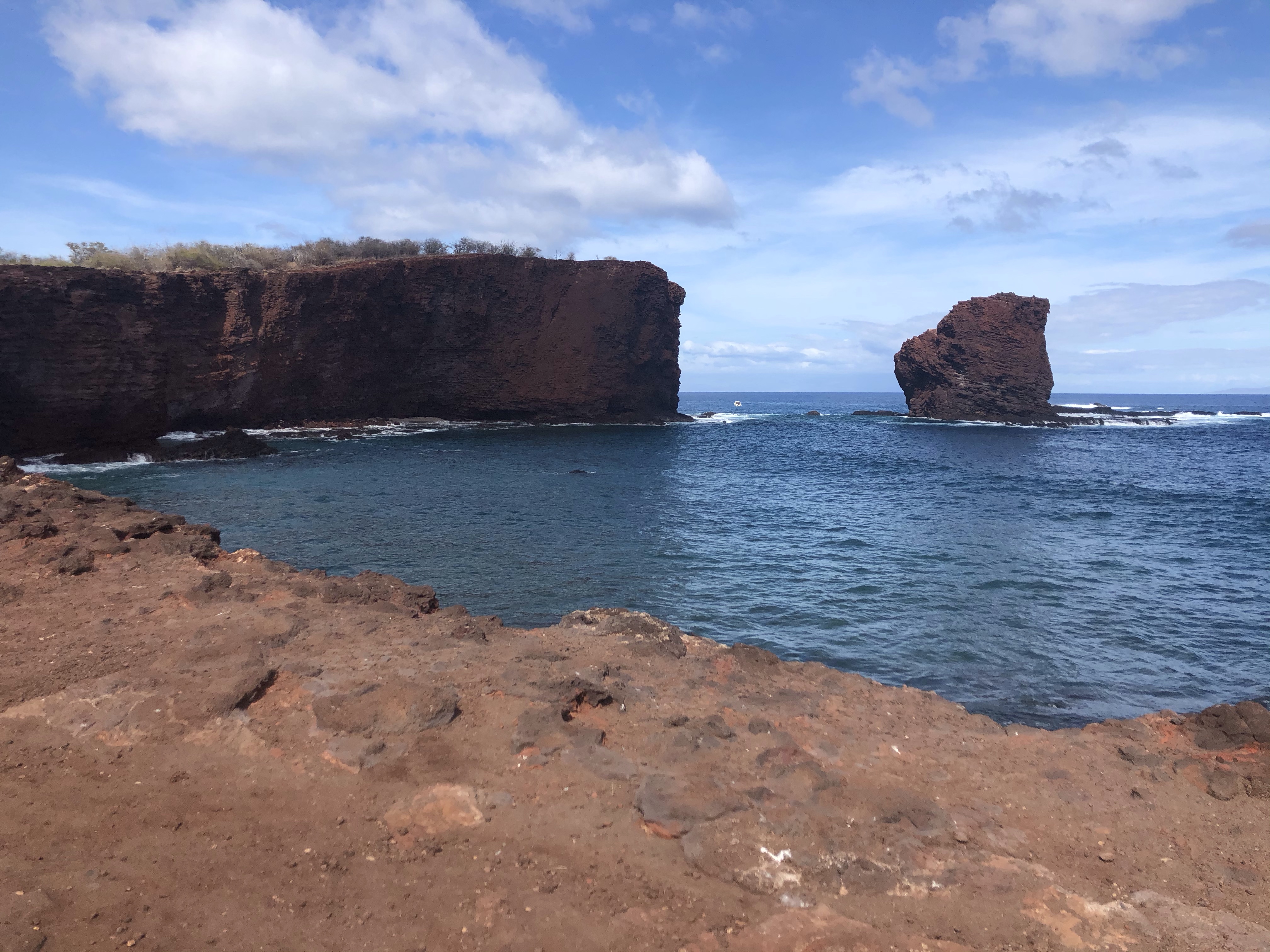


 Fronting the Four Seasons Resort Lana’i and named one of America’s best beaches, Hulopoe Beach is the best spot on the island for snorkeling and swimming. Located on Lanai’s southern coast, Hulopoe Bay greets you with a stunning expanse of pearl-white sand and crystal blue waters. We could even see a blow hole from our lanai.
Fronting the Four Seasons Resort Lana’i and named one of America’s best beaches, Hulopoe Beach is the best spot on the island for snorkeling and swimming. Located on Lanai’s southern coast, Hulopoe Bay greets you with a stunning expanse of pearl-white sand and crystal blue waters. We could even see a blow hole from our lanai.
One of the highlights of Hulopoe Bay is its large tide pools located at the eastern side of the bay. Carved out of volcanic rock, these tide pools are well protected, keeping the waters calm for exploring. Tide pools are created when rocky shores are covered and then exposed by the fluctuating tide.
We thoroughly enjoyed a relaxing day at the beach. Since Mama G can’t walk long distances, the accommodating resort staff arranged to drive us down to the beach park in one of the resort’s Tesla’s. The beach attendants set us up in a prime spot with beach umbrellas, lounge chairs and fluffy white resort towels where we could stare out at the azure waters and doze off listening to the waves breaking on the shore. I brought along our Bose speaker and played Hawaiian music for us to enjoy. Not a bad way to spend a day relaxing.
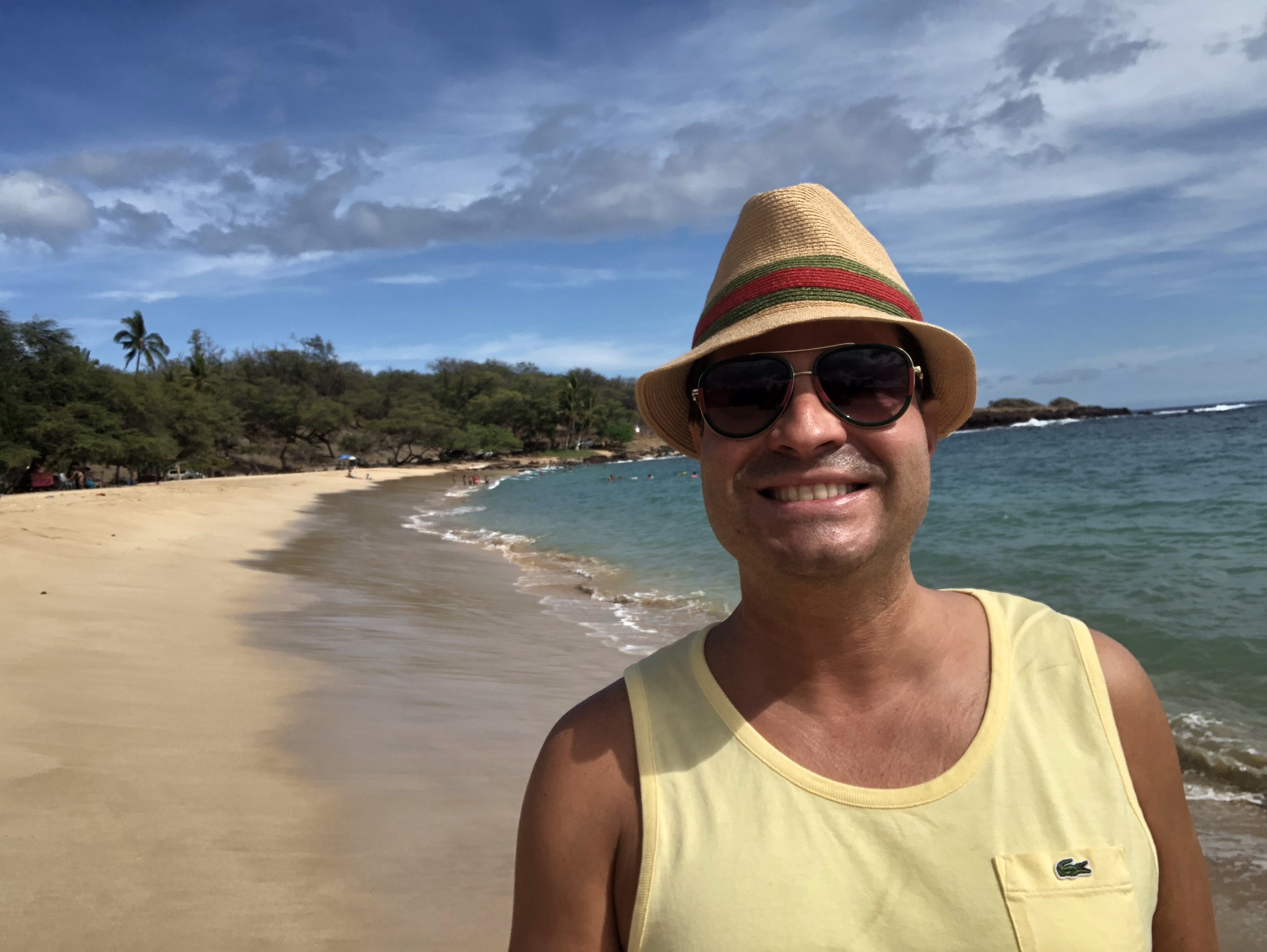


 In fact, we could have spent the entire time lounging at the resort, but we rented a Jeep for a day and set out on an adventure far away from the comforts of our temporary home to explore new territory. Passing through Lana’i City, we headed toward Shipwreck Beach.
In fact, we could have spent the entire time lounging at the resort, but we rented a Jeep for a day and set out on an adventure far away from the comforts of our temporary home to explore new territory. Passing through Lana’i City, we headed toward Shipwreck Beach.
Strong trade winds and big channel swells have made the north shore of Lana’i a hazardous area for navigation, evidenced by the ships that have wrecked along its six mile coastline known as Shipwreck Beach. There are at least a dozen vessels known to have been accidentally, and sometimes intentionally, grounded here, from barges and steamships to schooners, and, for this reason, it has become a popular spot for beachcombing, hiking, and photographing its large wrecks.
Lucky for us, we could see the largest of the wrecked ships from the road high above where we also took in majestic views of Molokai and Maui on our way over the mountain. The aerial photo below is courtesy of the Hawai’i Tourism Authority. When you wind your way to the bottom of the mountain, there is a fork in the road where the pavement ends and a sign points toward Shipwreck Beach to the left. Then you drive onto a sand road.


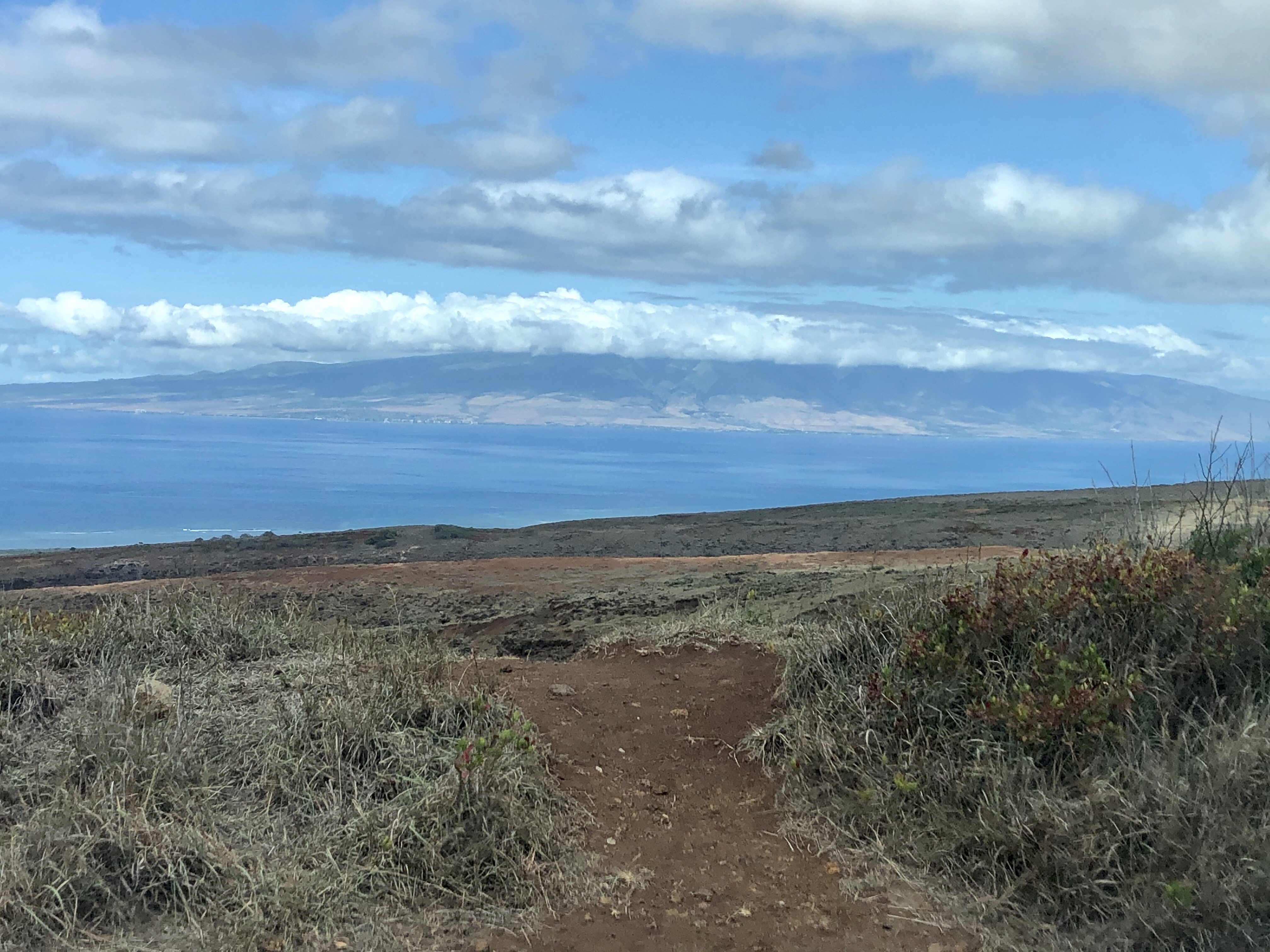
 On the sand road, we went down into a dip and never came back up. I tried to shift to 4-wheel drive but it wouldn’t work. Then we went back and forth between reverse and drive, kicking up sand and promptly digging ourselves so far into the ground that sand was practically coming in through the doors, and the axle was almost buried in the earth.
On the sand road, we went down into a dip and never came back up. I tried to shift to 4-wheel drive but it wouldn’t work. Then we went back and forth between reverse and drive, kicking up sand and promptly digging ourselves so far into the ground that sand was practically coming in through the doors, and the axle was almost buried in the earth.
 To make matters more alarming, I couldn’t get cell phone service. Thankfully Mama G was able to call roadside assistance, which costs $500. At this point I thought it was my fault we were stuck so I was prepared to pay the outrageous bill just to get us out of there. We lost time (about an hour and a half) waiting for roadside assistance but met a lovely local couple, James Truman and Carol DeShay-Truman, who came along and offered to assist us.
To make matters more alarming, I couldn’t get cell phone service. Thankfully Mama G was able to call roadside assistance, which costs $500. At this point I thought it was my fault we were stuck so I was prepared to pay the outrageous bill just to get us out of there. We lost time (about an hour and a half) waiting for roadside assistance but met a lovely local couple, James Truman and Carol DeShay-Truman, who came along and offered to assist us.
Mr. Truman said, “I should be able to get you out of there.” He gave it a try but upon exiting the Jeep, he said, “The 4-wheel drive isn’t working.” His diagnostic report made me feel more at ease realizing that it wasn’t my fault we were stuck. Subsequently, the resort manager agreed and removed the roadside assistance fee from our bill.
Once they brought us a new Jeep, all we could see was dust in the rear-view mirror as we were trying to make up for lost time. We made it back to Lana’i City where you turn right at the Lana’i Ranch stables and enter a narrow red dirt road covering a vast space of hills. You feel like you are on Mars as you bounce your way to Keahikawelo.
Also known as Garden of the Gods, it’s a visual wonder uniquely characterized by boulders of varying sizes, shapes and colors. Its appearance is simply unmatched in all the Hawaiian islands, and you won’t have to be a geology buff to appreciate the dramatic formations that litter the landscape.
Science will tell you that these formations are the result of thousands of years of erosion that created pinnacles and buttes in one remote canyon area. Just one look, however, and you’ll wonder whether each rock has been placed for some divine purpose.


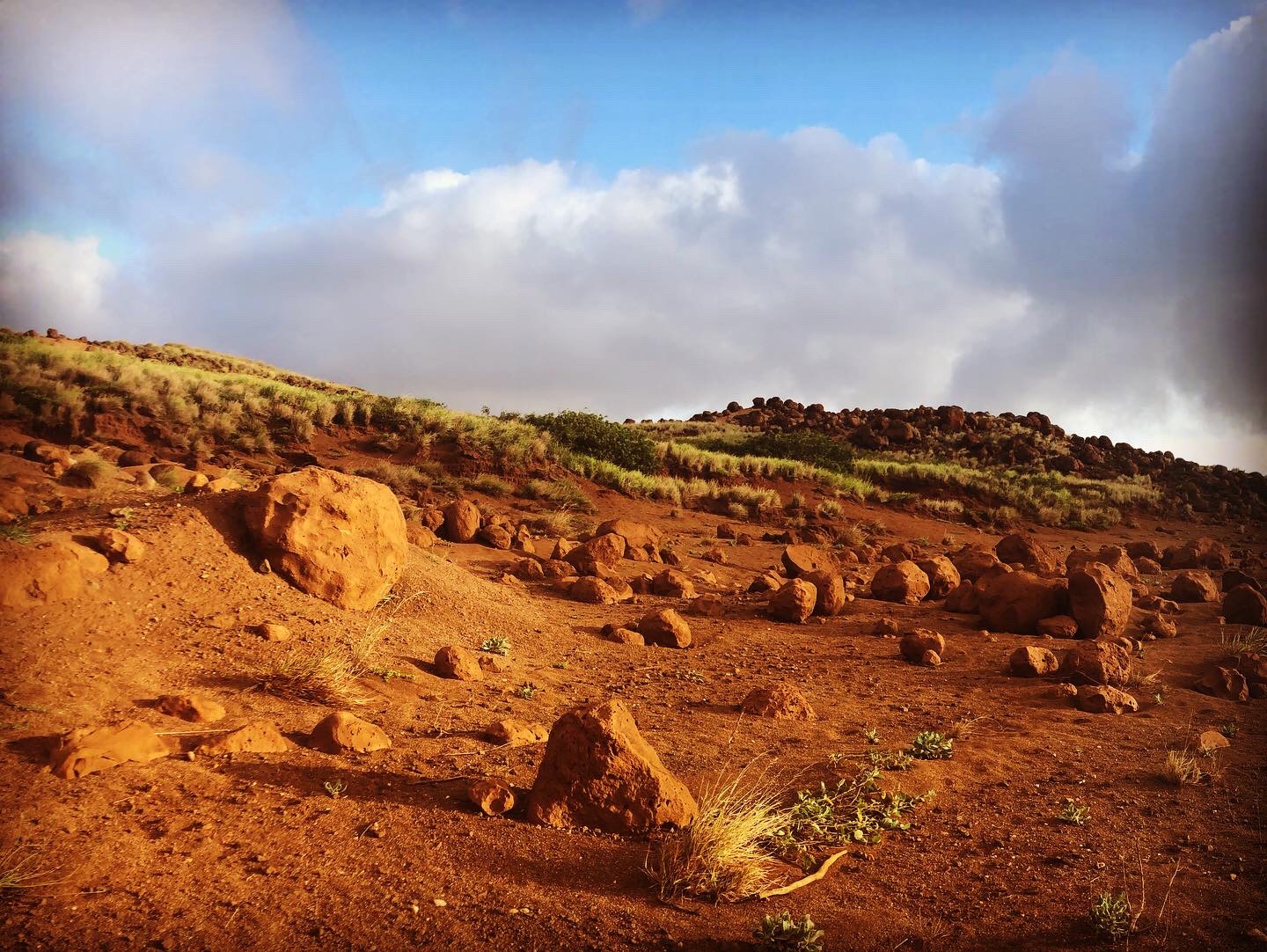
 Before dinner, we drove to Kaumalapau Harbor, located on the southwestern coast and the main commercial seaport for Lana’i. The original harbor breakwater was built in the 1920s by James Dole, the founder of the Hawaiian Pineapple Company. After years of hurricanes severely damaging the harbor, the U.S. Army Corps of Engineers constructed a new breakwater. The project was dedicated on July 7, 2007 and now Kaumalapau Harbor has a one of a kind look with a $28.2 million price tag. Buttressed by 819 white 35-ton Core-Loc armor units — the largest of their kind in the world — the harbor appears to be surrounded by giant, jack-like concrete blocks. The aerial photo below is courtesy of the U.S. Army Corps of Engineers.
Before dinner, we drove to Kaumalapau Harbor, located on the southwestern coast and the main commercial seaport for Lana’i. The original harbor breakwater was built in the 1920s by James Dole, the founder of the Hawaiian Pineapple Company. After years of hurricanes severely damaging the harbor, the U.S. Army Corps of Engineers constructed a new breakwater. The project was dedicated on July 7, 2007 and now Kaumalapau Harbor has a one of a kind look with a $28.2 million price tag. Buttressed by 819 white 35-ton Core-Loc armor units — the largest of their kind in the world — the harbor appears to be surrounded by giant, jack-like concrete blocks. The aerial photo below is courtesy of the U.S. Army Corps of Engineers.
At Kaumalapau Harbor, you can perch yourself atop a stone wall alongside local fishermen and women and treat yourself to a magical sunset. This is one of the best and most accessible spots on the island to get an unobstructed view of the sunset. The drive to Kaumalapau Harbor is also quite scenic, giving you distant views of western Lanai’s dramatic sea cliffs, which are quite breathtaking, especially at sunset.

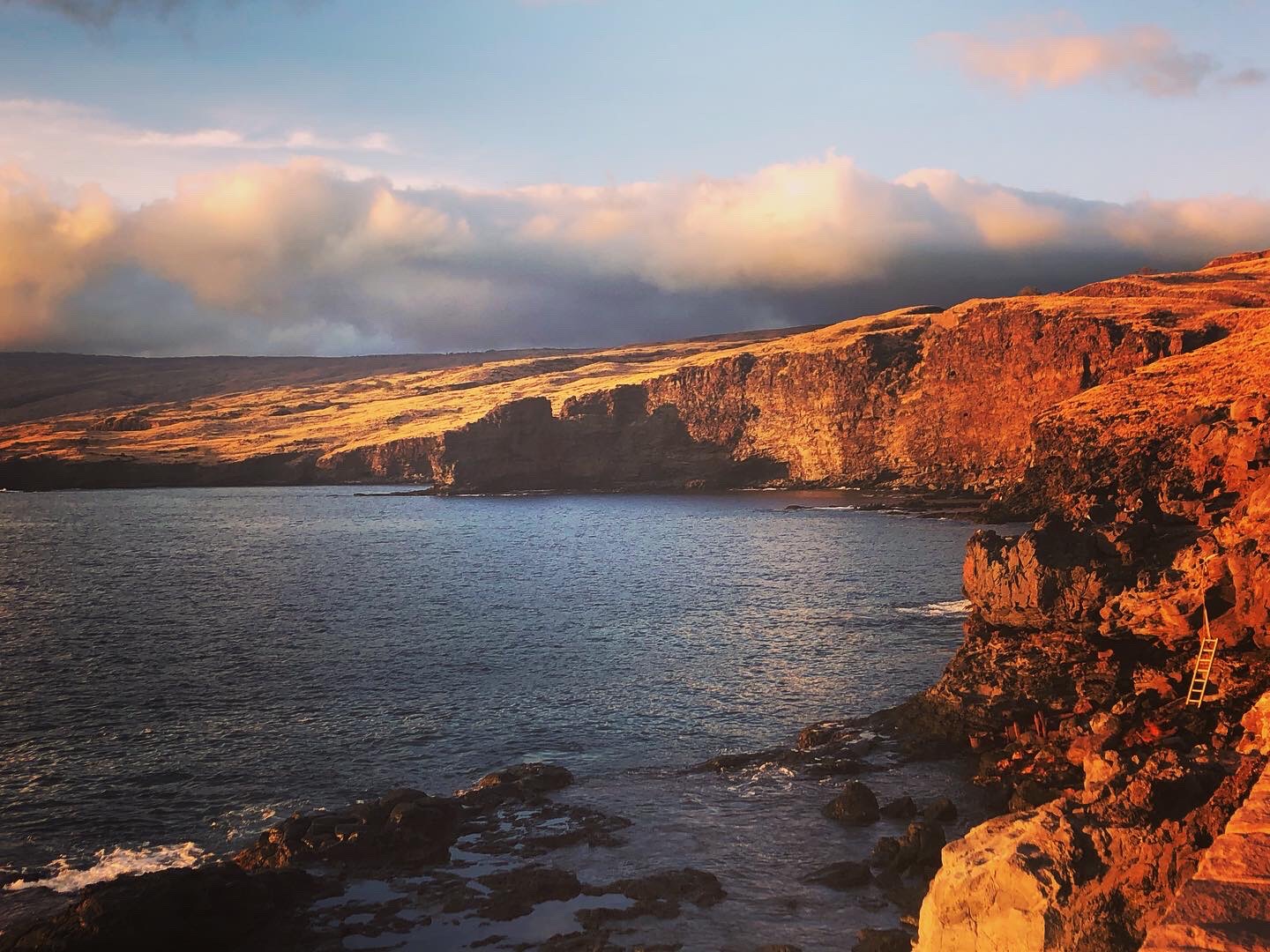
 For dinner that night we went back to town and dined al fresco at Lana’i City Bar & Grille, part of the Hotel Lana’i. Comfortable and elegant, the bar and dining area recall Hotel Lanai’s plantation history with rustic, vintage charm and warm Hawaiian hospitality. Head to the open-air lanai to enjoy an evening dining under the stars among towering Cook pine trees, often with live local entertainment. We endured the sprinkles of a passing shower but were quite pleased overall with the ambience, service and food. Mama G raved about the pulled pork sandwich. Be sure to ask for the baked-to-order cookie skillet, which is a chocolate chip cookie featuring both milk and white chocolate chips, baked in a small cast iron skillet and topped with vanilla ice cream.
For dinner that night we went back to town and dined al fresco at Lana’i City Bar & Grille, part of the Hotel Lana’i. Comfortable and elegant, the bar and dining area recall Hotel Lanai’s plantation history with rustic, vintage charm and warm Hawaiian hospitality. Head to the open-air lanai to enjoy an evening dining under the stars among towering Cook pine trees, often with live local entertainment. We endured the sprinkles of a passing shower but were quite pleased overall with the ambience, service and food. Mama G raved about the pulled pork sandwich. Be sure to ask for the baked-to-order cookie skillet, which is a chocolate chip cookie featuring both milk and white chocolate chips, baked in a small cast iron skillet and topped with vanilla ice cream.
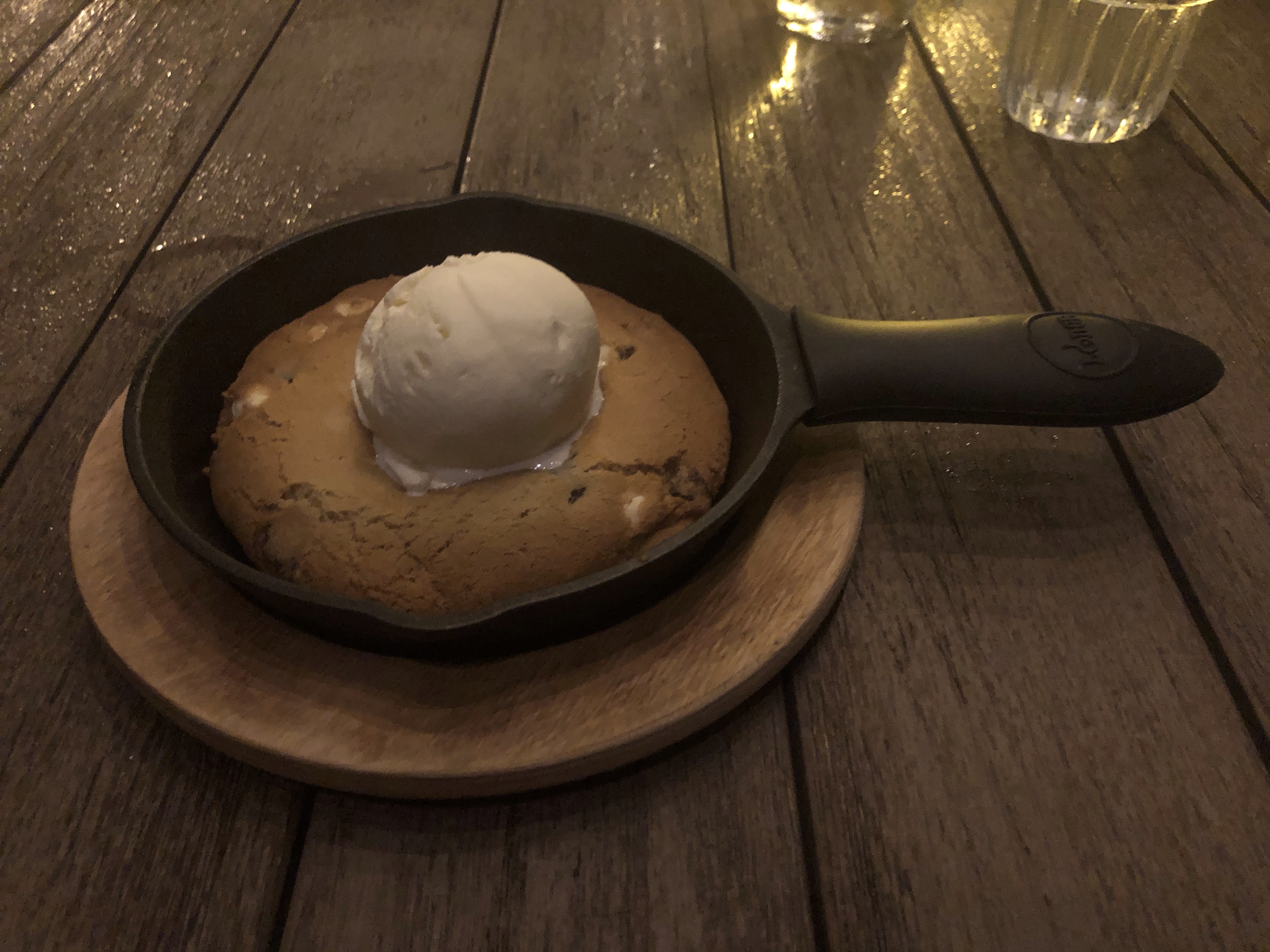 In Lana’i City, we stopped at the service station in this tiny town because when Mama G asked someone if there’s anywhere to shop, they replied, “You can buy T-shirts at the gas staton.” It felt like we were on Green Acres going to town, excited to visit the general store. Not only is there a small population, there is no traffic. In fact, there is not a single traffic light on the entire island of Lana’i.
In Lana’i City, we stopped at the service station in this tiny town because when Mama G asked someone if there’s anywhere to shop, they replied, “You can buy T-shirts at the gas staton.” It felt like we were on Green Acres going to town, excited to visit the general store. Not only is there a small population, there is no traffic. In fact, there is not a single traffic light on the entire island of Lana’i.
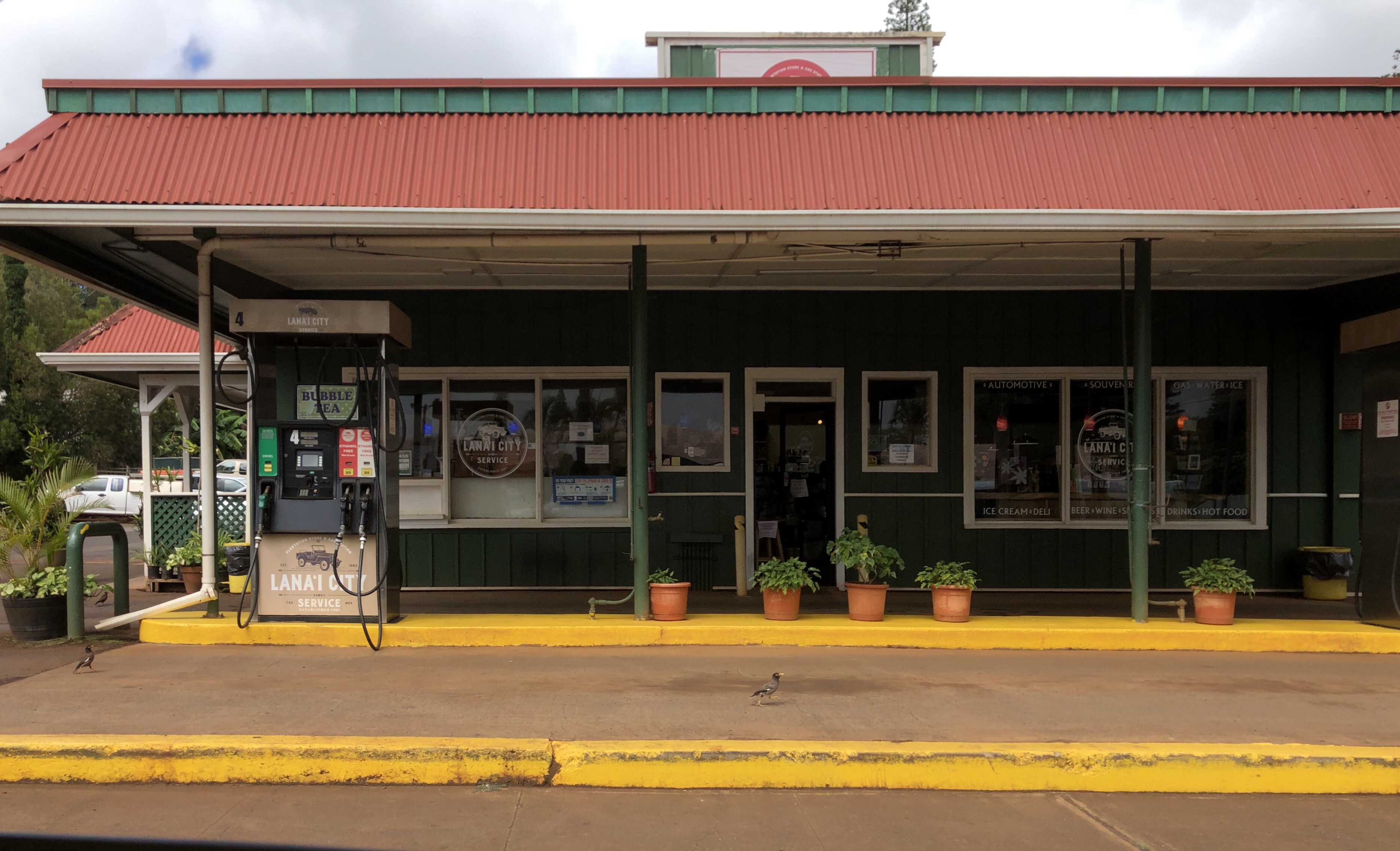 Another evening, we visited the Four Seasons’ sister property Sensei Lana’i. A shuttle took us from the beach resort to the lodge and a chauffeured Tesla returned us after we enjoyed dining at the extravagant Sensei by NOBU.
Another evening, we visited the Four Seasons’ sister property Sensei Lana’i. A shuttle took us from the beach resort to the lodge and a chauffeured Tesla returned us after we enjoyed dining at the extravagant Sensei by NOBU.
Light and airy in whites and creams with glossy wood floors and formal touches like wainscoting, the Sensei Lodge reminds me exactly of what I think the inside of Oprah’s house on Maui must look like. We were ready to move in and perch in front of either of the two fireplaces anchoring the vast lobby, adding a touch of warmth. Mama G was enthralled with the green anthurium arrangements that were artfully displayed as the centerpiece of the lobby. It looked like a creation by celebrity florist, Jeff Leatham, known for his impressive floral installations at the Four Seasons George V in Paris.

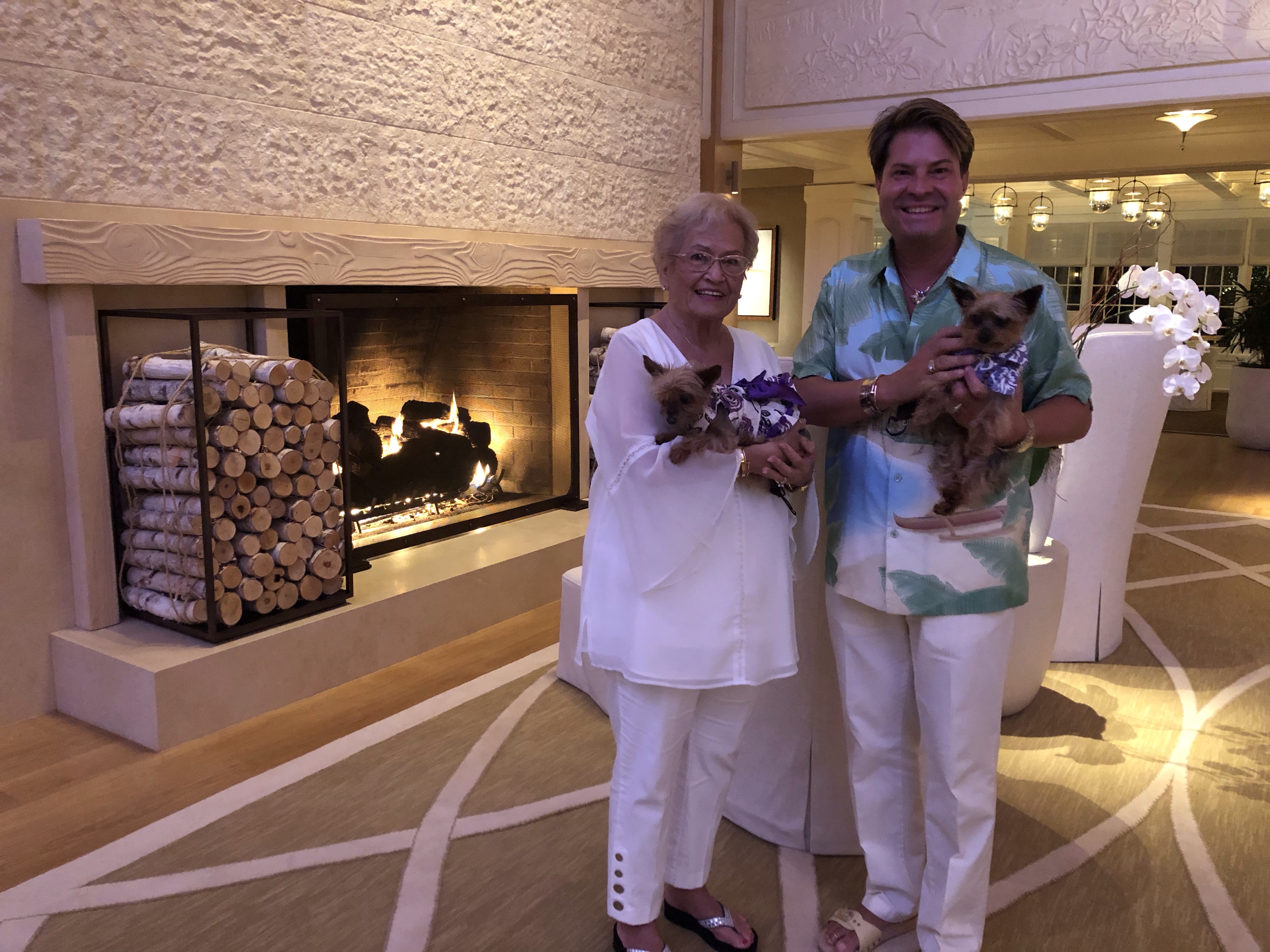


 The Sensei by NOBU restaurant offers a menu with health conscious choices since it’s a wellness retreat. Guests can dine morning, noon and night surrounded by the beauty of nature. A glass pavilion sits upon a reflecting pond, offering indoor and outdoor tables. A 16-seat communal table, welcoming you to gather with friends old and new, is temporarily closed, a victim of social distancing. There were a handful of other tables occupied and scattered around the large, spacious dining room.
The Sensei by NOBU restaurant offers a menu with health conscious choices since it’s a wellness retreat. Guests can dine morning, noon and night surrounded by the beauty of nature. A glass pavilion sits upon a reflecting pond, offering indoor and outdoor tables. A 16-seat communal table, welcoming you to gather with friends old and new, is temporarily closed, a victim of social distancing. There were a handful of other tables occupied and scattered around the large, spacious dining room.
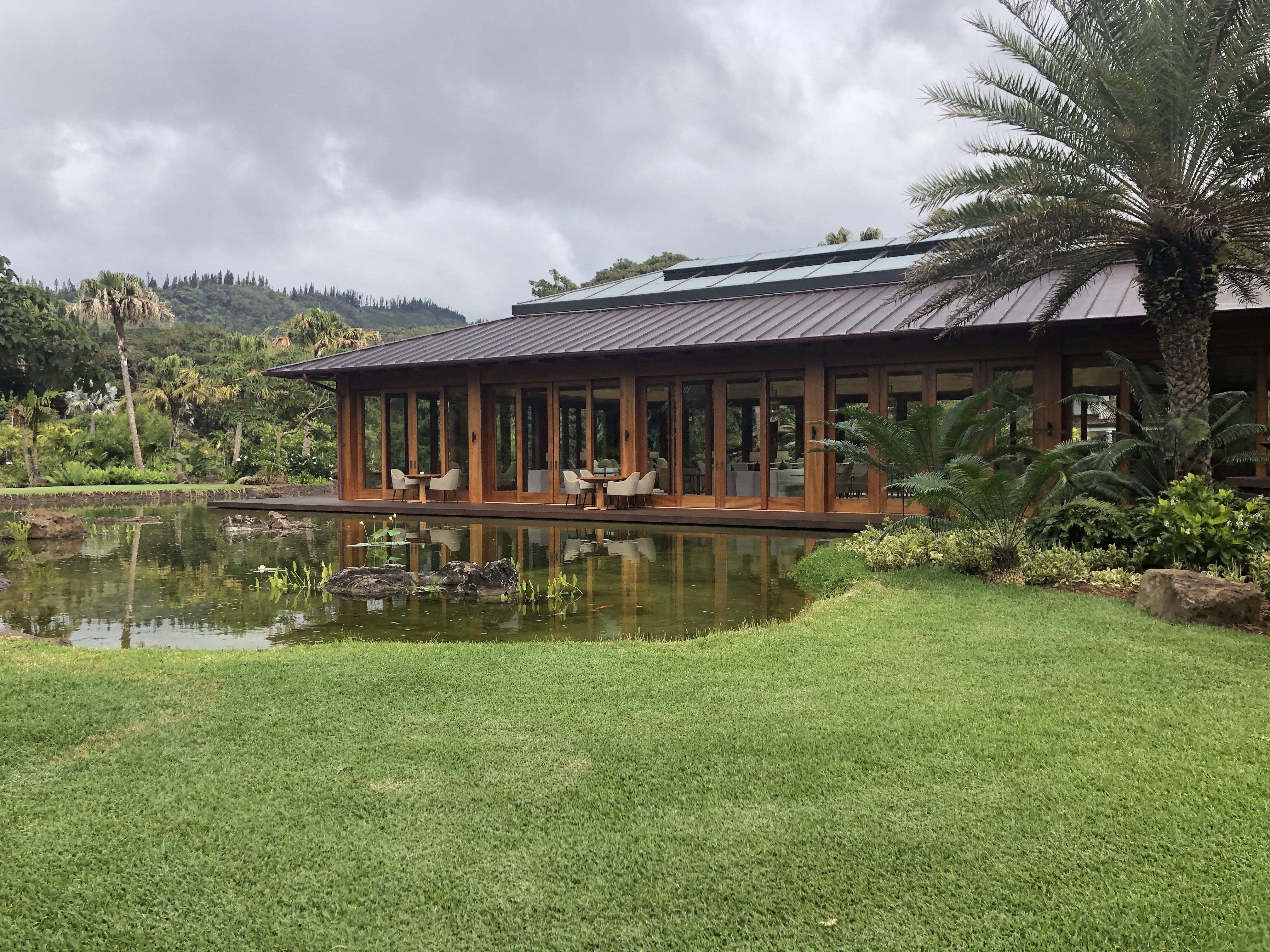 Chef Nobu Matsuhisa has long been at the forefront of innovative cuisine grounded in Japanese sensibilities and clean ingredients. Guests of Four Seasons will enjoy a wellness menu created by Chef Nobu and his team in close collaboration with Sensei’s nutritionists. On the Sensei by NOBU menu are such favorites as the world-renowned black cod with miso, as well as a new selection inspired by the bounty of the steps-away Sensei Farm Lana’i, and the neighboring islands and waters of Hawai’i.
Chef Nobu Matsuhisa has long been at the forefront of innovative cuisine grounded in Japanese sensibilities and clean ingredients. Guests of Four Seasons will enjoy a wellness menu created by Chef Nobu and his team in close collaboration with Sensei’s nutritionists. On the Sensei by NOBU menu are such favorites as the world-renowned black cod with miso, as well as a new selection inspired by the bounty of the steps-away Sensei Farm Lana’i, and the neighboring islands and waters of Hawai’i.
We split the signature black cod for a starter and had two salad choices, a Greek and a spicy shrimp with quinoa. Both salads featured local tomatoes with vibrant flavors. The shrimp was so spicy that my mouth was on fire. We both opted for the Wagyu strip steak entree complemented with a side of exotic mushrooms and ube (Japanese purple sweet potato). A coffee hazelnut mille-feuille accompanied by bitter chocolate sorbet finished the evening. Mille-feuille is a rich French dessert consisting of many layers of thin pastry with cream fillings.
 To work off some calories and take in the unique natural beauty of Lana’i, I went horseback riding at Lana’i Ranch at Koele, across the street from the Four Seasons Sensei Lodge. I rode through the fog and into the hills surrounding Koele – once the center of ranching operations on the island – and explored the lush woodlands, home to axis deer and wild turkey.
To work off some calories and take in the unique natural beauty of Lana’i, I went horseback riding at Lana’i Ranch at Koele, across the street from the Four Seasons Sensei Lodge. I rode through the fog and into the hills surrounding Koele – once the center of ranching operations on the island – and explored the lush woodlands, home to axis deer and wild turkey.
I talked story with my wrangler, Molly, passing through Ironwood forests to breathtaking vistas of neighbor islands. An assortment of trails meander through the wooded peaks and valleys of this extraordinary upland terrain, so riders of all ages and skill levels can saddle up.




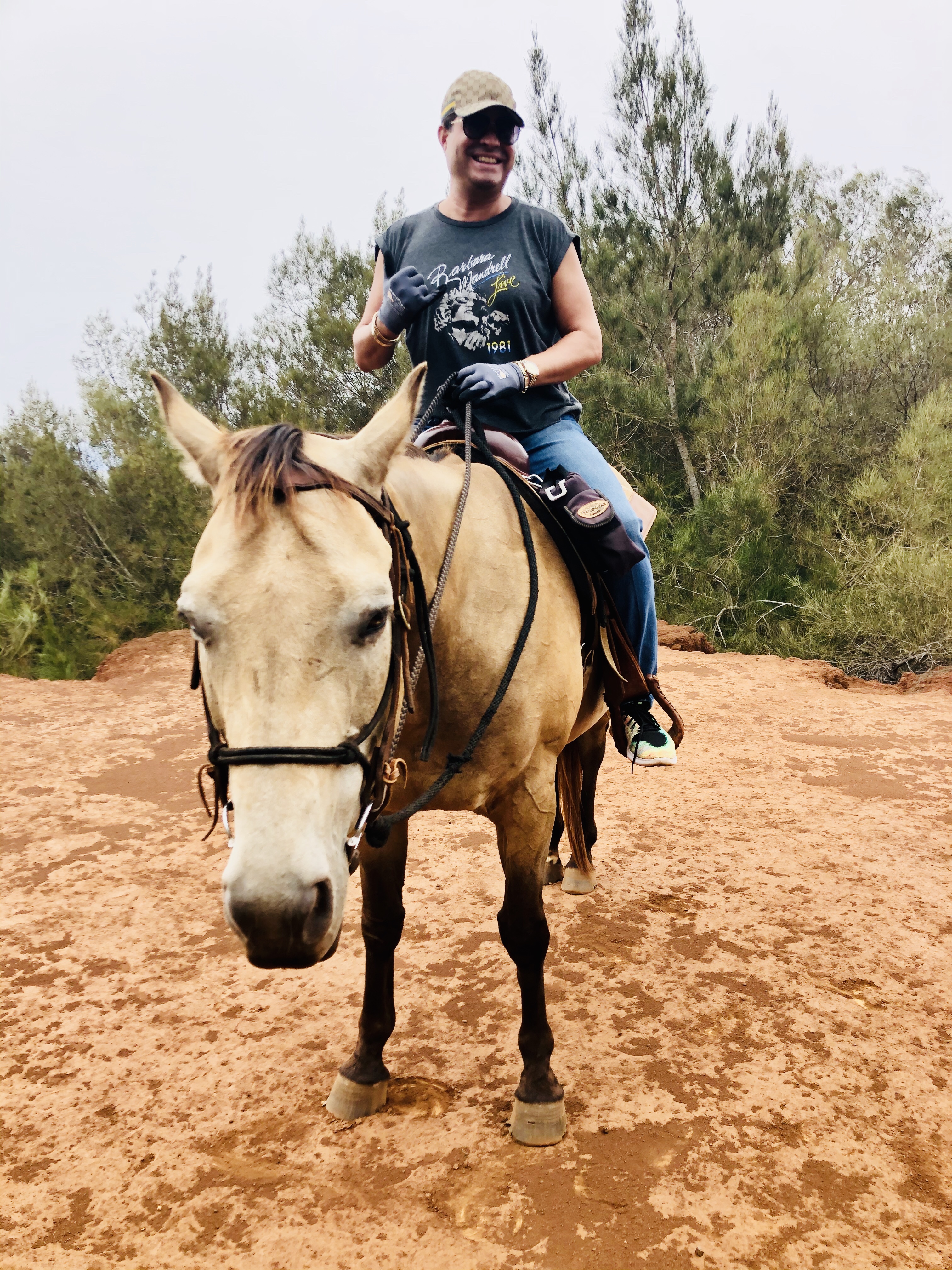 Back at the stables, I told Alexis, one of the ranch hands, that I love goats. She said, “All you have to do is yell, ‘Goats, Goats, Goats!’ and they come running!” I thought she was kidding me until she hollered, “Goats! Goats! Goats!” and sure enough a herd of goats came running at me so fast that if the fence hadn’t been between us, they’d have stampeded me. What a joyful delight! She even let me feed the Tita (female bully) of the pack.
Back at the stables, I told Alexis, one of the ranch hands, that I love goats. She said, “All you have to do is yell, ‘Goats, Goats, Goats!’ and they come running!” I thought she was kidding me until she hollered, “Goats! Goats! Goats!” and sure enough a herd of goats came running at me so fast that if the fence hadn’t been between us, they’d have stampeded me. What a joyful delight! She even let me feed the Tita (female bully) of the pack.


 On our last day, Bradley, the Four Seasons beach resort manager, arranged for us to have a late check-out as well as a private driver in a Tesla to take us up to the top of the mountain for one last lunch in heaven at The Views restaurant at the Manele Golf Course. Following lunch, our driver escorted us to Sensei Lodge where we were treated to a private tour, led by Luis, the Sensei manager, himself. He drove us around on a state of the art golf cart to inspect the breathtaking gardens up close. We were in awe of the natural beauty and took turns guessing at the amount of manpower and hours required to maintain the immaculate grandeur. There are separate hales (houses) for spa treatments and wellness classes. There are huge ponds and outdoor sculptures. Flora and fauna from all around the world rival any botanical gardens’ collection.
On our last day, Bradley, the Four Seasons beach resort manager, arranged for us to have a late check-out as well as a private driver in a Tesla to take us up to the top of the mountain for one last lunch in heaven at The Views restaurant at the Manele Golf Course. Following lunch, our driver escorted us to Sensei Lodge where we were treated to a private tour, led by Luis, the Sensei manager, himself. He drove us around on a state of the art golf cart to inspect the breathtaking gardens up close. We were in awe of the natural beauty and took turns guessing at the amount of manpower and hours required to maintain the immaculate grandeur. There are separate hales (houses) for spa treatments and wellness classes. There are huge ponds and outdoor sculptures. Flora and fauna from all around the world rival any botanical gardens’ collection.

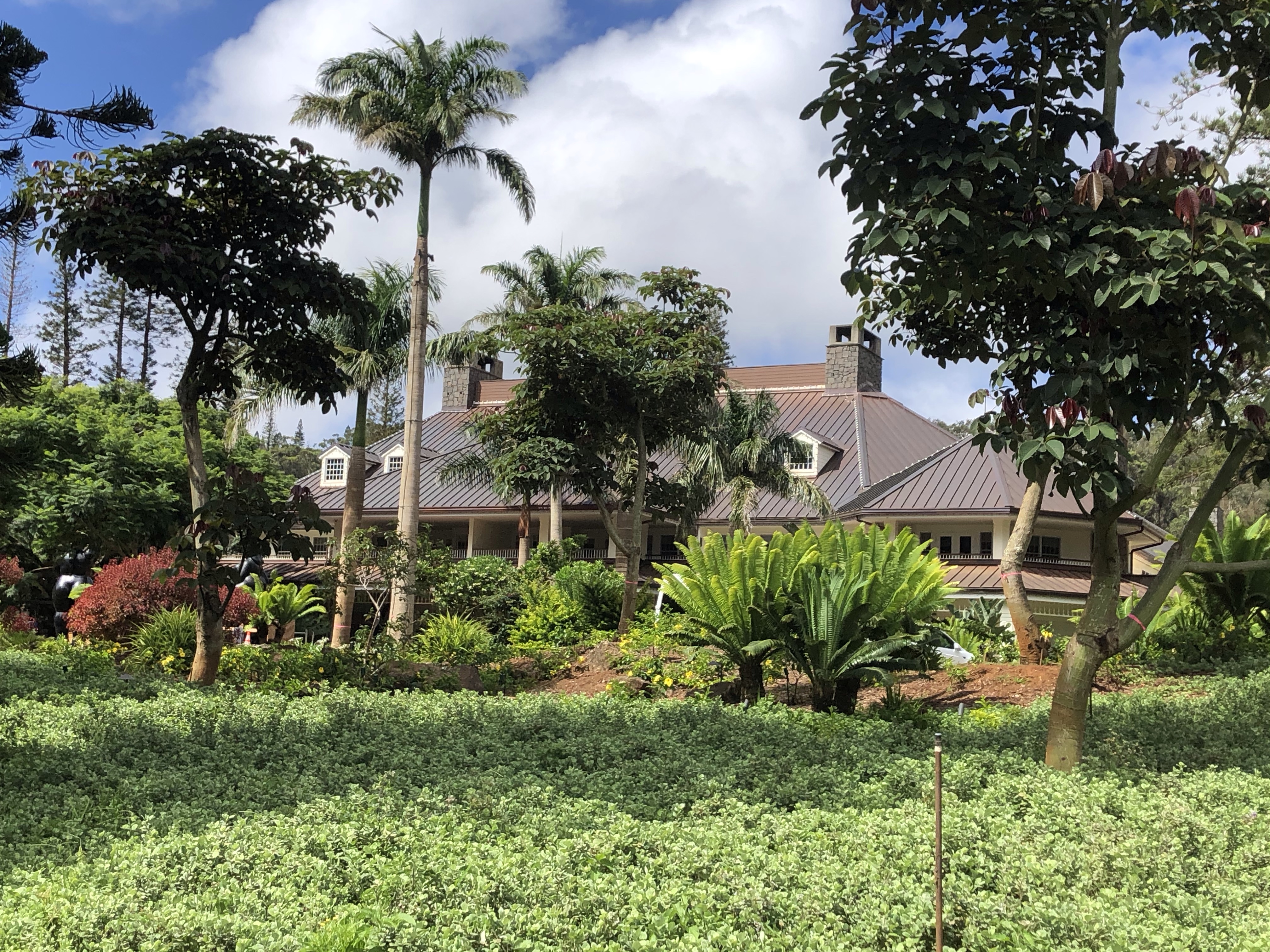


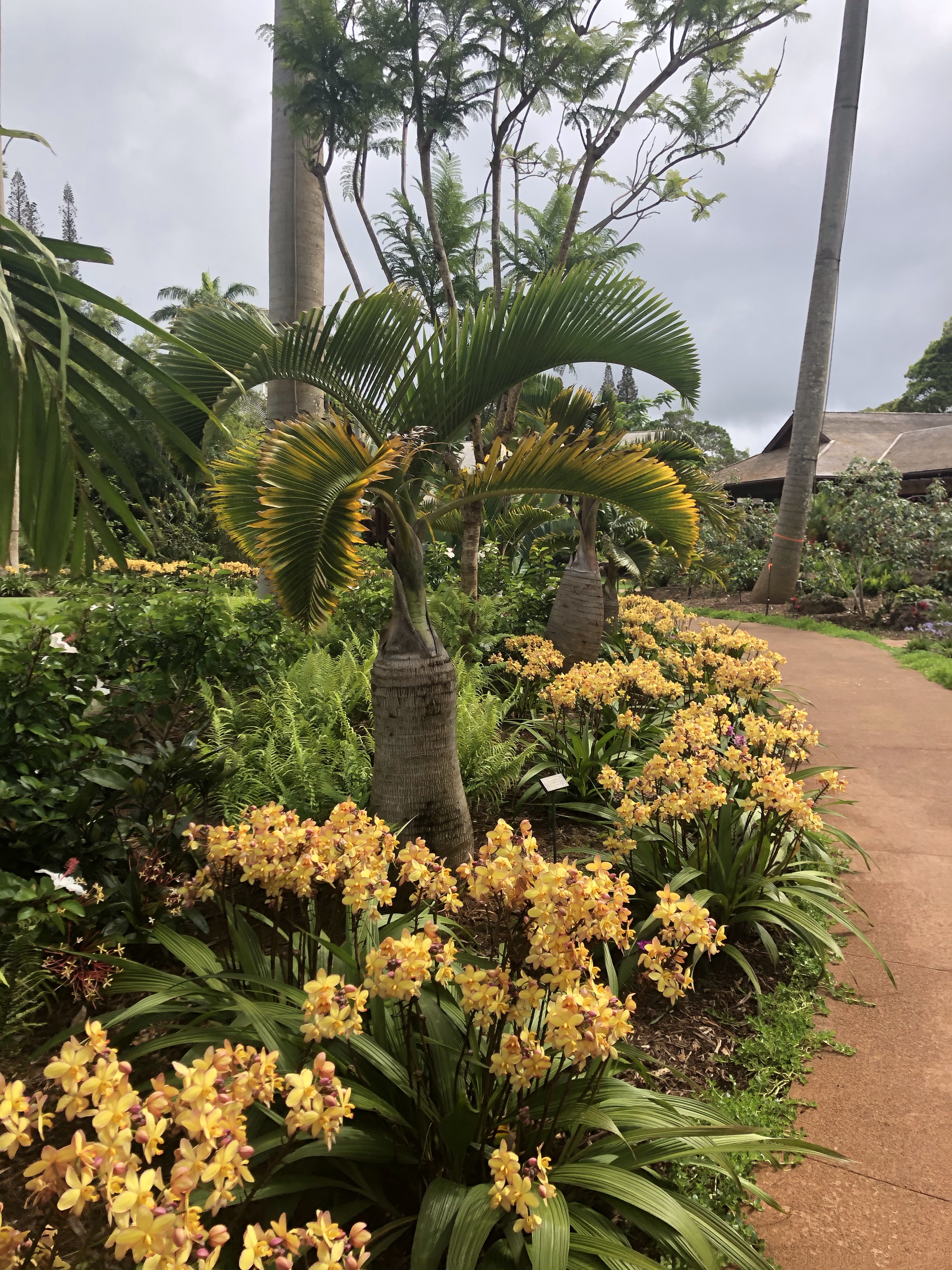
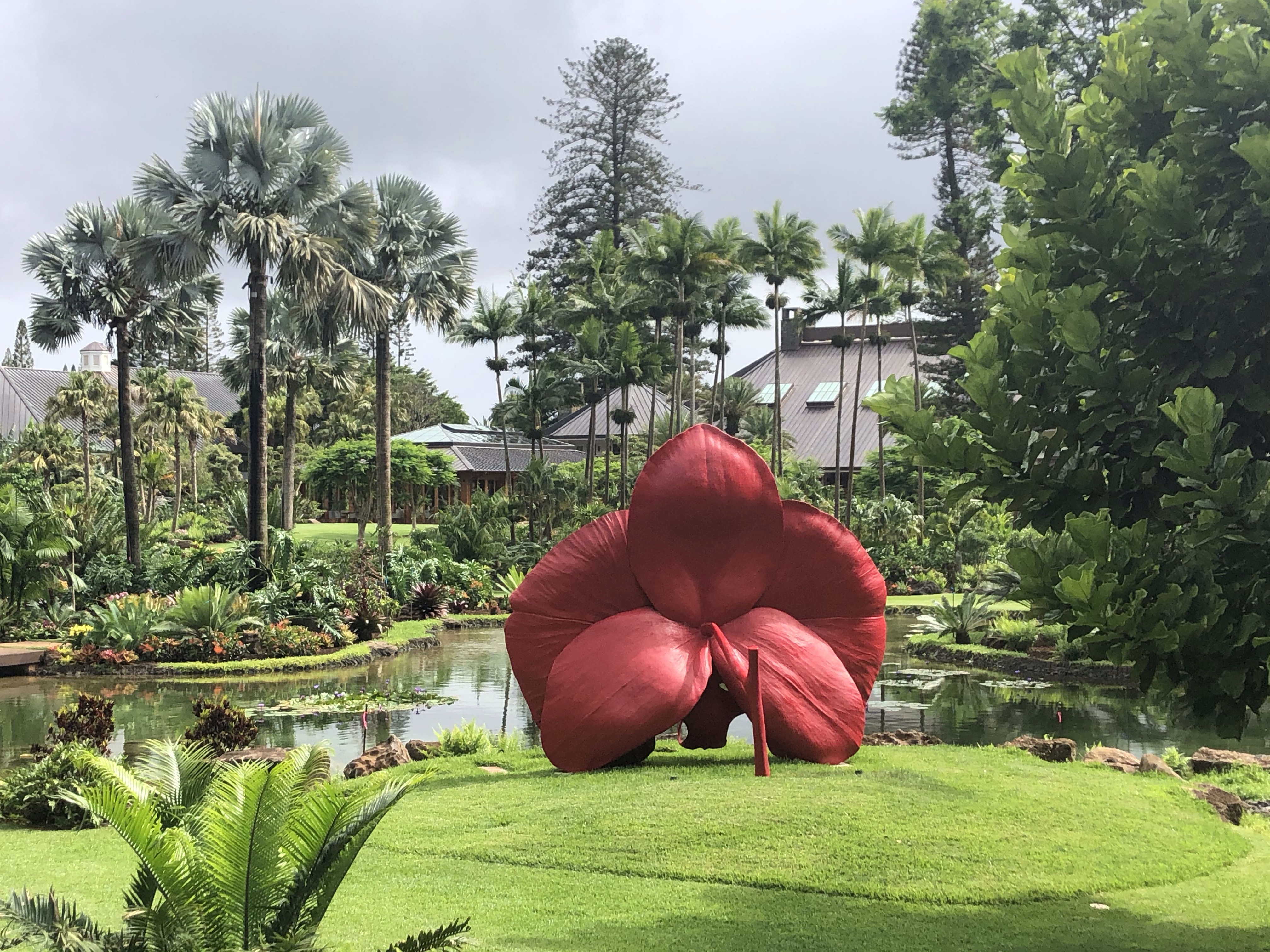




 Lana’i is truly a beautiful, special and unique island. Traveling there is like turning back time to the Old Hawai’i. Mama G commented that Lana’i City, with its tin roof homes, reminded her of her small hometown of Waipahu on Oahu when she was a little girl. It’s a very tranquil and peaceful slice of heaven. Being there is almost surreal. We got lost wandering through the lush gardens and koi ponds at the beach resort and serendipitously happened upon a hula performance featuring two dancers with the ocean for a backdrop. They swayed in rhythm with each other, both of them in synch with the palm trees blowing in the trade winds behind them. Four Seasons thinks of everything to make your experience memorable.
Lana’i is truly a beautiful, special and unique island. Traveling there is like turning back time to the Old Hawai’i. Mama G commented that Lana’i City, with its tin roof homes, reminded her of her small hometown of Waipahu on Oahu when she was a little girl. It’s a very tranquil and peaceful slice of heaven. Being there is almost surreal. We got lost wandering through the lush gardens and koi ponds at the beach resort and serendipitously happened upon a hula performance featuring two dancers with the ocean for a backdrop. They swayed in rhythm with each other, both of them in synch with the palm trees blowing in the trade winds behind them. Four Seasons thinks of everything to make your experience memorable.

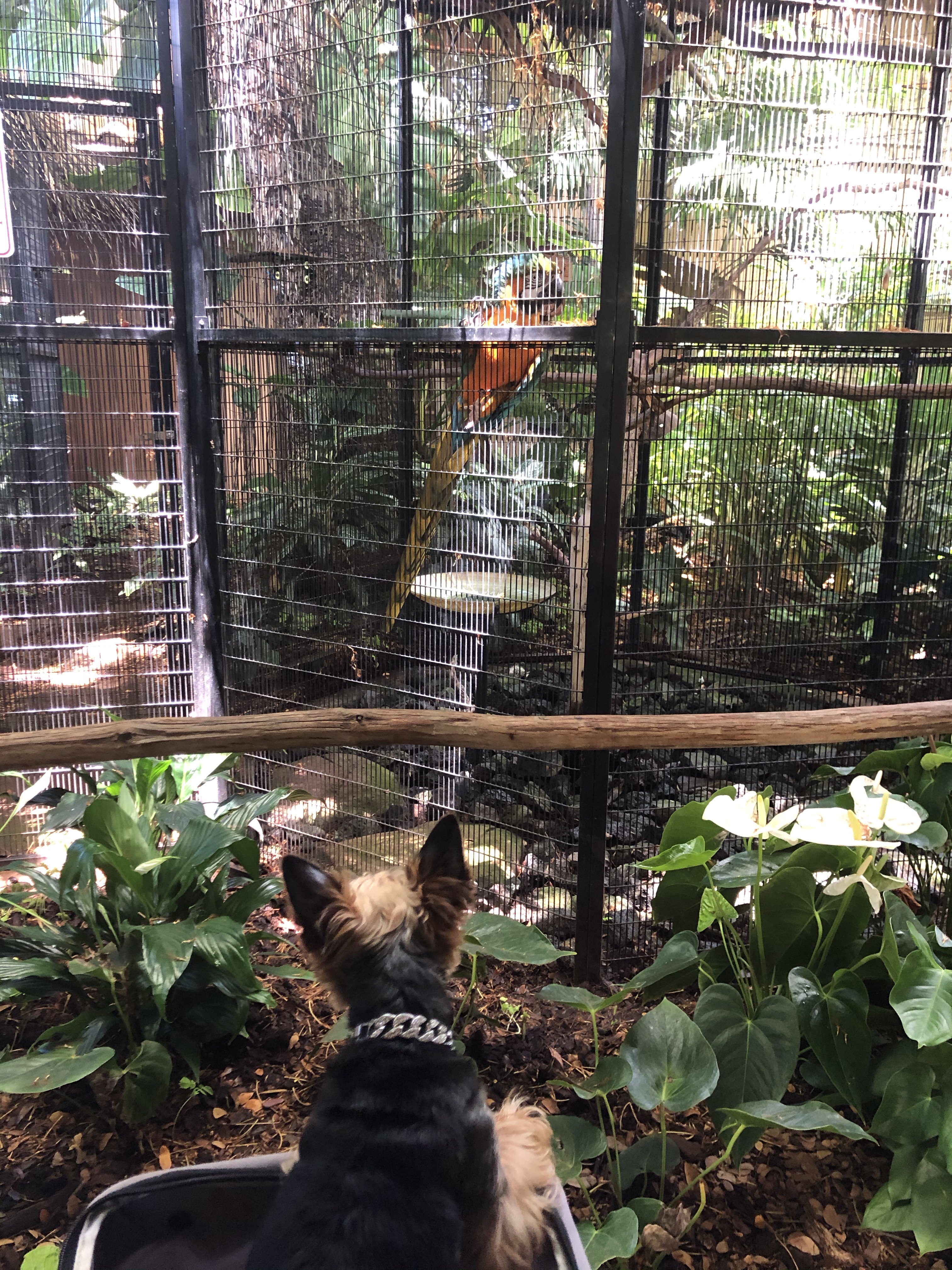

 In addition to natural beauty and outdoor adventures, Lana’i is home to the award-winning twin Four Seasons Resorts (the lodge or the beach) as well as many mouth watering dining options, serving the most exclusive world class gastronomical delights. Flying in the private plane and being whisked to the five-diamond property is like guest starring in “Lifestyles of the Rich and Famous.” Juxtaposing the fancy shmancy extravagances and indulgences, the simplicity of the small island life and the sensory pleasures of sitting outside listening to the crashing waves of the ocean while staring up at the spectacular visual display of stars unspoiled by urbanity, contributes to the uniqueness of this extraordinary island gem. The pictures and stories do not substitute for experiencing Lana’i personally.
In addition to natural beauty and outdoor adventures, Lana’i is home to the award-winning twin Four Seasons Resorts (the lodge or the beach) as well as many mouth watering dining options, serving the most exclusive world class gastronomical delights. Flying in the private plane and being whisked to the five-diamond property is like guest starring in “Lifestyles of the Rich and Famous.” Juxtaposing the fancy shmancy extravagances and indulgences, the simplicity of the small island life and the sensory pleasures of sitting outside listening to the crashing waves of the ocean while staring up at the spectacular visual display of stars unspoiled by urbanity, contributes to the uniqueness of this extraordinary island gem. The pictures and stories do not substitute for experiencing Lana’i personally.
We commented on how special it was to practically have the resort to ourselves. There were very few people visiting and all were Kama’Aina. The local residents were happy to be back to work providing hospitality that seems to come naturally, if a bit on the slow side. Do not expect anything to move quickly here. Everything is on island time.
I am very blessed and extremely grateful for the unique experience and the unforgettable time spent with Mama G, LuLu and Spike—even stuck in the sand in a Jeep with no 4-wheel drive, which, according to Mama G, is now a funny story to tell. Today’s moments become tomorrow’s memories, so make them count, especially during these unprecedented and challenging times of the pandemic. This sojourn gave us a much-needed boost to our spirits and a brief respite from the current chaotic state of our world. It was a reminder of the everyday things we all used to take for granted not so long ago as well as a hopeful vision of what’s to come in better days ahead.







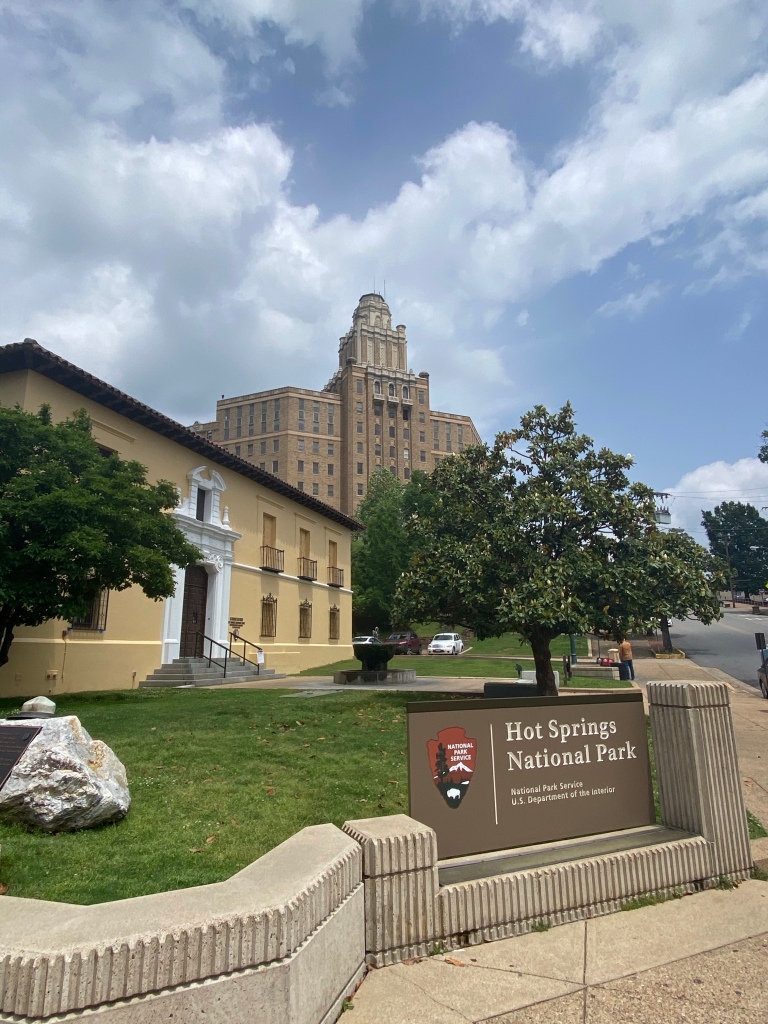

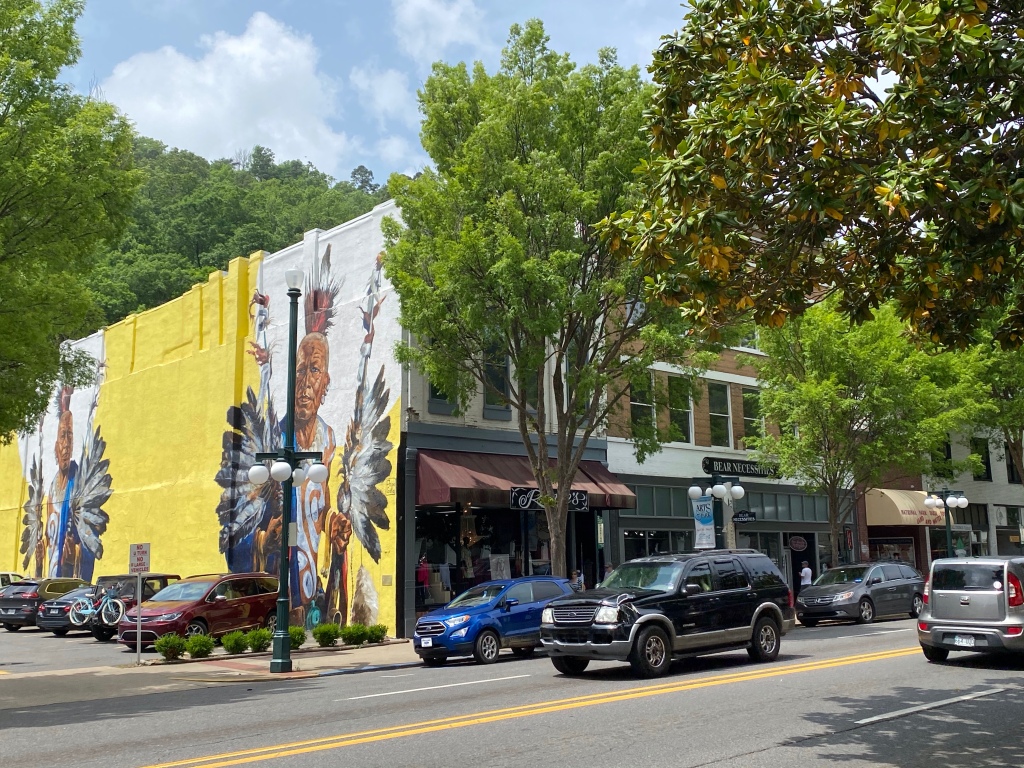


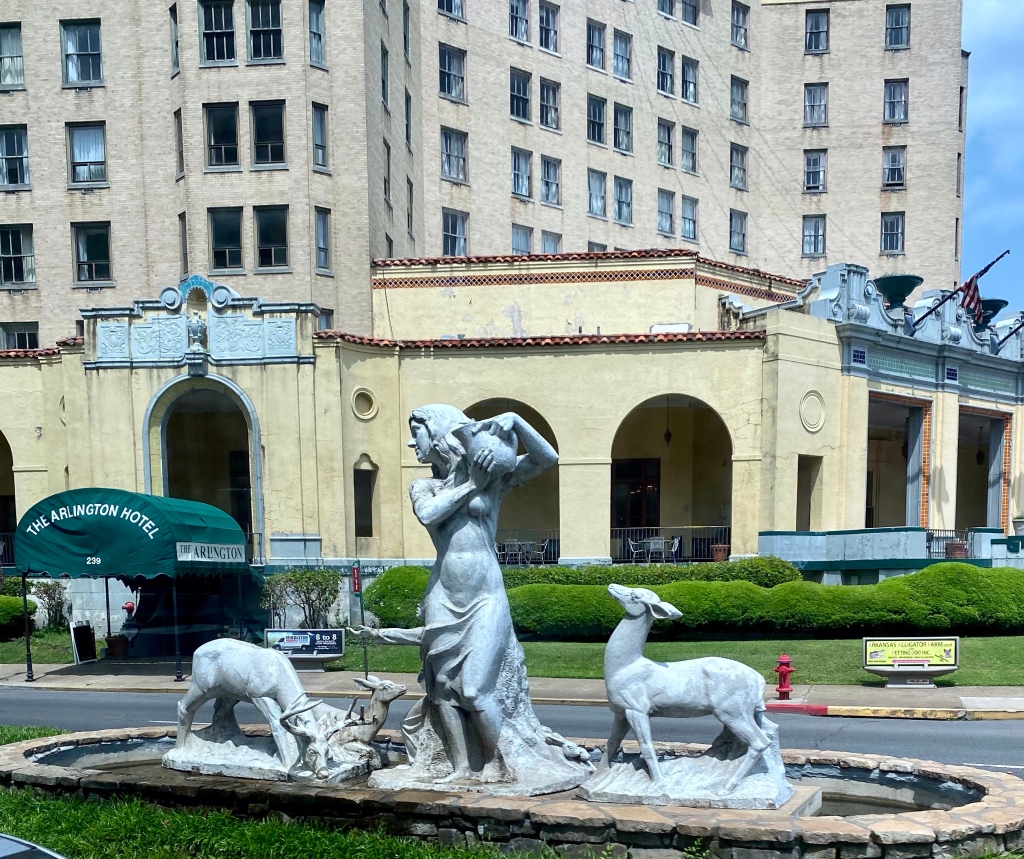








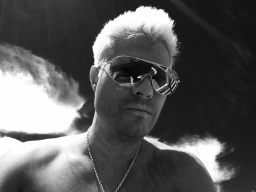

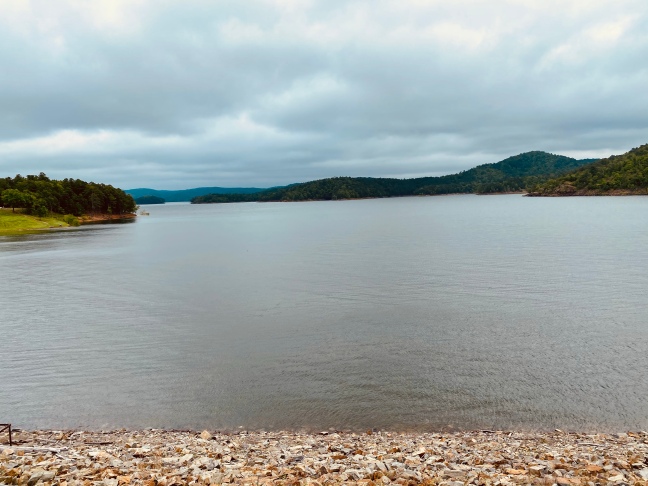
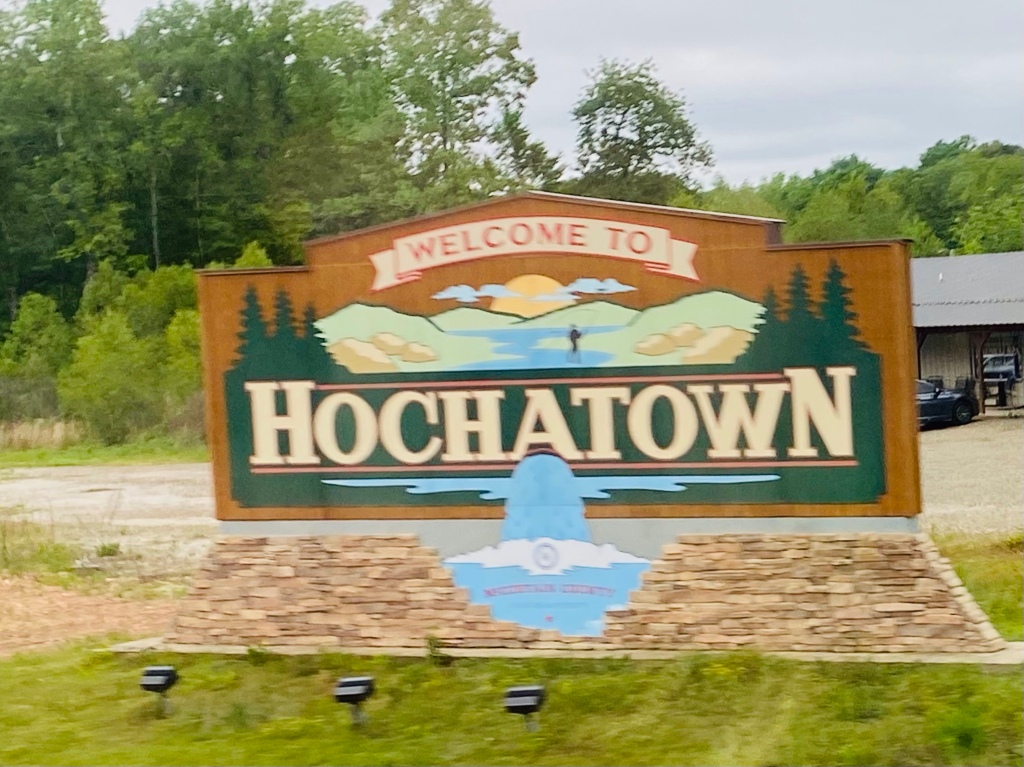





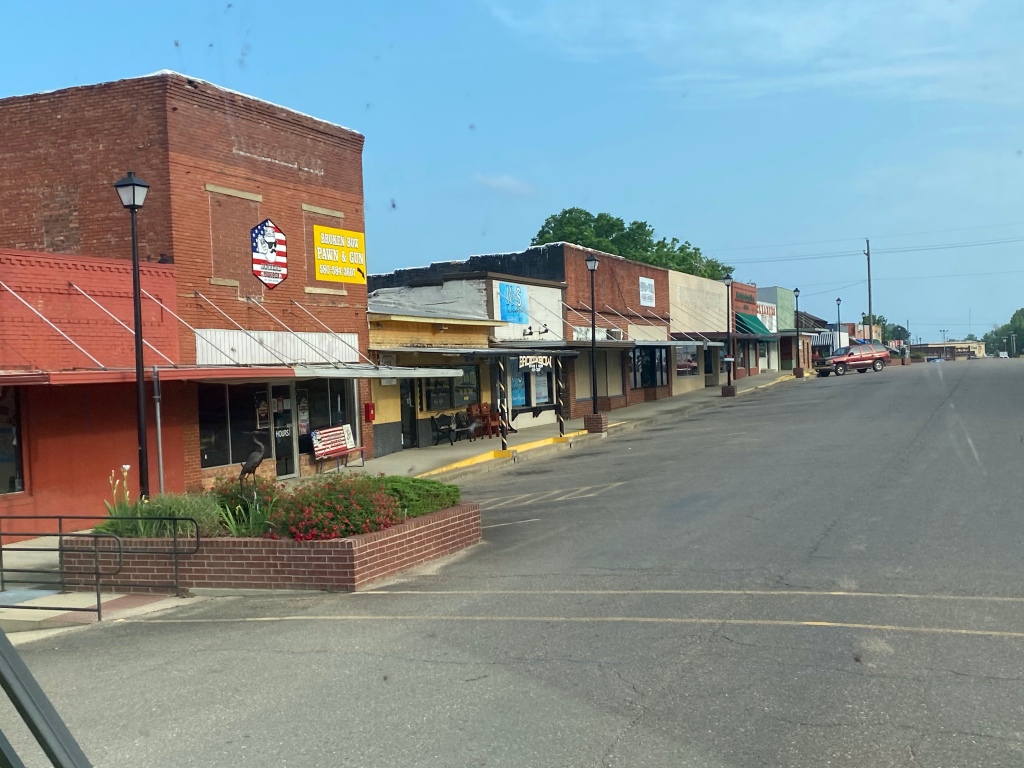
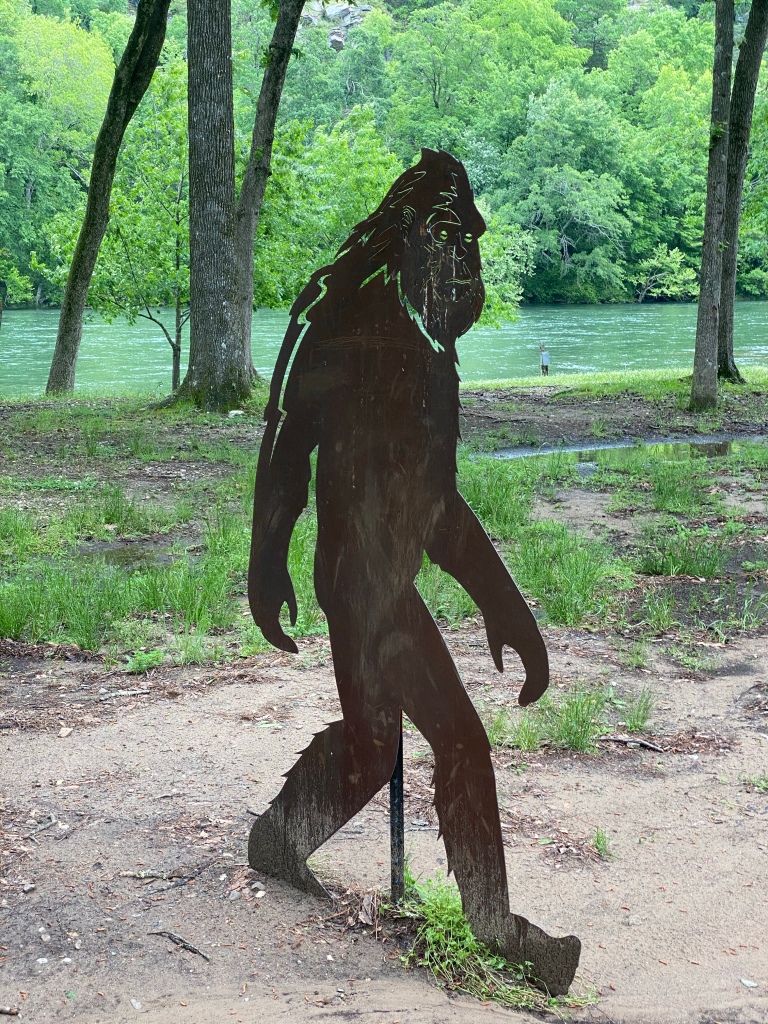





 On the highly anticipated day of our departure, we anxiously put on our brave faces (underneath our masks of course) and our neighbor, Aunty June, delivered us directly to the private Lana’i Air lounge where we were escorted to the tarmac like the Kardashians and boarded with our two Yorkies, LuLu and Spike, otherwise known as High and Maintenance, in tow.
On the highly anticipated day of our departure, we anxiously put on our brave faces (underneath our masks of course) and our neighbor, Aunty June, delivered us directly to the private Lana’i Air lounge where we were escorted to the tarmac like the Kardashians and boarded with our two Yorkies, LuLu and Spike, otherwise known as High and Maintenance, in tow.

 It was a beautiful day to fly with bright blue skies and a few cotton candy clouds. Departing Oahu, the waters off Waikiki and Hanauma Bay were an electric neon turquoise due to the lack of pollution from tourists. Justin offered to fly us over the resort to have a bird’s eye view before landing, which was a special treat.
It was a beautiful day to fly with bright blue skies and a few cotton candy clouds. Departing Oahu, the waters off Waikiki and Hanauma Bay were an electric neon turquoise due to the lack of pollution from tourists. Justin offered to fly us over the resort to have a bird’s eye view before landing, which was a special treat. 




 The resort is an oasis that requires a 30-minute long drive on a two-lane road that begins with a straight, long stretch lined meticulously on both sides with stately pine trees. The road almost looks like something out of a children’s storybook that looks and feels more like England or France than Hawai’i. Spotting axis deer and wild turkey along the way only adds to the enchantment.
The resort is an oasis that requires a 30-minute long drive on a two-lane road that begins with a straight, long stretch lined meticulously on both sides with stately pine trees. The road almost looks like something out of a children’s storybook that looks and feels more like England or France than Hawai’i. Spotting axis deer and wild turkey along the way only adds to the enchantment.
 The pine trees are a signature of Lana’i and have an interesting history and purpose. The first thing you need to know is Lana’i is a rather dry island. It has the least amount of rainfall of all the Hawaiian islands because the mountains on Molokai and Maui capture most of the rainfall which comes its way.
The pine trees are a signature of Lana’i and have an interesting history and purpose. The first thing you need to know is Lana’i is a rather dry island. It has the least amount of rainfall of all the Hawaiian islands because the mountains on Molokai and Maui capture most of the rainfall which comes its way.








 The automatic black out shades were perfect for sleeping in late in the feather beds, which LuLu and Spike would burrow into and snuggle for hours. The hotel staff even had a pet welcoming package with dog bowls and dog beds with their names spelled out in sponge letters that doubled as toys as they flung them around the room. Every time we returned after housekeeping had been there, all of the letters were perfectly returned to their beds, spelling out their names, only to be quickly and delightfully destroyed.
The automatic black out shades were perfect for sleeping in late in the feather beds, which LuLu and Spike would burrow into and snuggle for hours. The hotel staff even had a pet welcoming package with dog bowls and dog beds with their names spelled out in sponge letters that doubled as toys as they flung them around the room. Every time we returned after housekeeping had been there, all of the letters were perfectly returned to their beds, spelling out their names, only to be quickly and delightfully destroyed.

 On the southeastern shores of Hawaii’s last unspoiled island, Four Seasons Resort Lana’i is your gateway to an exotic, private paradise where opportunities for adventure and relaxation abound. By land, sea and sky, Lanai’s riches are all yours to discover.
On the southeastern shores of Hawaii’s last unspoiled island, Four Seasons Resort Lana’i is your gateway to an exotic, private paradise where opportunities for adventure and relaxation abound. By land, sea and sky, Lanai’s riches are all yours to discover. 


 MALIBU FARM
MALIBU FARM













 VIEWS
VIEWS




 Earlier this year, the Four Seasons Lana’i was named the No. 1 Best Hotel in the USA by U.S. News & World Report, the global authority in rankings and consumer advice. The 10th annual Best Hotels rankings evaluated more than 30,000 luxury properties across 400-plus destinations in the United States, Europe, Bermuda, Mexico, Canada and the Caribbean.
Earlier this year, the Four Seasons Lana’i was named the No. 1 Best Hotel in the USA by U.S. News & World Report, the global authority in rankings and consumer advice. The 10th annual Best Hotels rankings evaluated more than 30,000 luxury properties across 400-plus destinations in the United States, Europe, Bermuda, Mexico, Canada and the Caribbean.




 Fronting the Four Seasons Resort Lana’i and named one of America’s best beaches, Hulopoe Beach is the best spot on the island for snorkeling and swimming. Located on Lanai’s southern coast, Hulopoe Bay greets you with a stunning expanse of pearl-white sand and crystal blue waters. We could even see a blow hole from our lanai.
Fronting the Four Seasons Resort Lana’i and named one of America’s best beaches, Hulopoe Beach is the best spot on the island for snorkeling and swimming. Located on Lanai’s southern coast, Hulopoe Bay greets you with a stunning expanse of pearl-white sand and crystal blue waters. We could even see a blow hole from our lanai. 


 In fact, we could have spent the entire time lounging at the resort, but we rented a Jeep for a day and set out on an adventure far away from the comforts of our temporary home to explore new territory. Passing through Lana’i City, we headed toward Shipwreck Beach.
In fact, we could have spent the entire time lounging at the resort, but we rented a Jeep for a day and set out on an adventure far away from the comforts of our temporary home to explore new territory. Passing through Lana’i City, we headed toward Shipwreck Beach. 


 On the sand road, we went down into a dip and never came back up. I tried to shift to 4-wheel drive but it wouldn’t work. Then we went back and forth between reverse and drive, kicking up sand and promptly digging ourselves so far into the ground that sand was practically coming in through the doors, and the axle was almost buried in the earth.
On the sand road, we went down into a dip and never came back up. I tried to shift to 4-wheel drive but it wouldn’t work. Then we went back and forth between reverse and drive, kicking up sand and promptly digging ourselves so far into the ground that sand was practically coming in through the doors, and the axle was almost buried in the earth. To make matters more alarming, I couldn’t get cell phone service. Thankfully Mama G was able to call roadside assistance, which costs $500. At this point I thought it was my fault we were stuck so I was prepared to pay the outrageous bill just to get us out of there. We lost time (about an hour and a half) waiting for roadside assistance but met a lovely local couple, James Truman and Carol DeShay-Truman, who came along and offered to assist us.
To make matters more alarming, I couldn’t get cell phone service. Thankfully Mama G was able to call roadside assistance, which costs $500. At this point I thought it was my fault we were stuck so I was prepared to pay the outrageous bill just to get us out of there. We lost time (about an hour and a half) waiting for roadside assistance but met a lovely local couple, James Truman and Carol DeShay-Truman, who came along and offered to assist us. 


 Before dinner, we drove to Kaumalapau Harbor, located on the southwestern coast and the main commercial seaport for Lana’i. The original harbor breakwater was built in the 1920s by James Dole, the founder of the Hawaiian Pineapple Company. After years of hurricanes severely damaging the harbor, the U.S. Army Corps of Engineers constructed a new breakwater. The project was dedicated on July 7, 2007 and now Kaumalapau Harbor has a one of a kind look with a $28.2 million price tag. Buttressed by 819 white 35-ton Core-Loc armor units — the largest of their kind in the world — the harbor appears to be surrounded by giant, jack-like concrete blocks. The aerial photo below is courtesy of the U.S. Army Corps of Engineers.
Before dinner, we drove to Kaumalapau Harbor, located on the southwestern coast and the main commercial seaport for Lana’i. The original harbor breakwater was built in the 1920s by James Dole, the founder of the Hawaiian Pineapple Company. After years of hurricanes severely damaging the harbor, the U.S. Army Corps of Engineers constructed a new breakwater. The project was dedicated on July 7, 2007 and now Kaumalapau Harbor has a one of a kind look with a $28.2 million price tag. Buttressed by 819 white 35-ton Core-Loc armor units — the largest of their kind in the world — the harbor appears to be surrounded by giant, jack-like concrete blocks. The aerial photo below is courtesy of the U.S. Army Corps of Engineers.

 For dinner that night we went back to town and dined al fresco at Lana’i City Bar & Grille, part of the Hotel Lana’i. Comfortable and elegant, the bar and dining area recall Hotel Lanai’s plantation history with rustic, vintage charm and warm Hawaiian hospitality. Head to the open-air lanai to enjoy an evening dining under the stars among towering Cook pine trees, often with live local entertainment. We endured the sprinkles of a passing shower but were quite pleased overall with the ambience, service and food. Mama G raved about the pulled pork sandwich. Be sure to ask for the baked-to-order cookie skillet, which is a chocolate chip cookie featuring both milk and white chocolate chips, baked in a small cast iron skillet and topped with vanilla ice cream.
For dinner that night we went back to town and dined al fresco at Lana’i City Bar & Grille, part of the Hotel Lana’i. Comfortable and elegant, the bar and dining area recall Hotel Lanai’s plantation history with rustic, vintage charm and warm Hawaiian hospitality. Head to the open-air lanai to enjoy an evening dining under the stars among towering Cook pine trees, often with live local entertainment. We endured the sprinkles of a passing shower but were quite pleased overall with the ambience, service and food. Mama G raved about the pulled pork sandwich. Be sure to ask for the baked-to-order cookie skillet, which is a chocolate chip cookie featuring both milk and white chocolate chips, baked in a small cast iron skillet and topped with vanilla ice cream.  In Lana’i City, we stopped at the service station in this tiny town because when Mama G asked someone if there’s anywhere to shop, they replied, “You can buy T-shirts at the gas staton.” It felt like we were on Green Acres going to town, excited to visit the general store. Not only is there a small population, there is no traffic. In fact, there is not a single traffic light on the entire island of Lana’i.
In Lana’i City, we stopped at the service station in this tiny town because when Mama G asked someone if there’s anywhere to shop, they replied, “You can buy T-shirts at the gas staton.” It felt like we were on Green Acres going to town, excited to visit the general store. Not only is there a small population, there is no traffic. In fact, there is not a single traffic light on the entire island of Lana’i.  Another evening, we visited the Four Seasons’ sister property Sensei Lana’i. A shuttle took us from the beach resort to the lodge and a chauffeured Tesla returned us after we enjoyed dining at the extravagant Sensei by NOBU.
Another evening, we visited the Four Seasons’ sister property Sensei Lana’i. A shuttle took us from the beach resort to the lodge and a chauffeured Tesla returned us after we enjoyed dining at the extravagant Sensei by NOBU. 



 The Sensei by NOBU restaurant offers a menu with health conscious choices since it’s a wellness retreat. Guests can dine morning, noon and night surrounded by the beauty of nature. A glass pavilion sits upon a reflecting pond, offering indoor and outdoor tables. A 16-seat communal table, welcoming you to gather with friends old and new, is temporarily closed, a victim of social distancing. There were a handful of other tables occupied and scattered around the large, spacious dining room.
The Sensei by NOBU restaurant offers a menu with health conscious choices since it’s a wellness retreat. Guests can dine morning, noon and night surrounded by the beauty of nature. A glass pavilion sits upon a reflecting pond, offering indoor and outdoor tables. A 16-seat communal table, welcoming you to gather with friends old and new, is temporarily closed, a victim of social distancing. There were a handful of other tables occupied and scattered around the large, spacious dining room.  Chef Nobu Matsuhisa has long been at the forefront of innovative cuisine grounded in Japanese sensibilities and clean ingredients. Guests of Four Seasons will enjoy a wellness menu created by Chef Nobu and his team in close collaboration with Sensei’s nutritionists. On the Sensei by NOBU menu are such favorites as the world-renowned black cod with miso, as well as a new selection inspired by the bounty of the steps-away Sensei Farm Lana’i, and the neighboring islands and waters of Hawai’i.
Chef Nobu Matsuhisa has long been at the forefront of innovative cuisine grounded in Japanese sensibilities and clean ingredients. Guests of Four Seasons will enjoy a wellness menu created by Chef Nobu and his team in close collaboration with Sensei’s nutritionists. On the Sensei by NOBU menu are such favorites as the world-renowned black cod with miso, as well as a new selection inspired by the bounty of the steps-away Sensei Farm Lana’i, and the neighboring islands and waters of Hawai’i. To work off some calories and take in the unique natural beauty of Lana’i, I went horseback riding at Lana’i Ranch at Koele, across the street from the Four Seasons Sensei Lodge. I rode through the fog and into the hills surrounding Koele – once the center of ranching operations on the island – and explored the lush woodlands, home to axis deer and wild turkey.
To work off some calories and take in the unique natural beauty of Lana’i, I went horseback riding at Lana’i Ranch at Koele, across the street from the Four Seasons Sensei Lodge. I rode through the fog and into the hills surrounding Koele – once the center of ranching operations on the island – and explored the lush woodlands, home to axis deer and wild turkey. 



 Back at the stables, I told Alexis, one of the ranch hands, that I love goats. She said, “All you have to do is yell, ‘Goats, Goats, Goats!’ and they come running!” I thought she was kidding me until she hollered, “Goats! Goats! Goats!” and sure enough a herd of goats came running at me so fast that if the fence hadn’t been between us, they’d have stampeded me. What a joyful delight! She even let me feed the Tita (female bully) of the pack.
Back at the stables, I told Alexis, one of the ranch hands, that I love goats. She said, “All you have to do is yell, ‘Goats, Goats, Goats!’ and they come running!” I thought she was kidding me until she hollered, “Goats! Goats! Goats!” and sure enough a herd of goats came running at me so fast that if the fence hadn’t been between us, they’d have stampeded me. What a joyful delight! She even let me feed the Tita (female bully) of the pack.

 On our last day, Bradley, the Four Seasons beach resort manager, arranged for us to have a late check-out as well as a private driver in a Tesla to take us up to the top of the mountain for one last lunch in heaven at The Views restaurant at the Manele Golf Course. Following lunch, our driver escorted us to Sensei Lodge where we were treated to a private tour, led by Luis, the Sensei manager, himself. He drove us around on a state of the art golf cart to inspect the breathtaking gardens up close. We were in awe of the natural beauty and took turns guessing at the amount of manpower and hours required to maintain the immaculate grandeur. There are separate hales (houses) for spa treatments and wellness classes. There are huge ponds and outdoor sculptures. Flora and fauna from all around the world rival any botanical gardens’ collection.
On our last day, Bradley, the Four Seasons beach resort manager, arranged for us to have a late check-out as well as a private driver in a Tesla to take us up to the top of the mountain for one last lunch in heaven at The Views restaurant at the Manele Golf Course. Following lunch, our driver escorted us to Sensei Lodge where we were treated to a private tour, led by Luis, the Sensei manager, himself. He drove us around on a state of the art golf cart to inspect the breathtaking gardens up close. We were in awe of the natural beauty and took turns guessing at the amount of manpower and hours required to maintain the immaculate grandeur. There are separate hales (houses) for spa treatments and wellness classes. There are huge ponds and outdoor sculptures. Flora and fauna from all around the world rival any botanical gardens’ collection.









 Lana’i is truly a beautiful, special and unique island. Traveling there is like turning back time to the Old Hawai’i. Mama G commented that Lana’i City, with its tin roof homes, reminded her of her small hometown of Waipahu on Oahu when she was a little girl. It’s a very tranquil and peaceful slice of heaven. Being there is almost surreal. We got lost wandering through the lush gardens and koi ponds at the beach resort and serendipitously happened upon a hula performance featuring two dancers with the ocean for a backdrop. They swayed in rhythm with each other, both of them in synch with the palm trees blowing in the trade winds behind them. Four Seasons thinks of everything to make your experience memorable.
Lana’i is truly a beautiful, special and unique island. Traveling there is like turning back time to the Old Hawai’i. Mama G commented that Lana’i City, with its tin roof homes, reminded her of her small hometown of Waipahu on Oahu when she was a little girl. It’s a very tranquil and peaceful slice of heaven. Being there is almost surreal. We got lost wandering through the lush gardens and koi ponds at the beach resort and serendipitously happened upon a hula performance featuring two dancers with the ocean for a backdrop. They swayed in rhythm with each other, both of them in synch with the palm trees blowing in the trade winds behind them. Four Seasons thinks of everything to make your experience memorable.


 In addition to natural beauty and outdoor adventures, Lana’i is home to the award-winning twin Four Seasons Resorts (the lodge or the beach) as well as many mouth watering dining options, serving the most exclusive world class gastronomical delights. Flying in the private plane and being whisked to the five-diamond property is like guest starring in “Lifestyles of the Rich and Famous.” Juxtaposing the fancy shmancy extravagances and indulgences, the simplicity of the small island life and the sensory pleasures of sitting outside listening to the crashing waves of the ocean while staring up at the spectacular visual display of stars unspoiled by urbanity, contributes to the uniqueness of this extraordinary island gem. The pictures and stories do not substitute for experiencing Lana’i personally.
In addition to natural beauty and outdoor adventures, Lana’i is home to the award-winning twin Four Seasons Resorts (the lodge or the beach) as well as many mouth watering dining options, serving the most exclusive world class gastronomical delights. Flying in the private plane and being whisked to the five-diamond property is like guest starring in “Lifestyles of the Rich and Famous.” Juxtaposing the fancy shmancy extravagances and indulgences, the simplicity of the small island life and the sensory pleasures of sitting outside listening to the crashing waves of the ocean while staring up at the spectacular visual display of stars unspoiled by urbanity, contributes to the uniqueness of this extraordinary island gem. The pictures and stories do not substitute for experiencing Lana’i personally.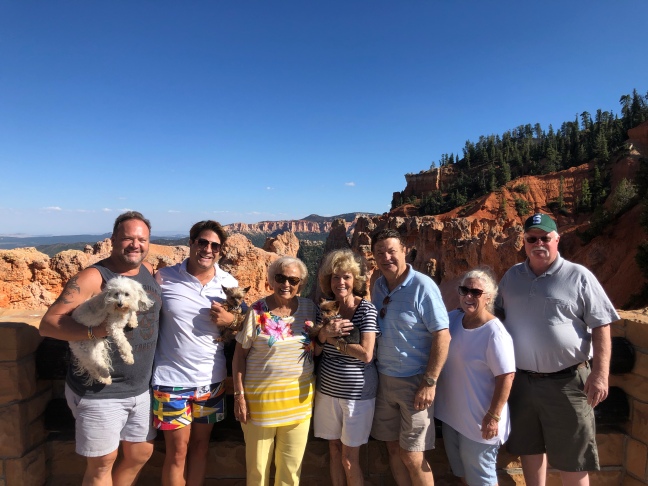









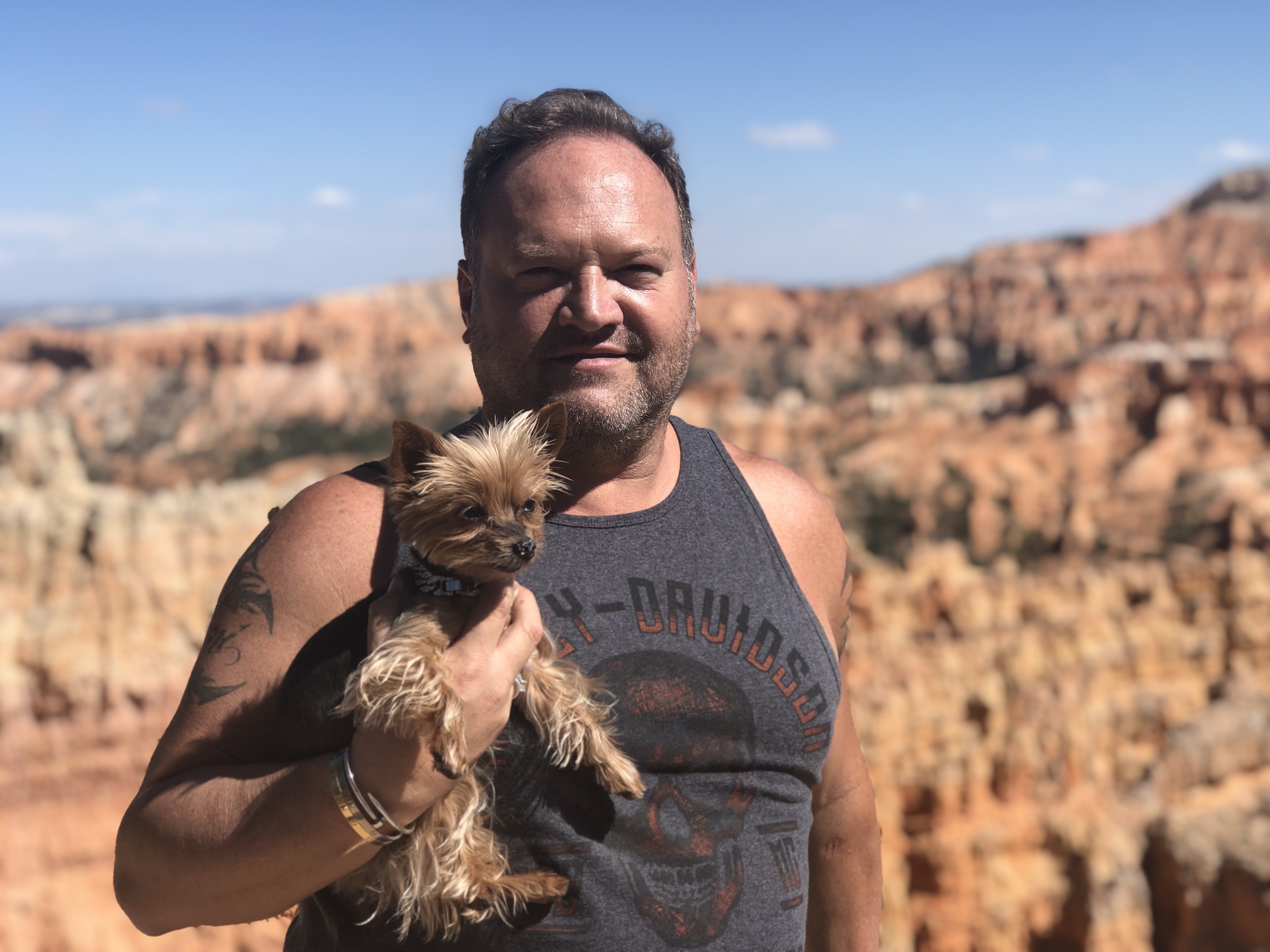



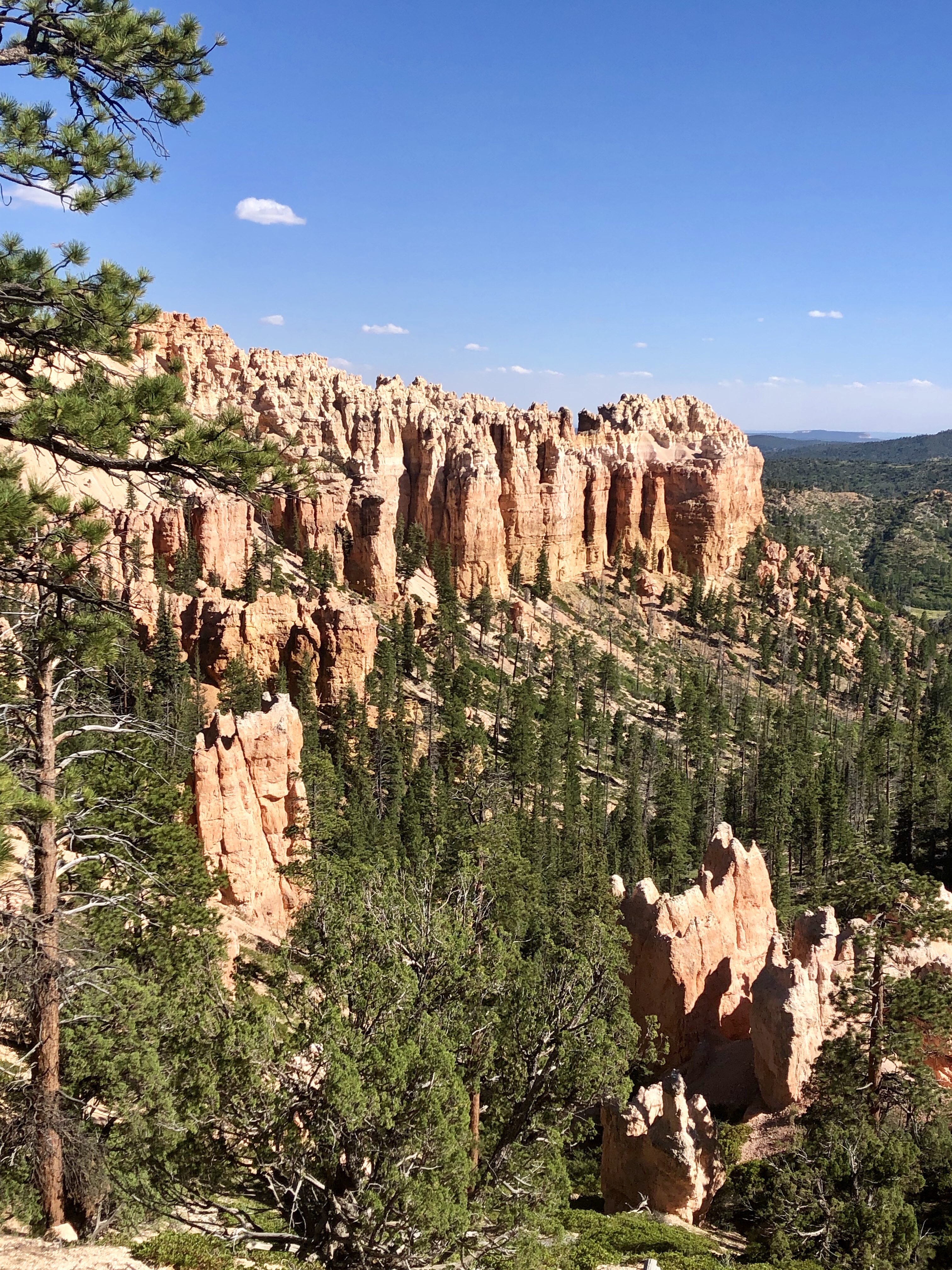
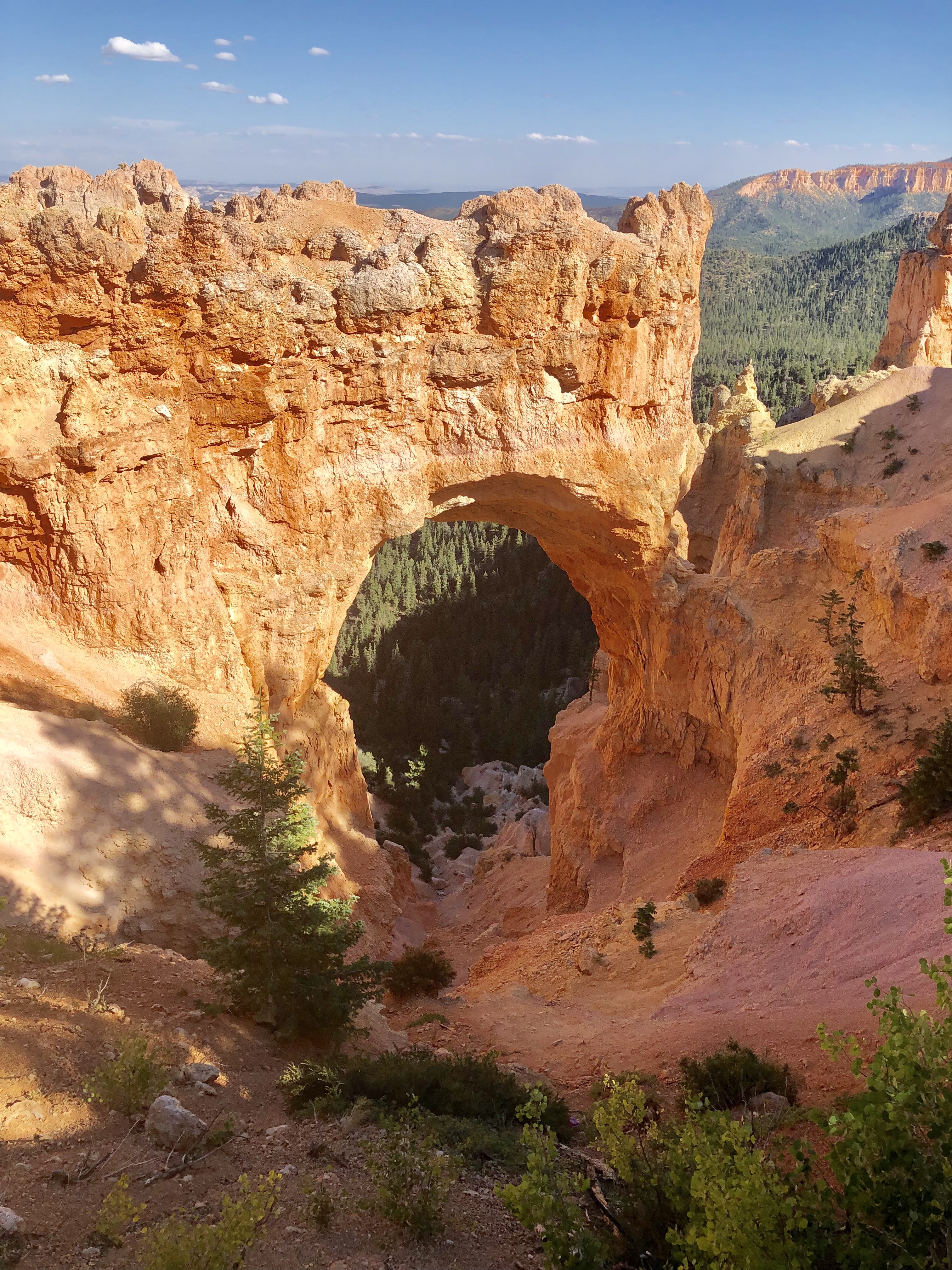



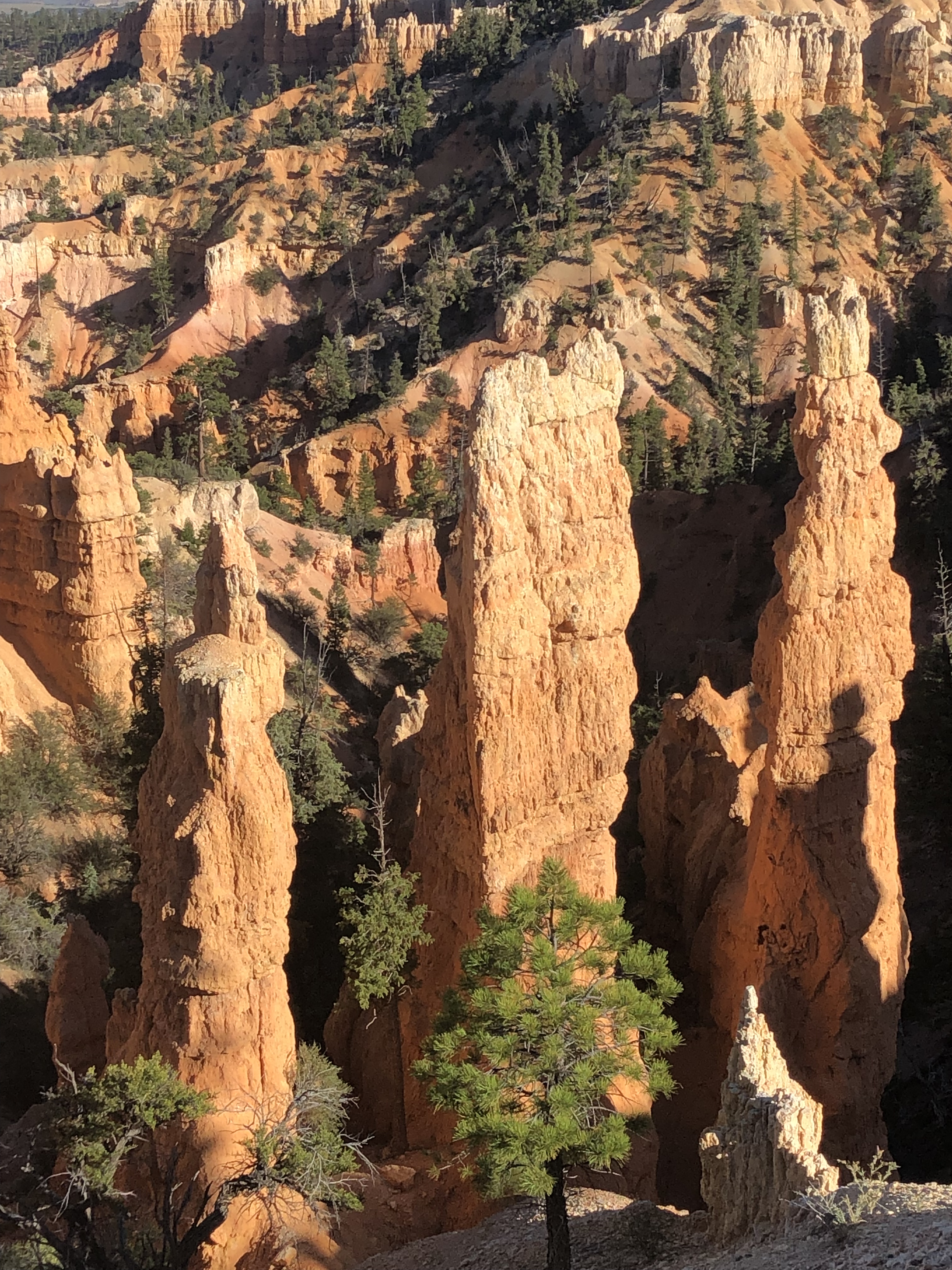



 Bryce Canyon offers two campground sites (one in winter) and lodging is available at the Bryce Canyon Lodge during the summer season. During winter, hotel rooms are available in the park at the Sunset Hotel. We all enjoyed the spectacular Red Canyon on the way out of town.
Bryce Canyon offers two campground sites (one in winter) and lodging is available at the Bryce Canyon Lodge during the summer season. During winter, hotel rooms are available in the park at the Sunset Hotel. We all enjoyed the spectacular Red Canyon on the way out of town.












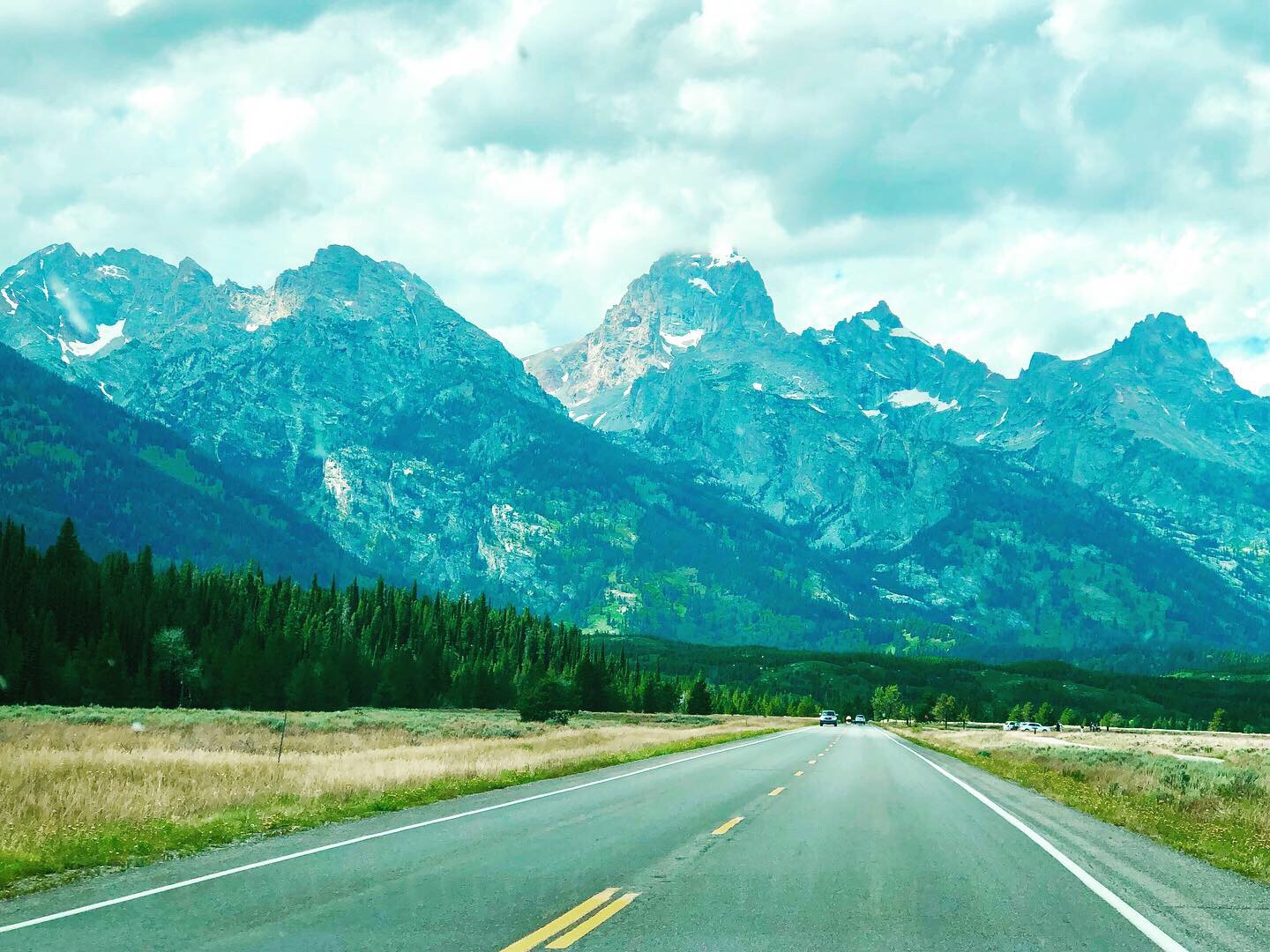
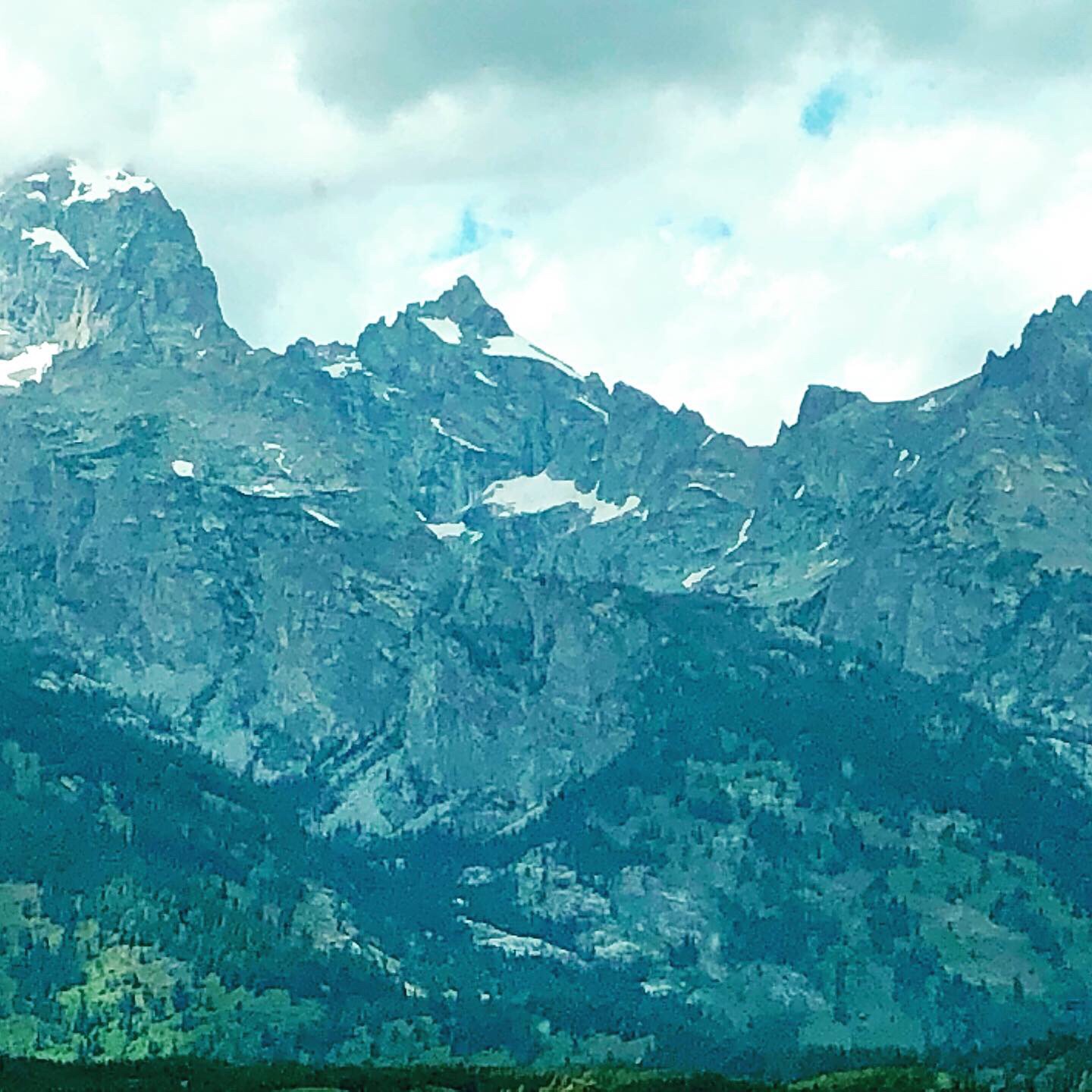











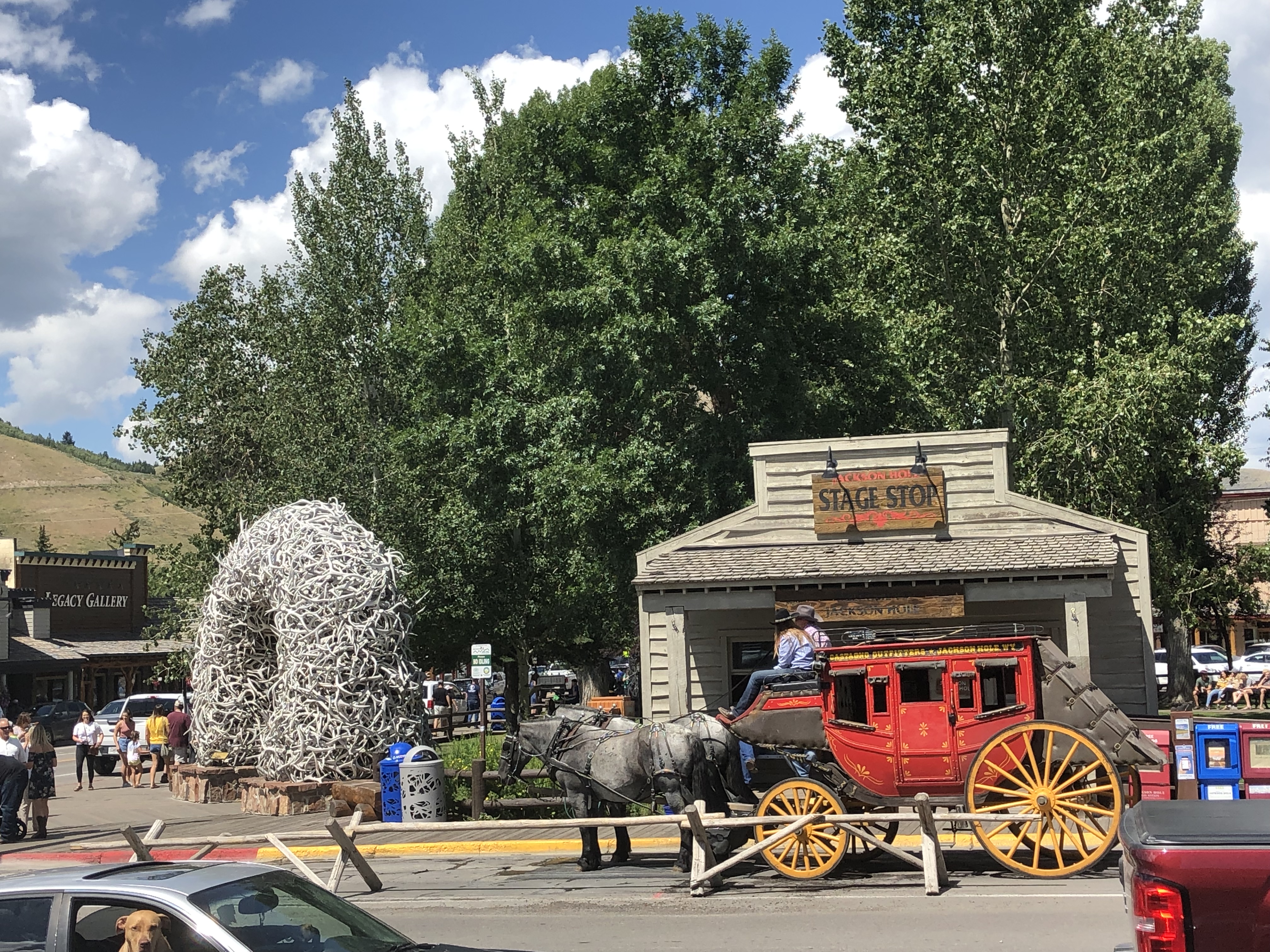


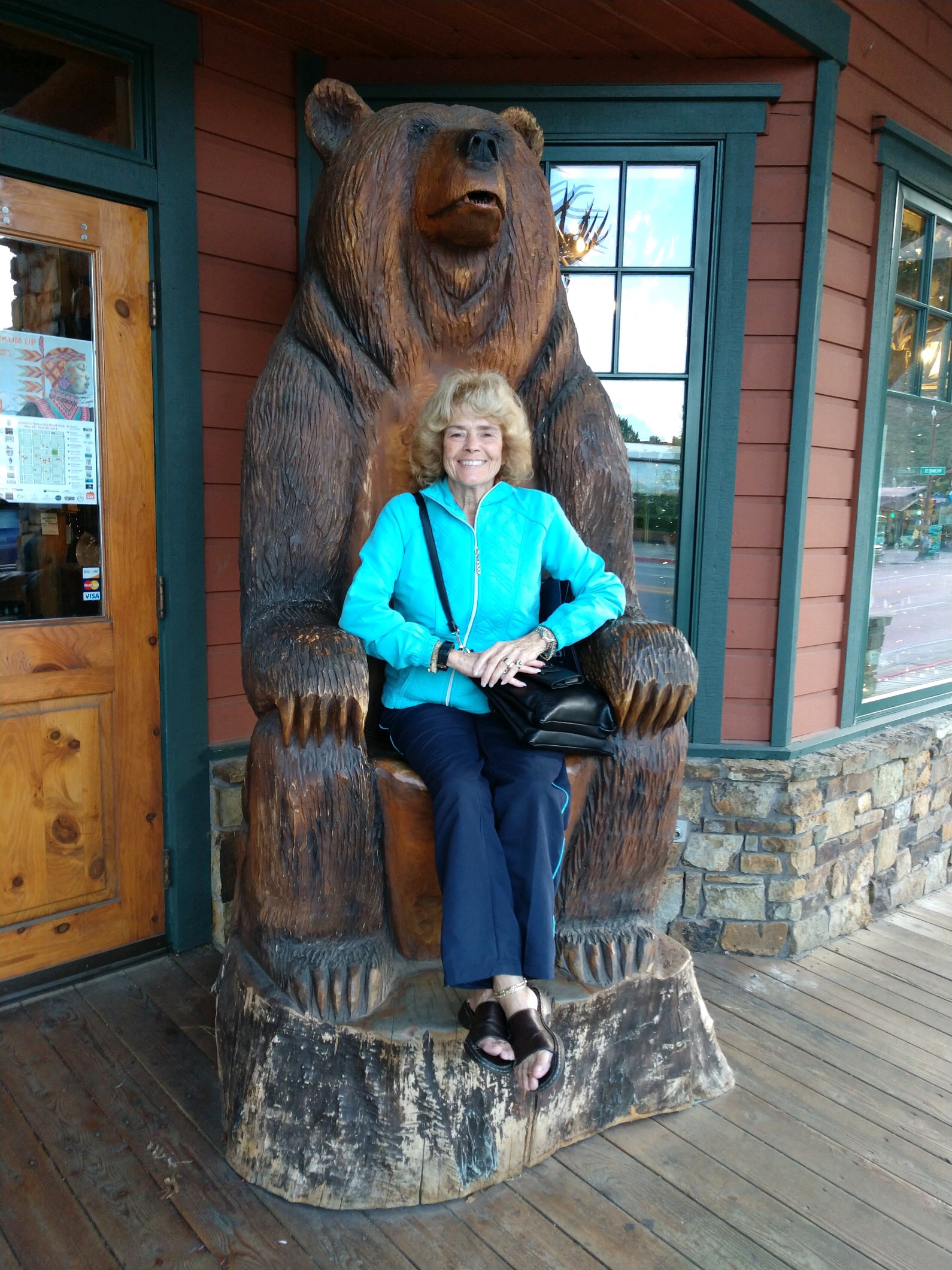


 Just outside of town, the National Elk Refuge was created in 1912 to protect habitat and provide sanctuary for one of the largest elk herds on the planet. A total of 24,700 acres, the refuge is home to an average of 7,500 elk each winter. The refuge is managed by the U.S. Fish and Wildlife Service.
Just outside of town, the National Elk Refuge was created in 1912 to protect habitat and provide sanctuary for one of the largest elk herds on the planet. A total of 24,700 acres, the refuge is home to an average of 7,500 elk each winter. The refuge is managed by the U.S. Fish and Wildlife Service.


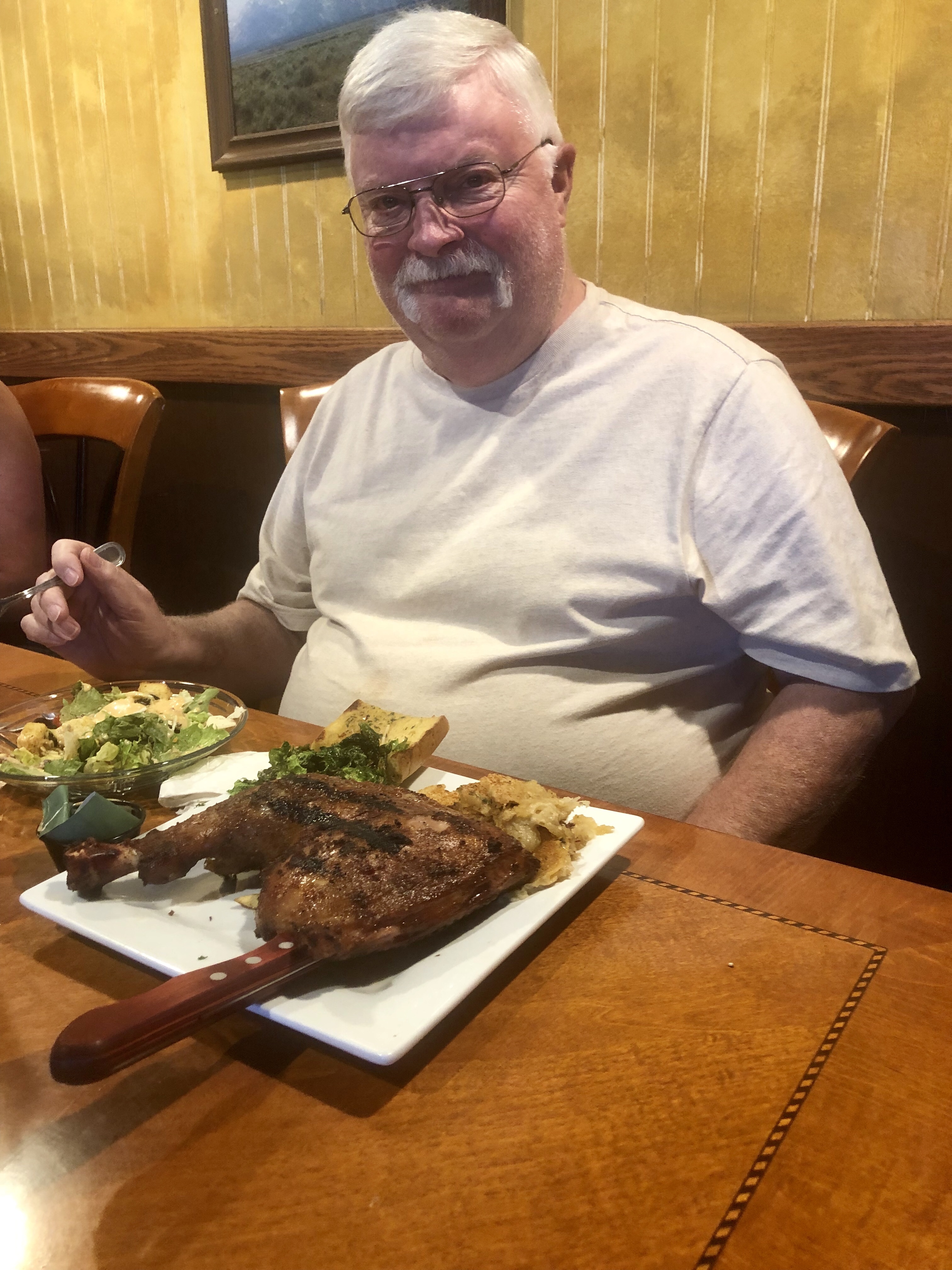

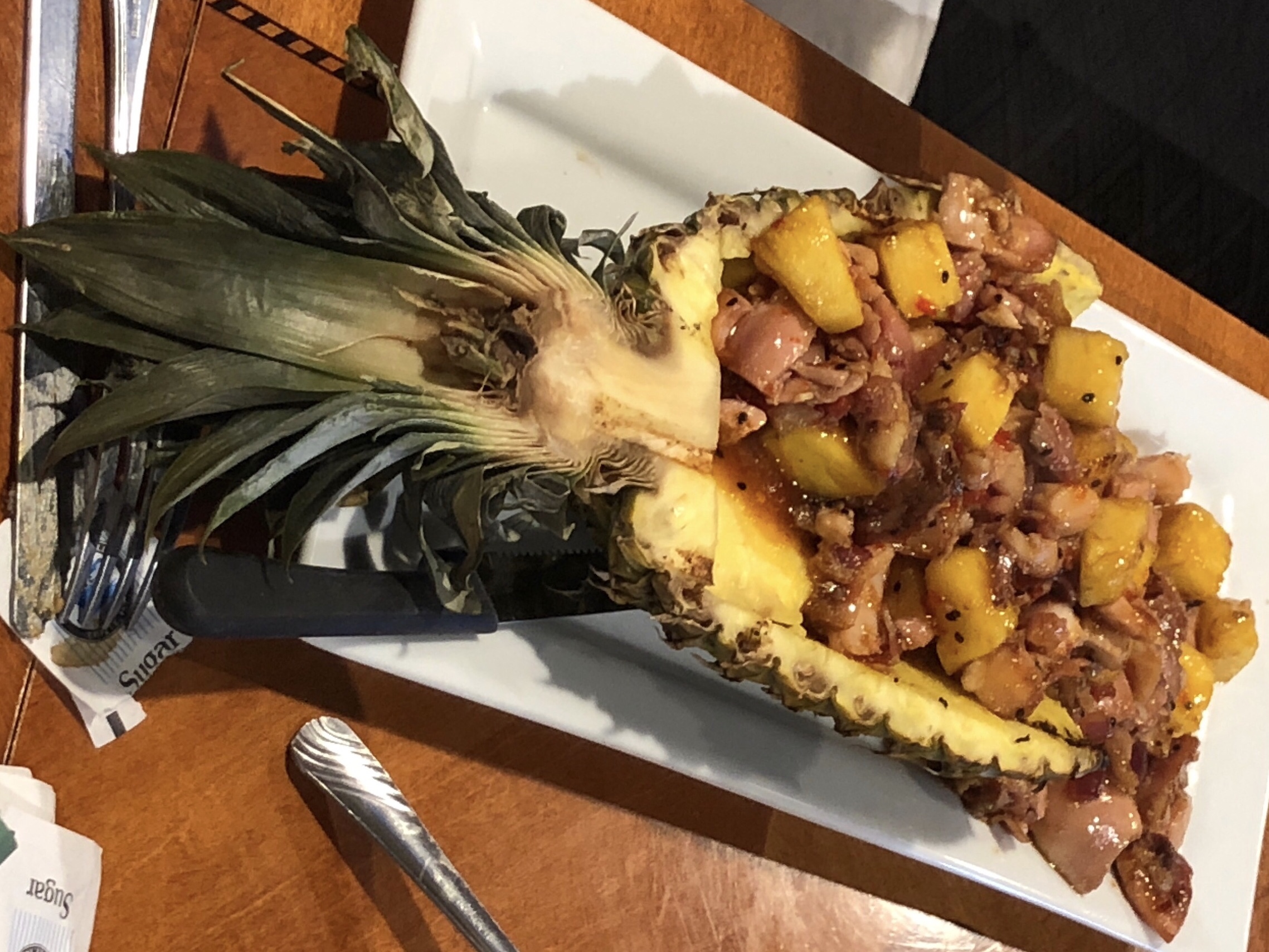
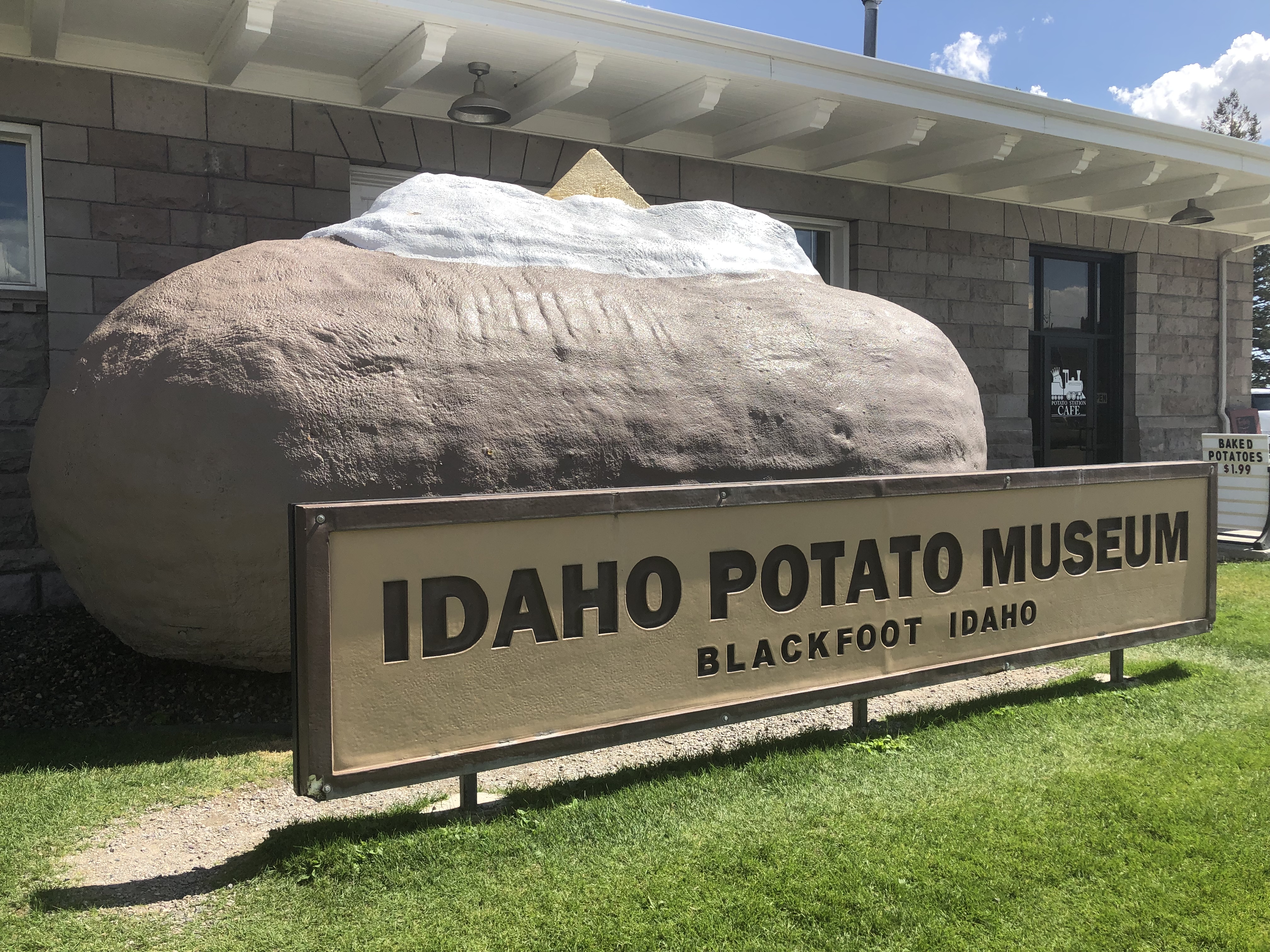
 We enjoyed visiting with family and taking in more of the breathtaking scenery of the Wild West. The next, and final, destination on our epic journey will be Salt Lake City where we will see some more relatives and visit Bryce Canyon.
We enjoyed visiting with family and taking in more of the breathtaking scenery of the Wild West. The next, and final, destination on our epic journey will be Salt Lake City where we will see some more relatives and visit Bryce Canyon.












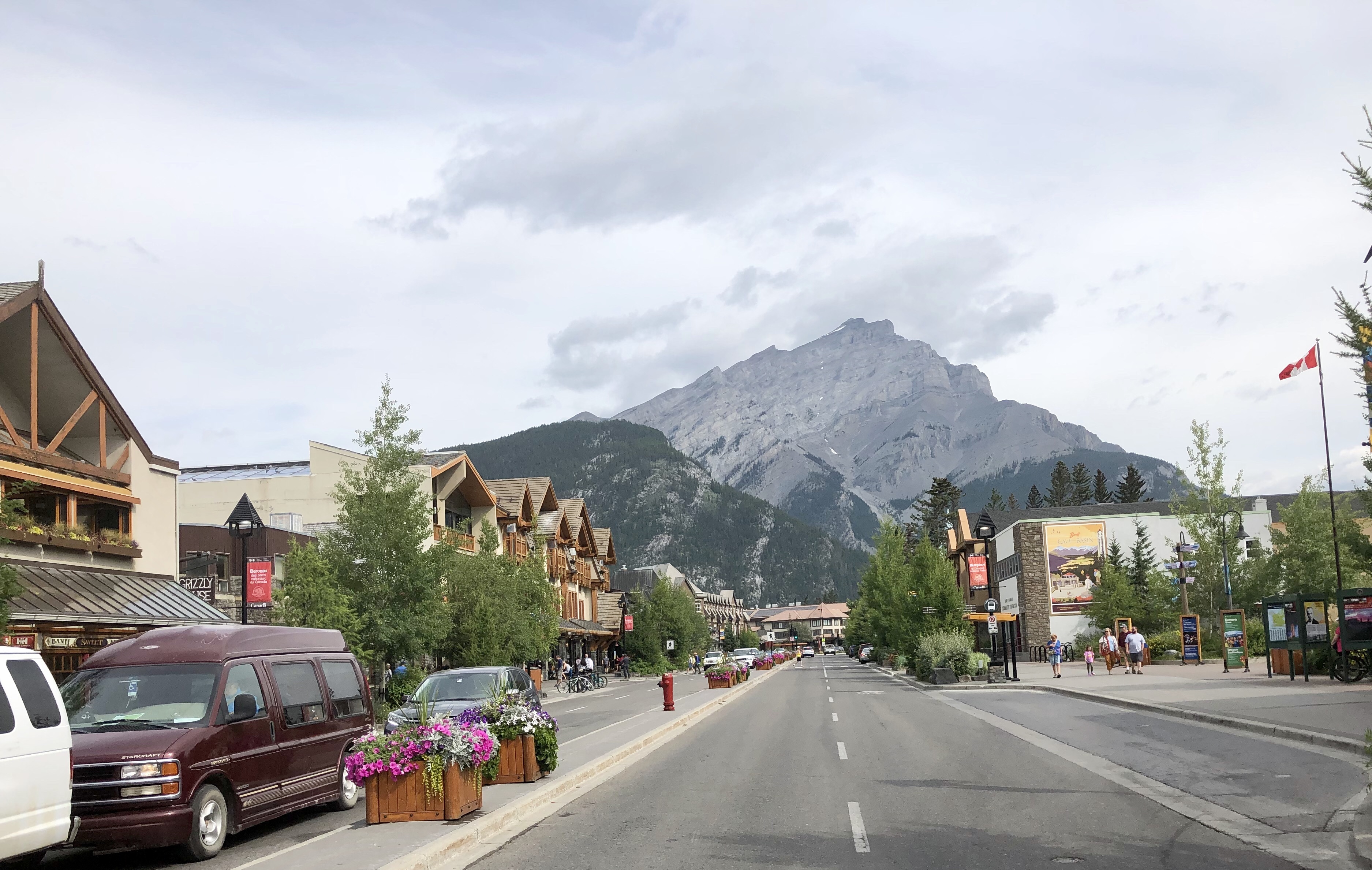


 The Canadian Rockies mountain range spans the provinces of British Columbia and Alberta. With jagged, ice-capped peaks, including towering Mt. Robson, it’s a region of alpine lakes, diverse wildlife and outdoor recreation sites. National parks in Alberta are Jasper, with the famously accessible Athabasca Glacier, and Banff, site of glacier-fed Lake Louise, which was the next, and arguably the most impressive, place we visited within Banff National Park, and perhaps anywhere on our entire trip.
The Canadian Rockies mountain range spans the provinces of British Columbia and Alberta. With jagged, ice-capped peaks, including towering Mt. Robson, it’s a region of alpine lakes, diverse wildlife and outdoor recreation sites. National parks in Alberta are Jasper, with the famously accessible Athabasca Glacier, and Banff, site of glacier-fed Lake Louise, which was the next, and arguably the most impressive, place we visited within Banff National Park, and perhaps anywhere on our entire trip.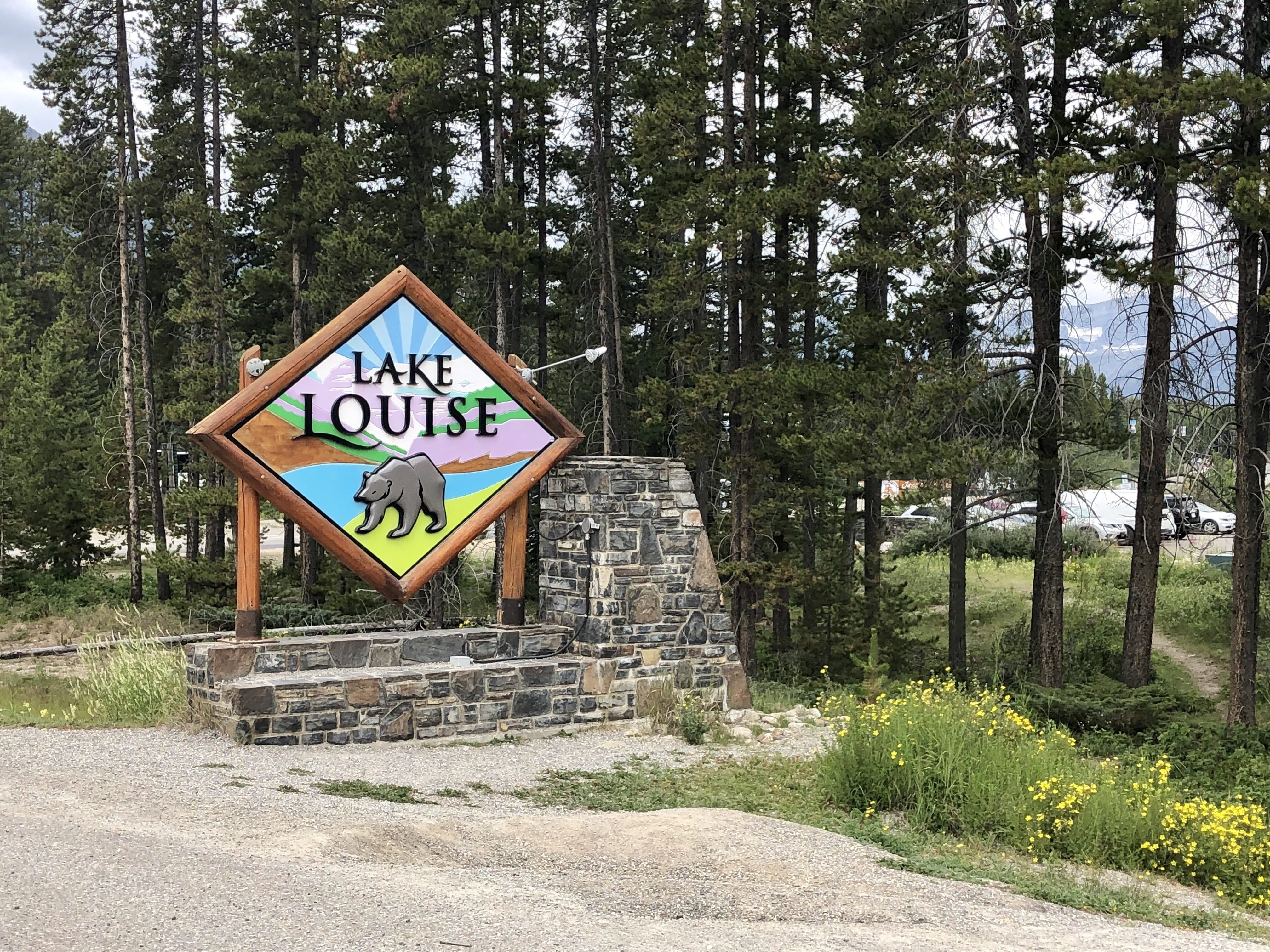


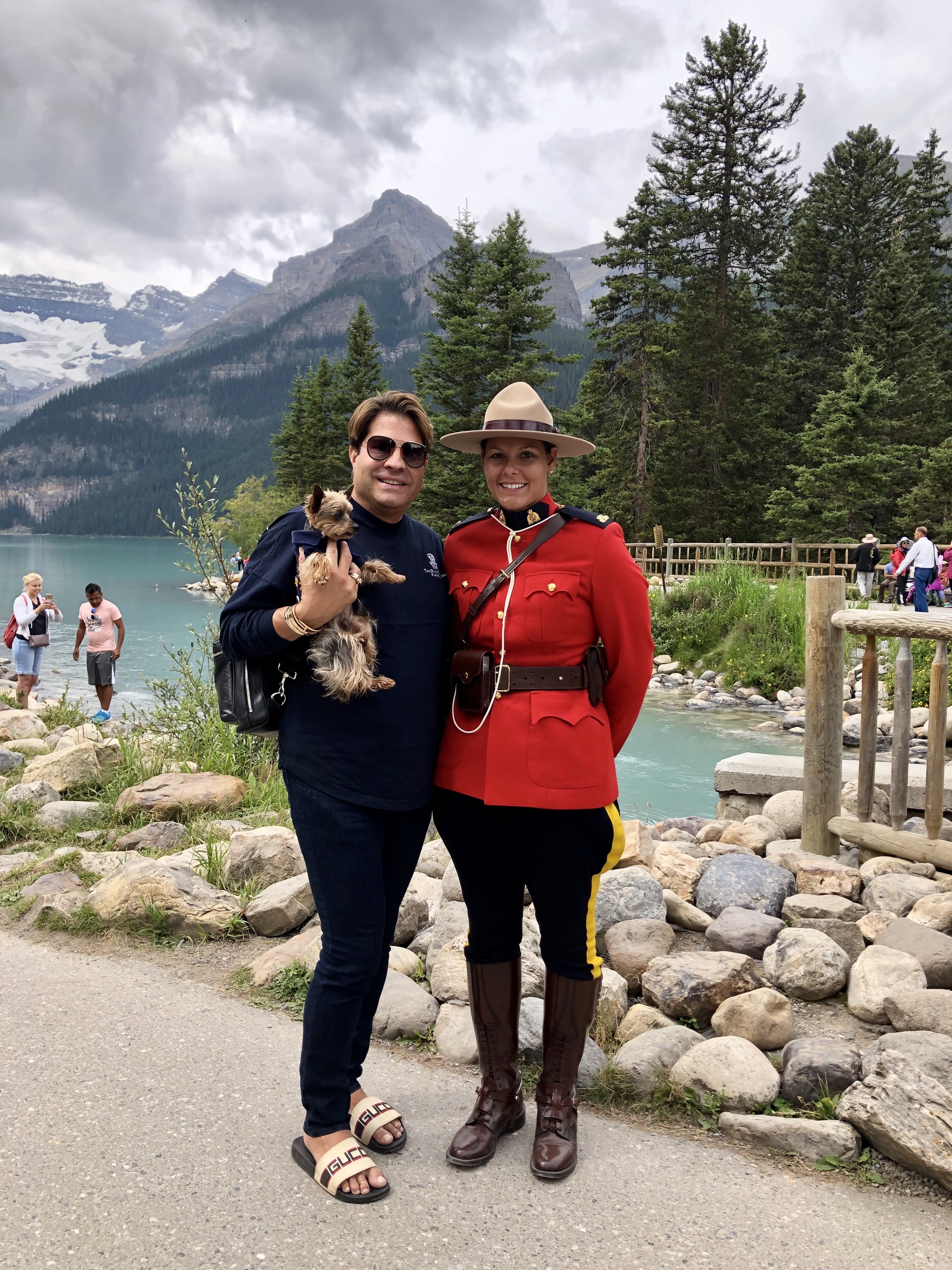
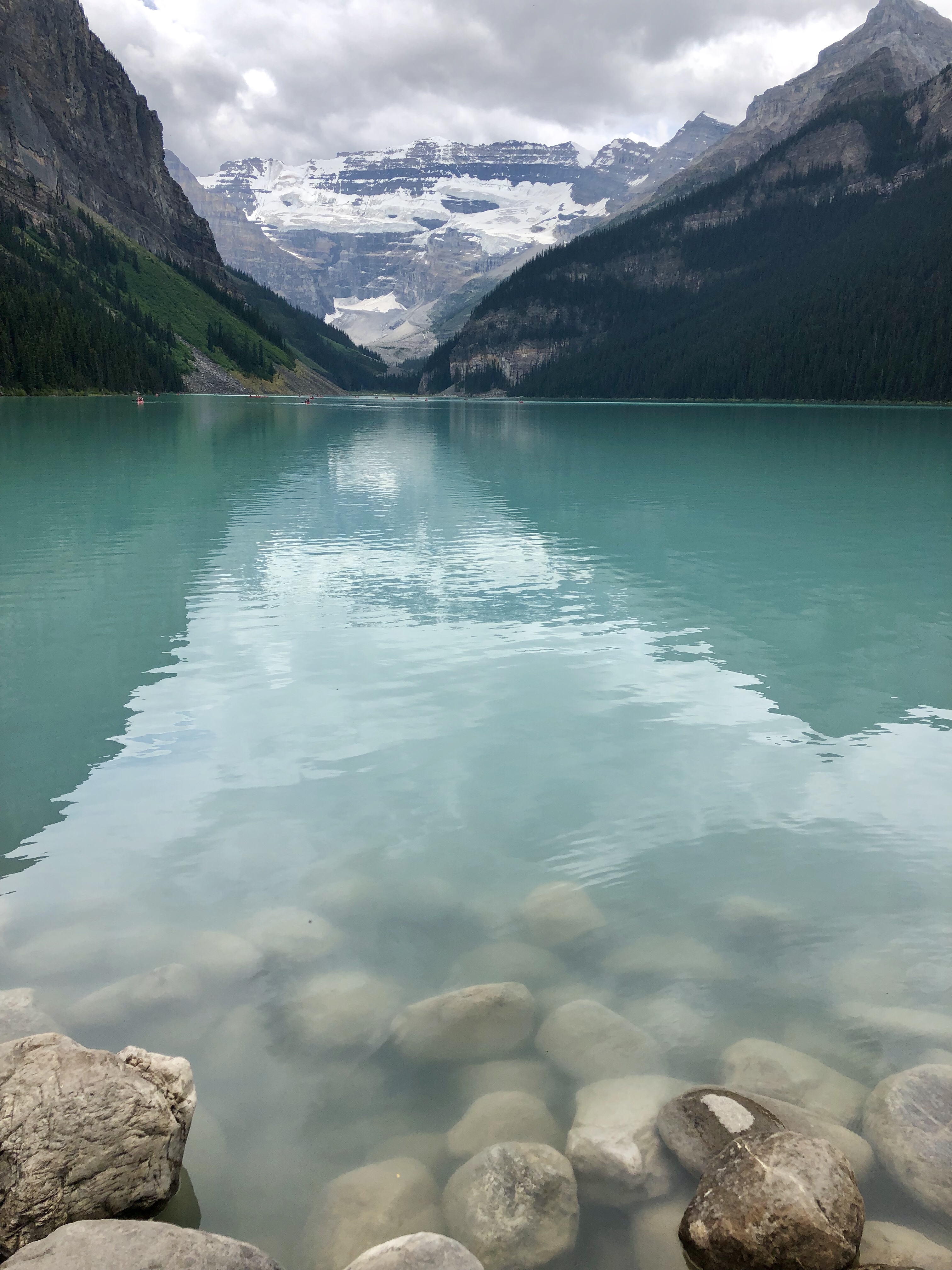
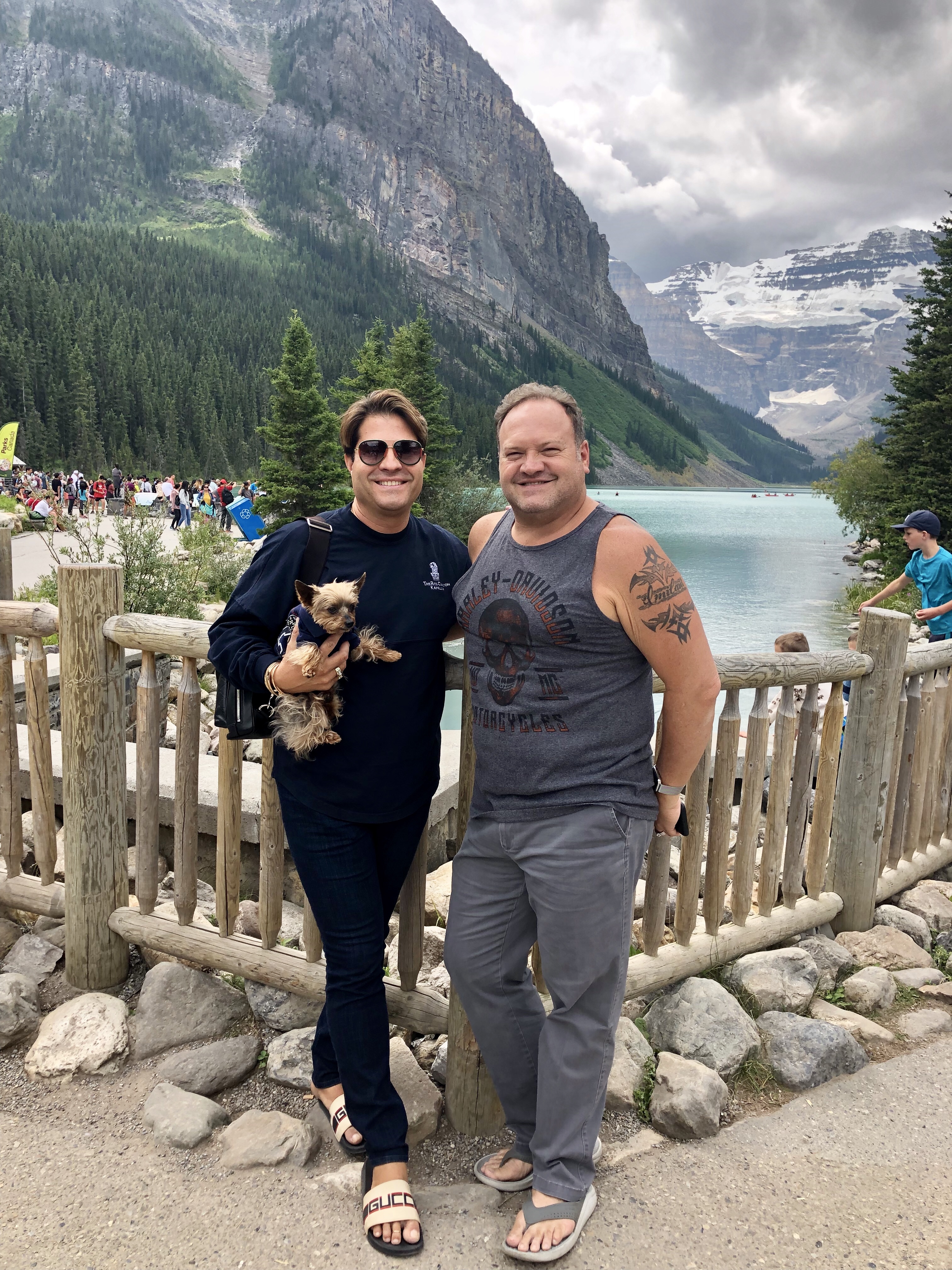


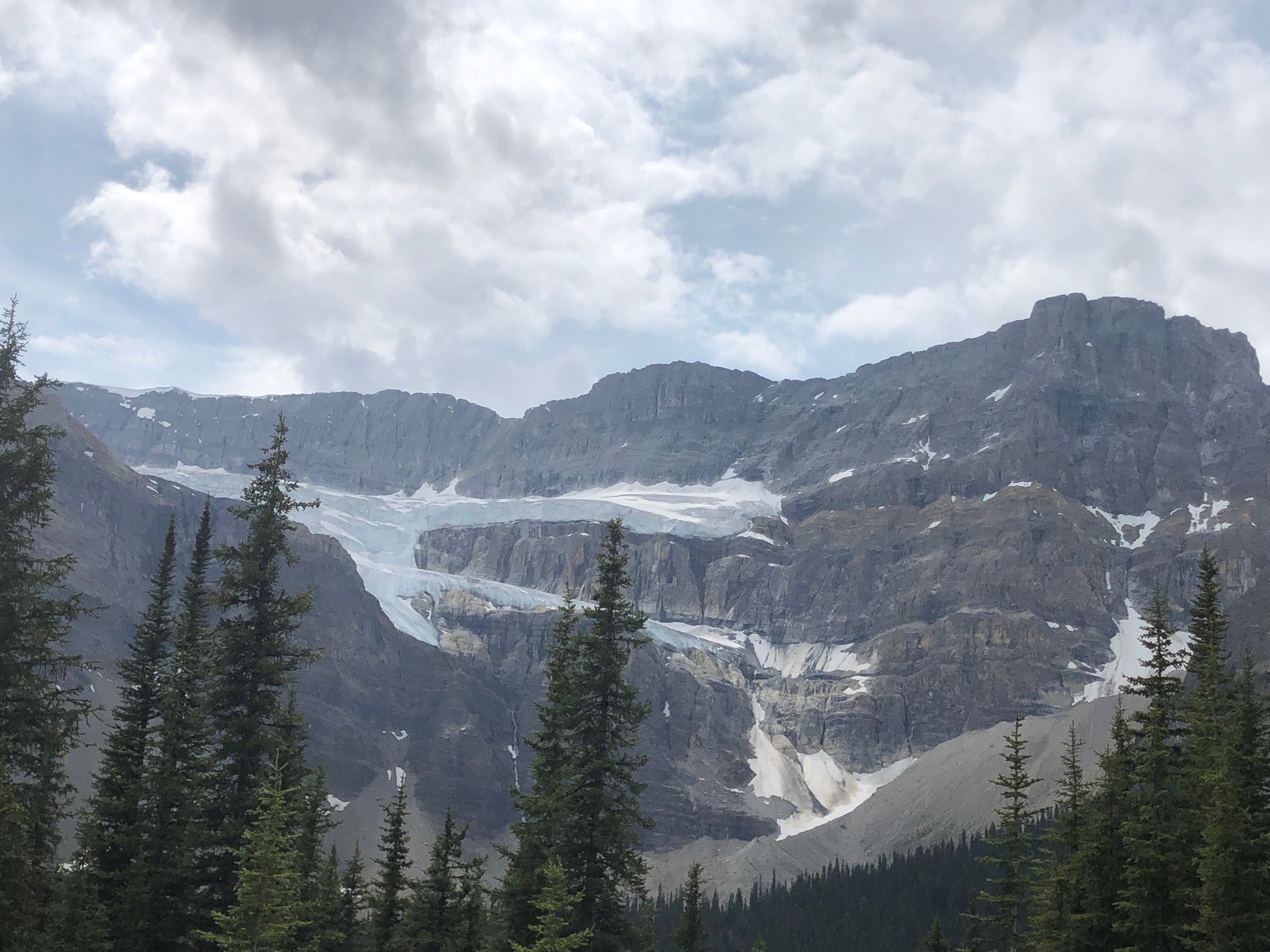


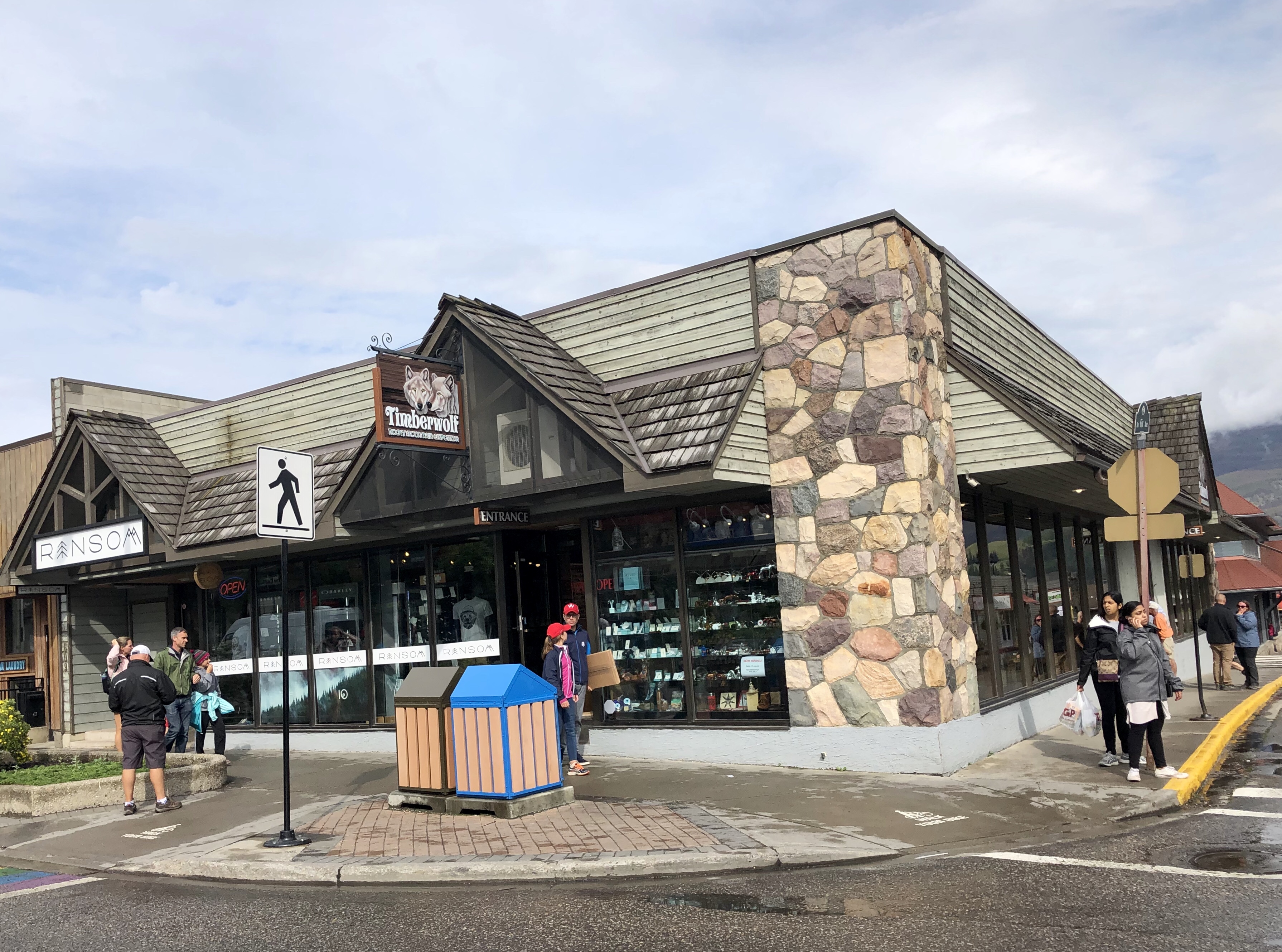


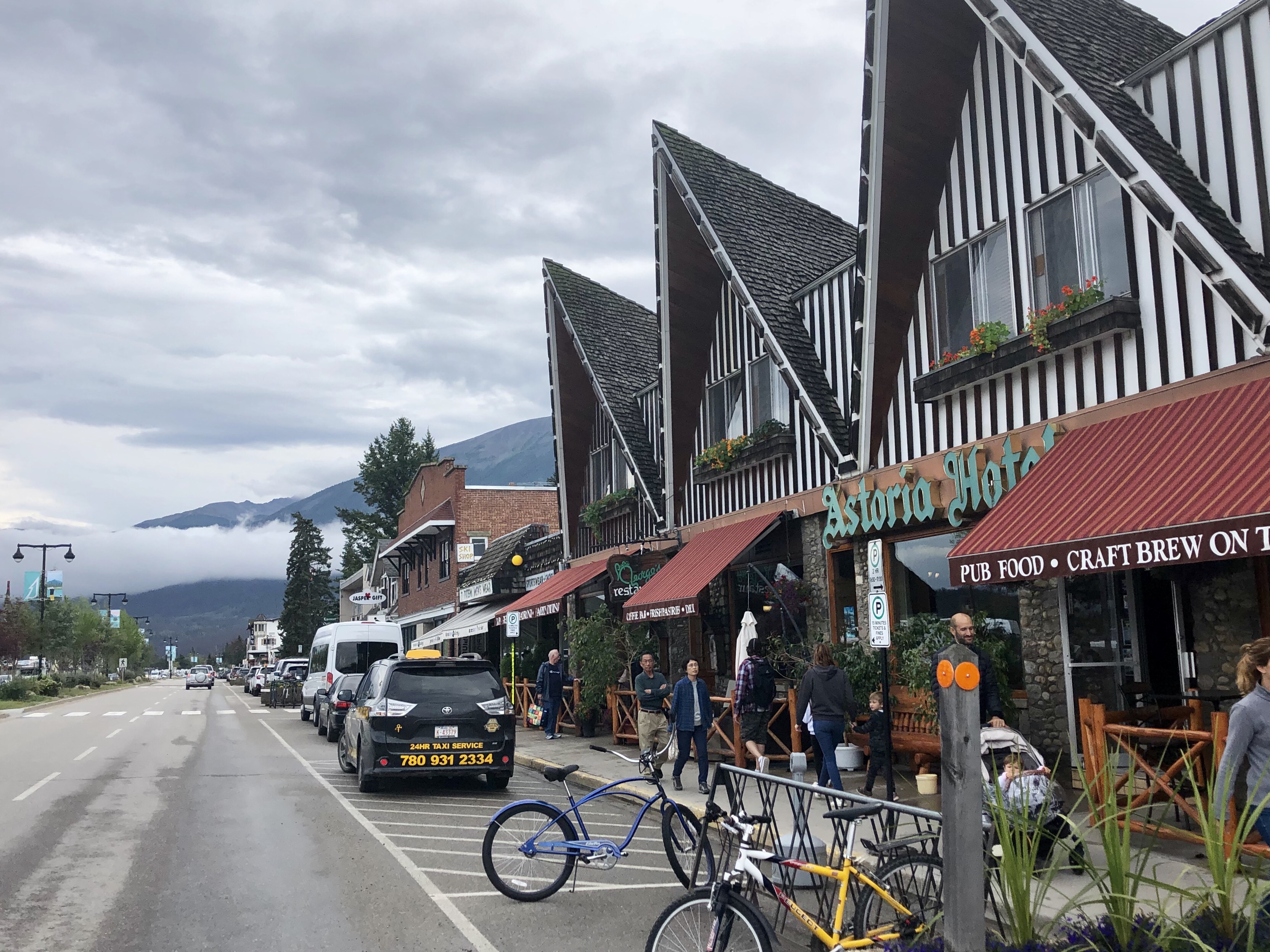

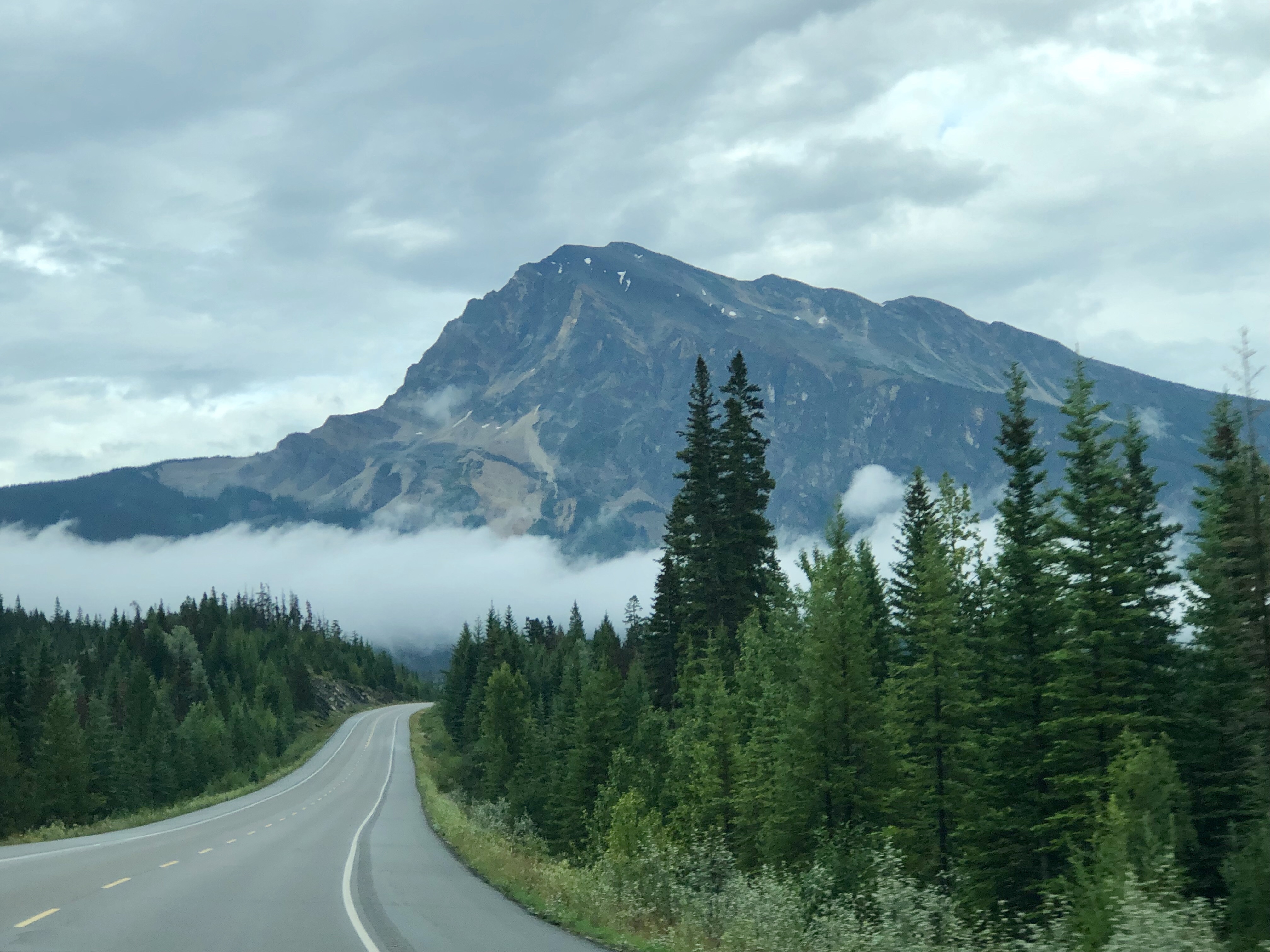 After leaving Canmore the next morning, we headed back to Kalispell, Montana where we had left the Yoder’s private tour bus at the campground. Our route back took us through Kootenay National Park in British Colombia. Break-neck views enchanted us at every curve in the road, from jagged mountain tops to Marble Canyon and from wildflowers and trees to countless rivers and streams with crystal-clear, blue waters.
After leaving Canmore the next morning, we headed back to Kalispell, Montana where we had left the Yoder’s private tour bus at the campground. Our route back took us through Kootenay National Park in British Colombia. Break-neck views enchanted us at every curve in the road, from jagged mountain tops to Marble Canyon and from wildflowers and trees to countless rivers and streams with crystal-clear, blue waters.
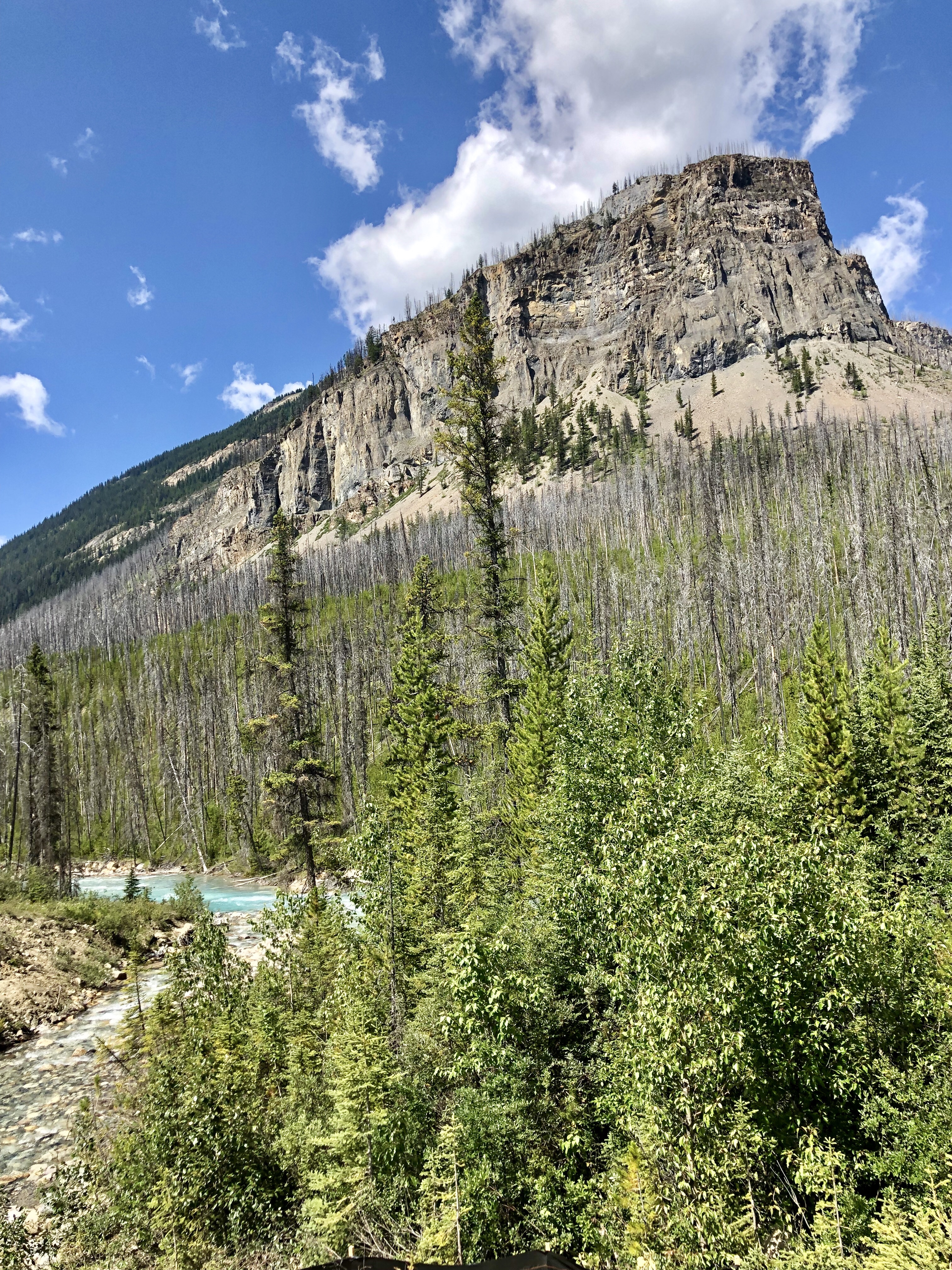
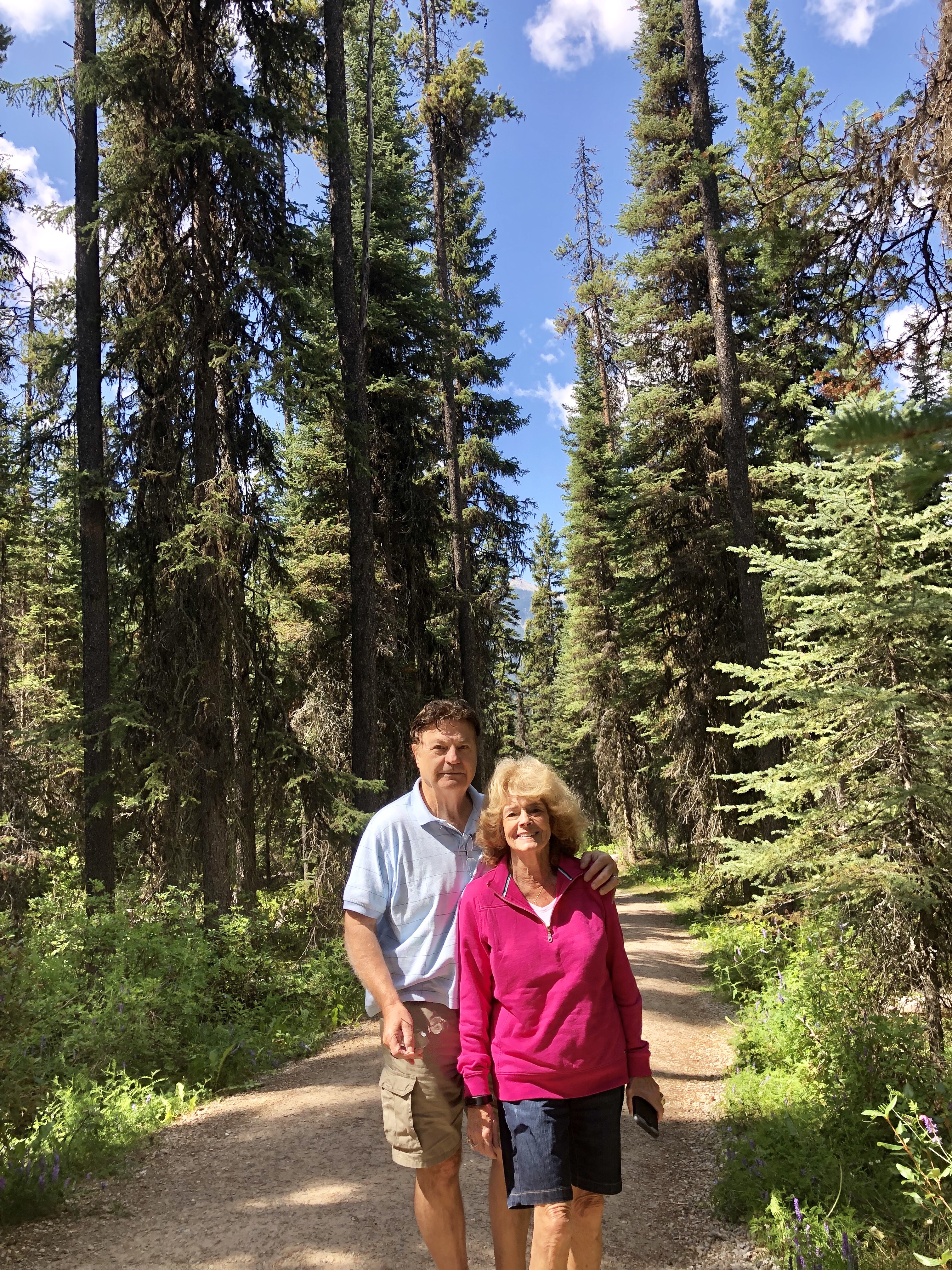







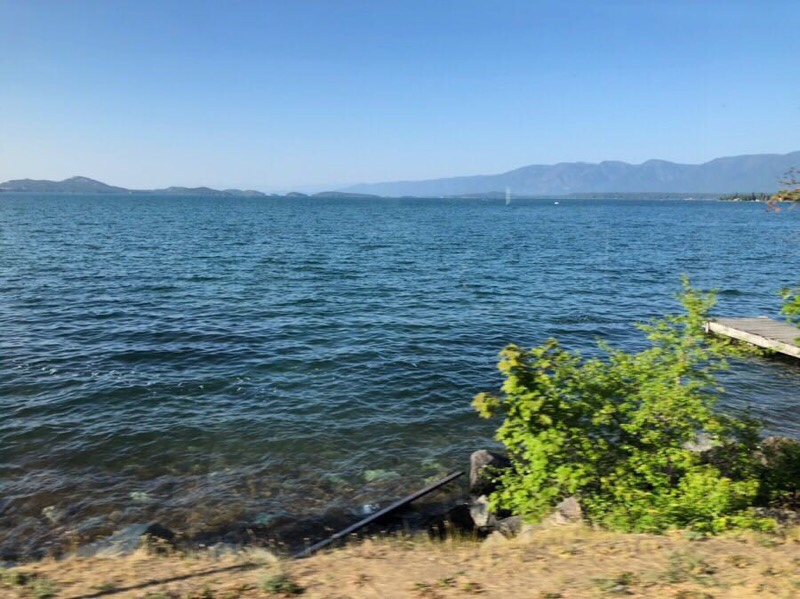 We parked the coach at the Greenwood Village Inn and Suites, which is a combination campground, mobile home park and hotel about 45 minutes outside of Glacier National Park. We rented a minivan to drive through the park, including the famous Going-to-the-Sun Road, and up into the Canadian Rockies.
We parked the coach at the Greenwood Village Inn and Suites, which is a combination campground, mobile home park and hotel about 45 minutes outside of Glacier National Park. We rented a minivan to drive through the park, including the famous Going-to-the-Sun Road, and up into the Canadian Rockies.



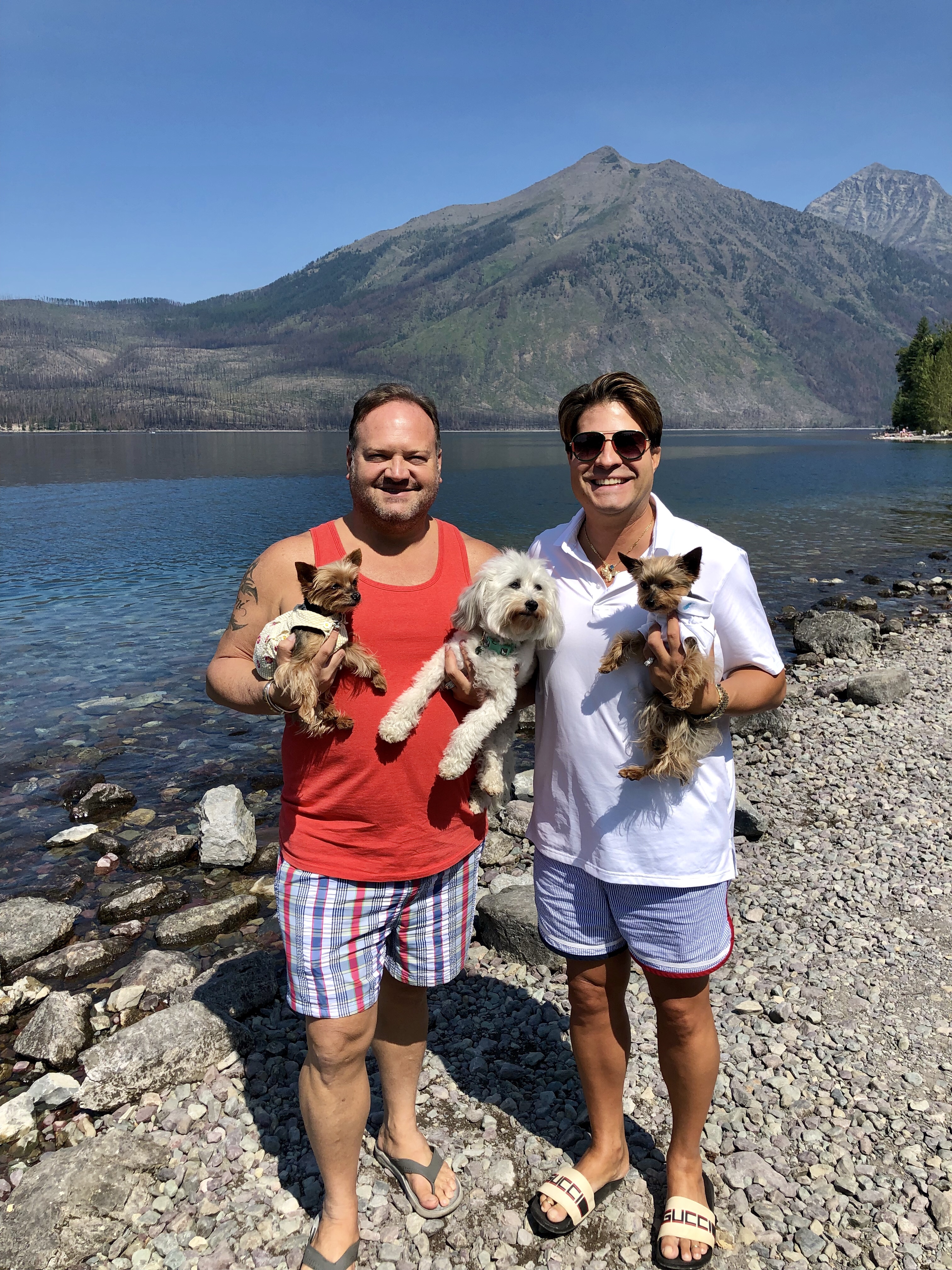


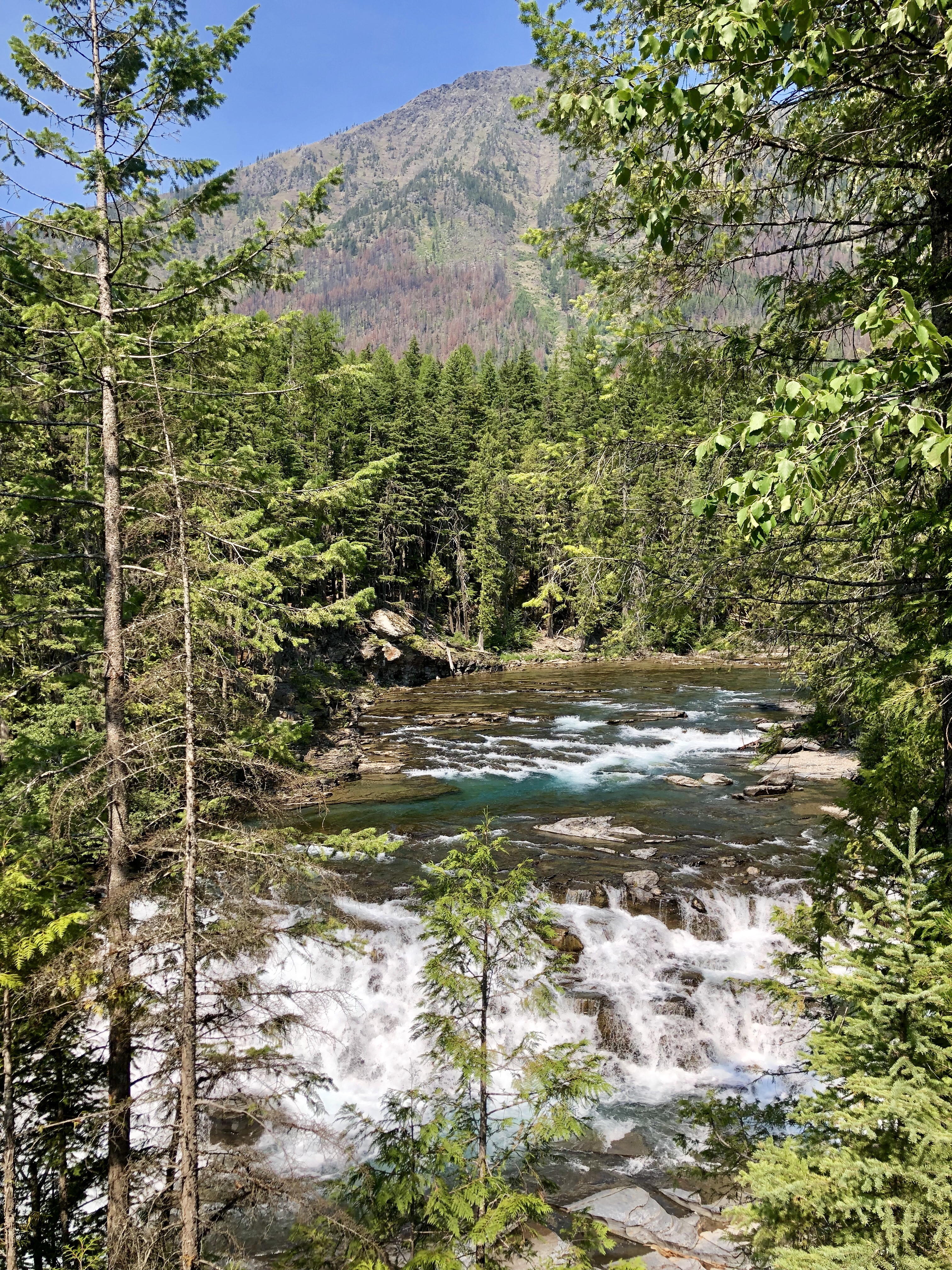

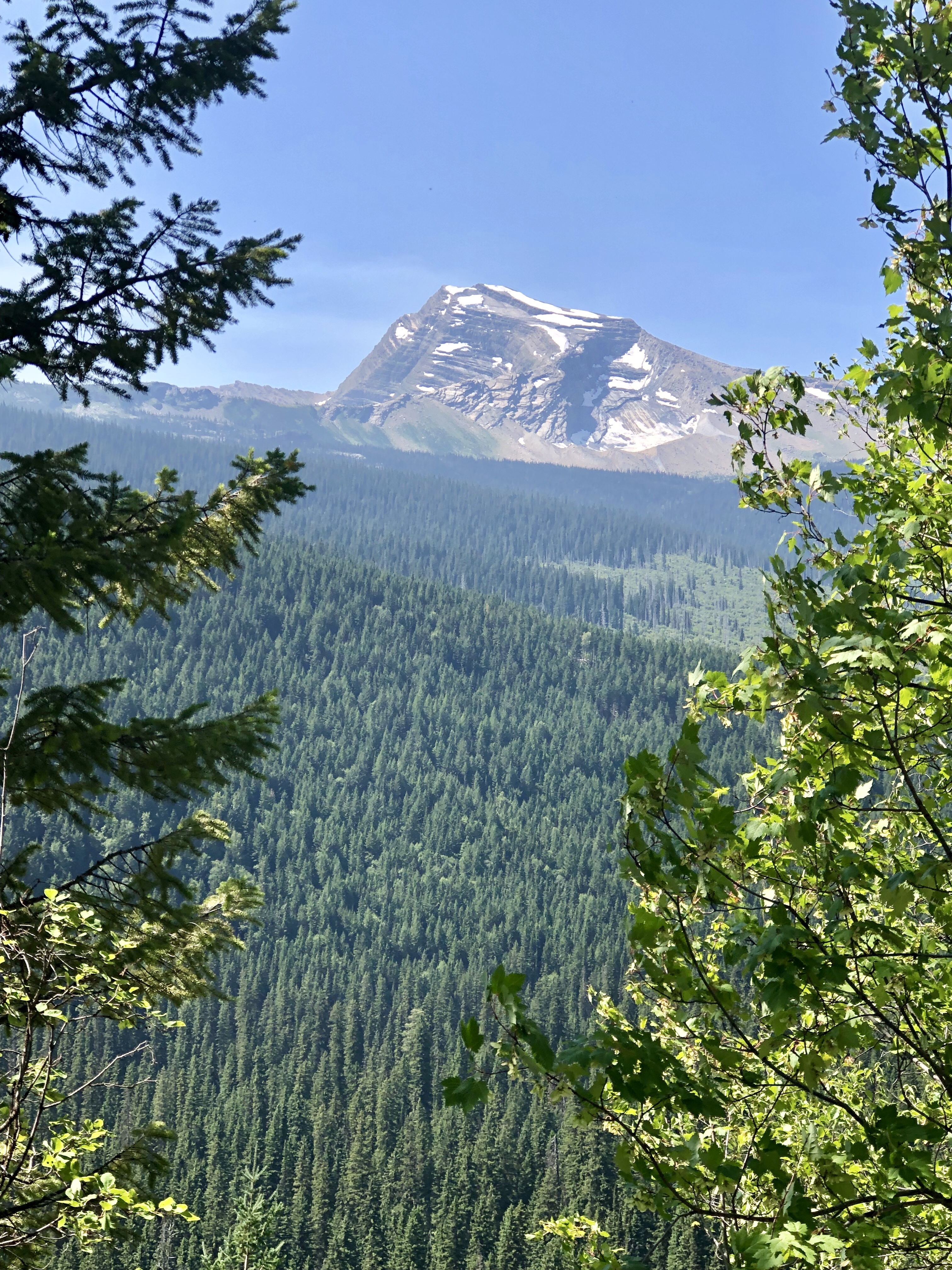








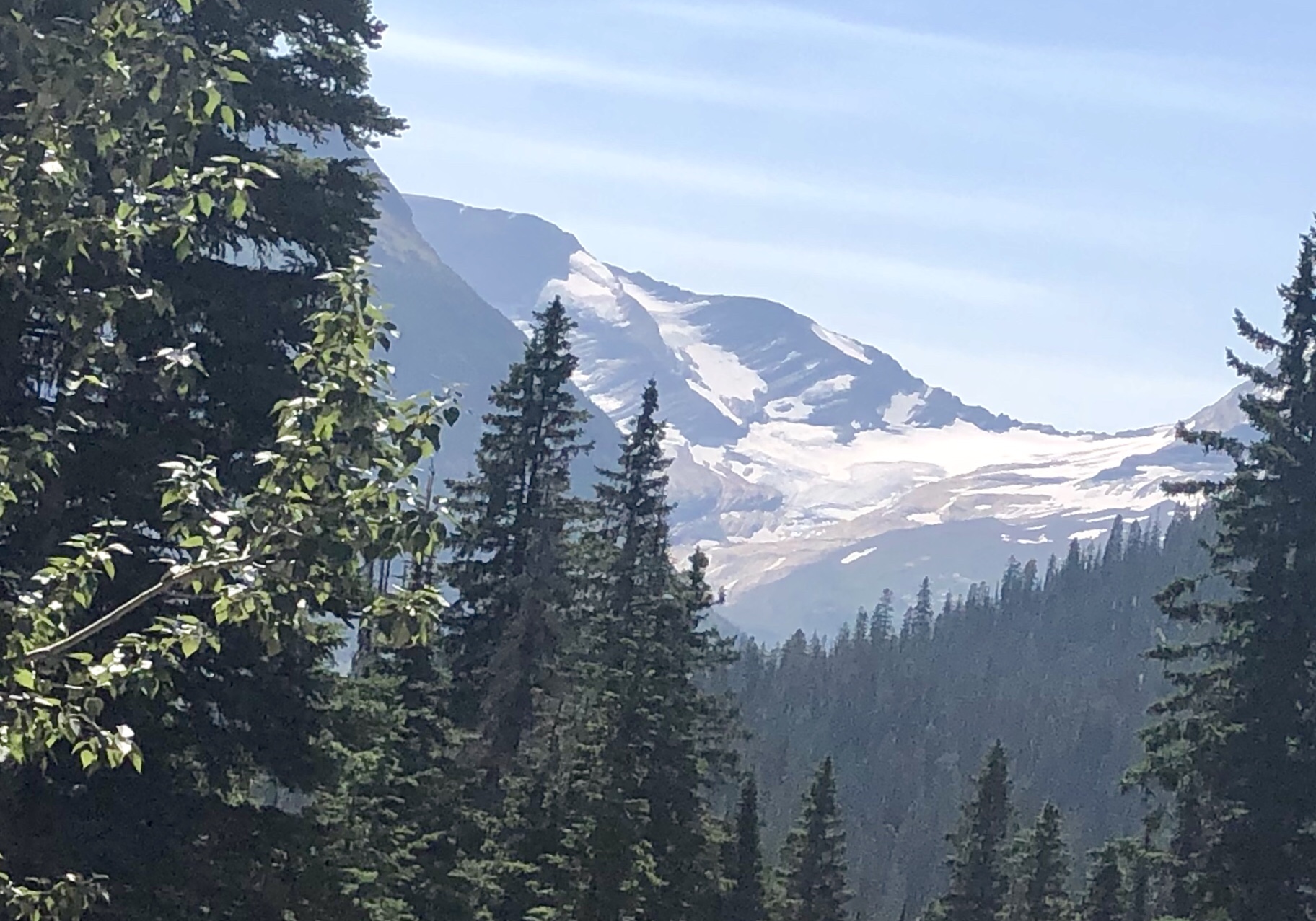
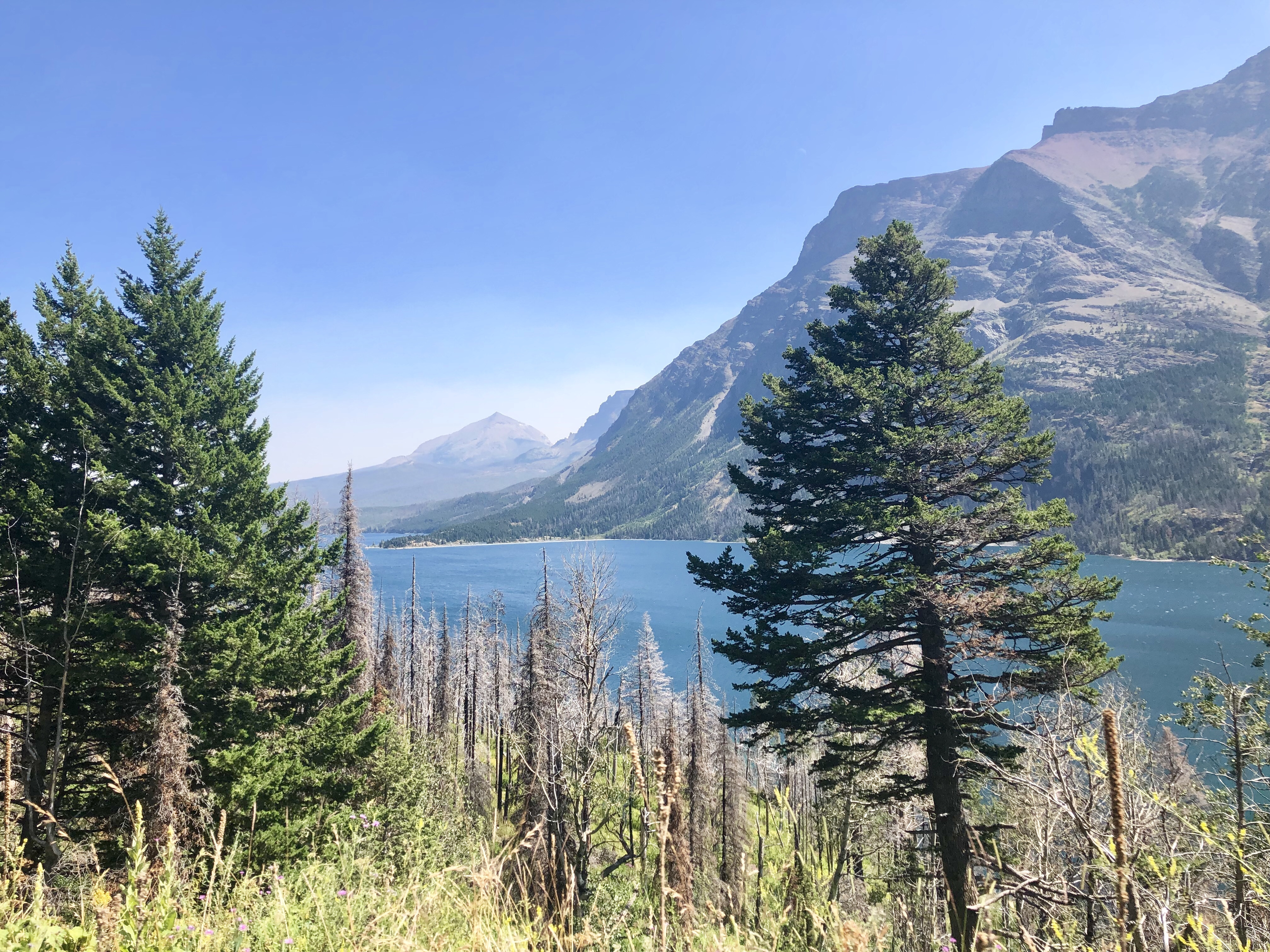

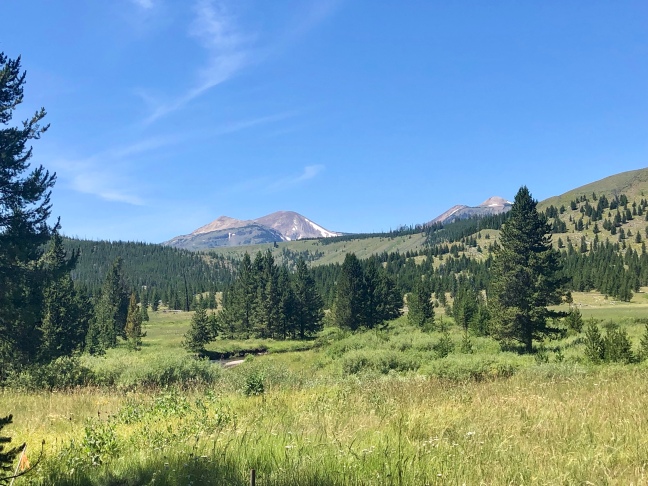

 We parked the RV at the KOA between Livingston and Yellowstone National Park along the banks of the Yellowstone River. We also booked rooms at the Yellowstone Pioneer Lodge in Livingston. There is a variety of newer lodging closer to the park, mostly in the quaint western town of Gardiner with a population of 875 residents. These options book far in advance and there are many annual repeat guests. Another beautiful option for parking motor homes that had no vacancy is the Yellowstone’s Edge RV park, with camp sites along the riverbank. We rented SUV’s to drive through the park.
We parked the RV at the KOA between Livingston and Yellowstone National Park along the banks of the Yellowstone River. We also booked rooms at the Yellowstone Pioneer Lodge in Livingston. There is a variety of newer lodging closer to the park, mostly in the quaint western town of Gardiner with a population of 875 residents. These options book far in advance and there are many annual repeat guests. Another beautiful option for parking motor homes that had no vacancy is the Yellowstone’s Edge RV park, with camp sites along the riverbank. We rented SUV’s to drive through the park.







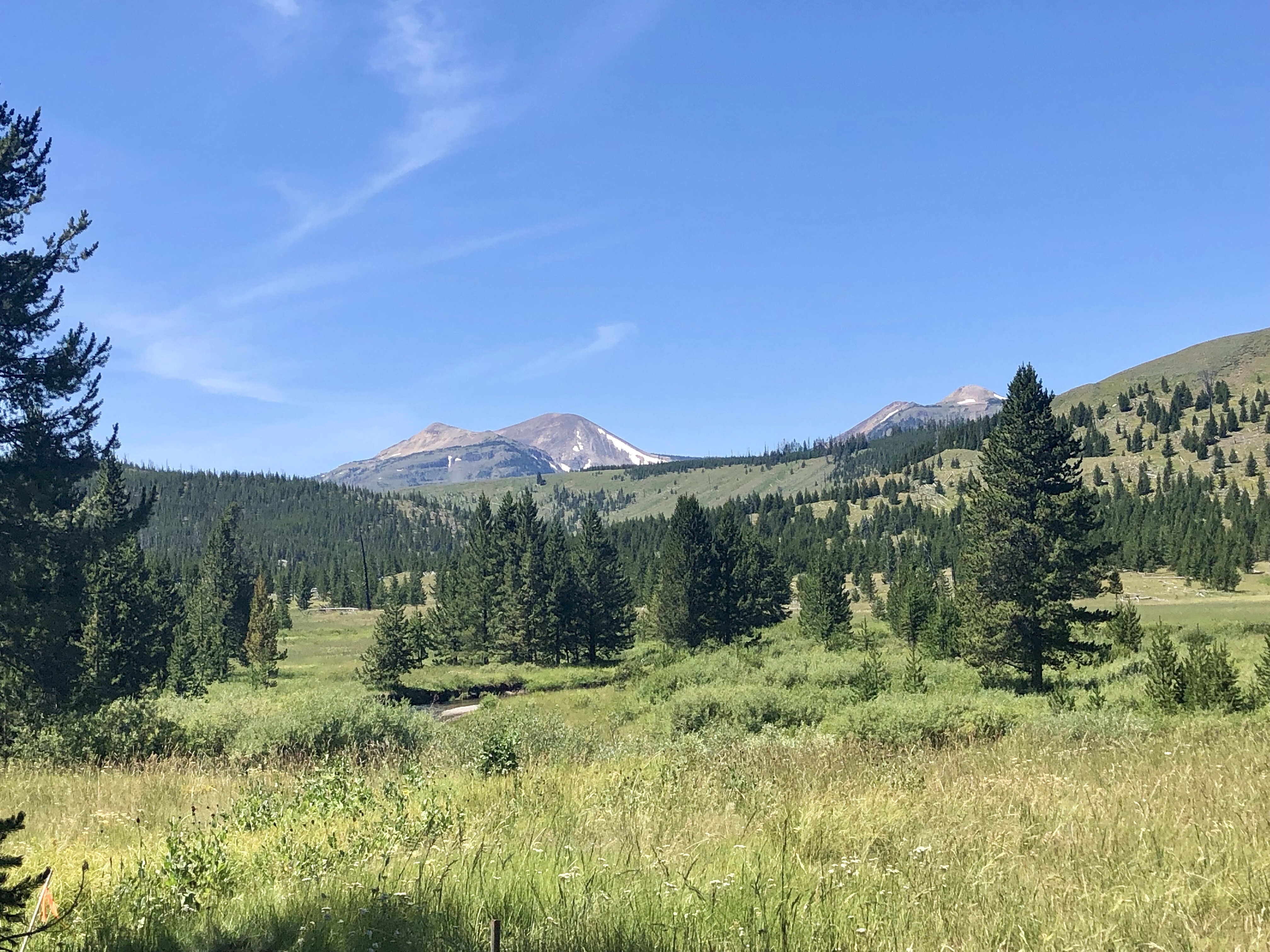
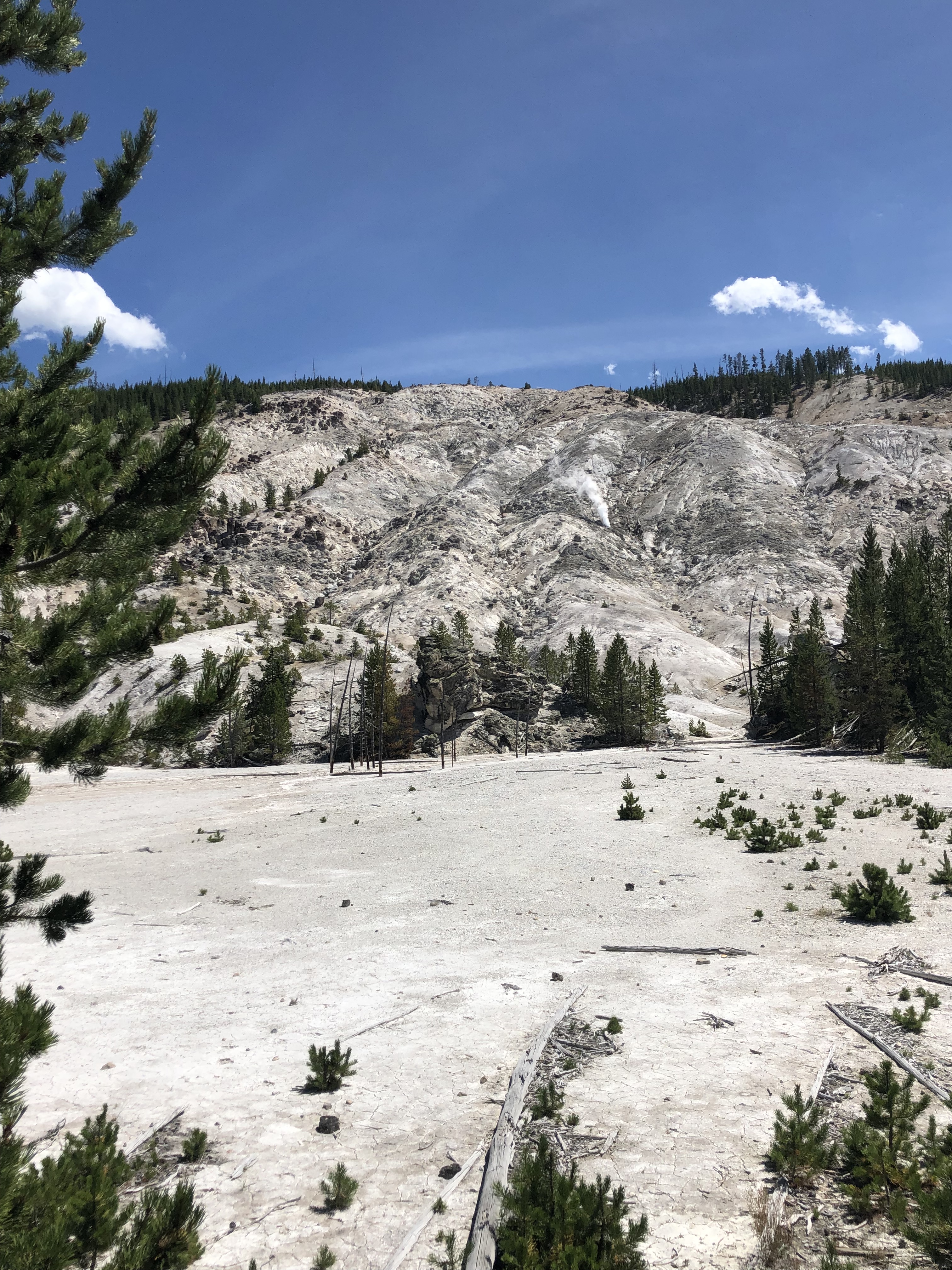








 We stood in the blazing hot afternoon sun as Old Faithful teased us before erupting into the sky where the steam generated by the explosion billowed into the air blending with ease into the cotton-like powdery white clouds that punctuated the bright blue skies. Discovered in 1870 by the Washburn Expedition, Old Faithful geyser was named for its frequent and somewhat predictable eruptions, which occur about every 90 minutes. After watching Mother Nature’s spectacular show, we had lunch at the cafeteria inside the lodge which also features a gift store and coffee shop.
We stood in the blazing hot afternoon sun as Old Faithful teased us before erupting into the sky where the steam generated by the explosion billowed into the air blending with ease into the cotton-like powdery white clouds that punctuated the bright blue skies. Discovered in 1870 by the Washburn Expedition, Old Faithful geyser was named for its frequent and somewhat predictable eruptions, which occur about every 90 minutes. After watching Mother Nature’s spectacular show, we had lunch at the cafeteria inside the lodge which also features a gift store and coffee shop.

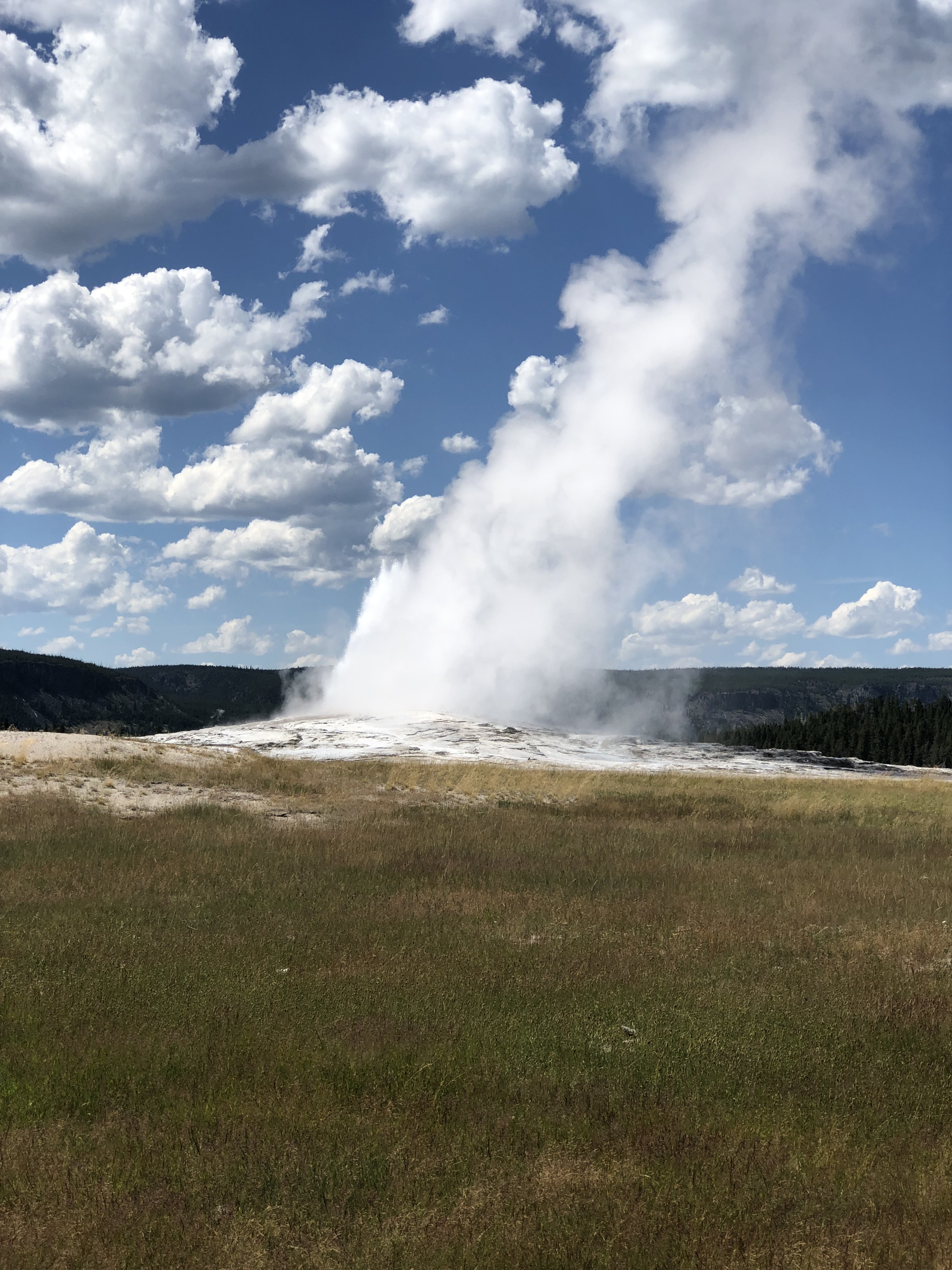
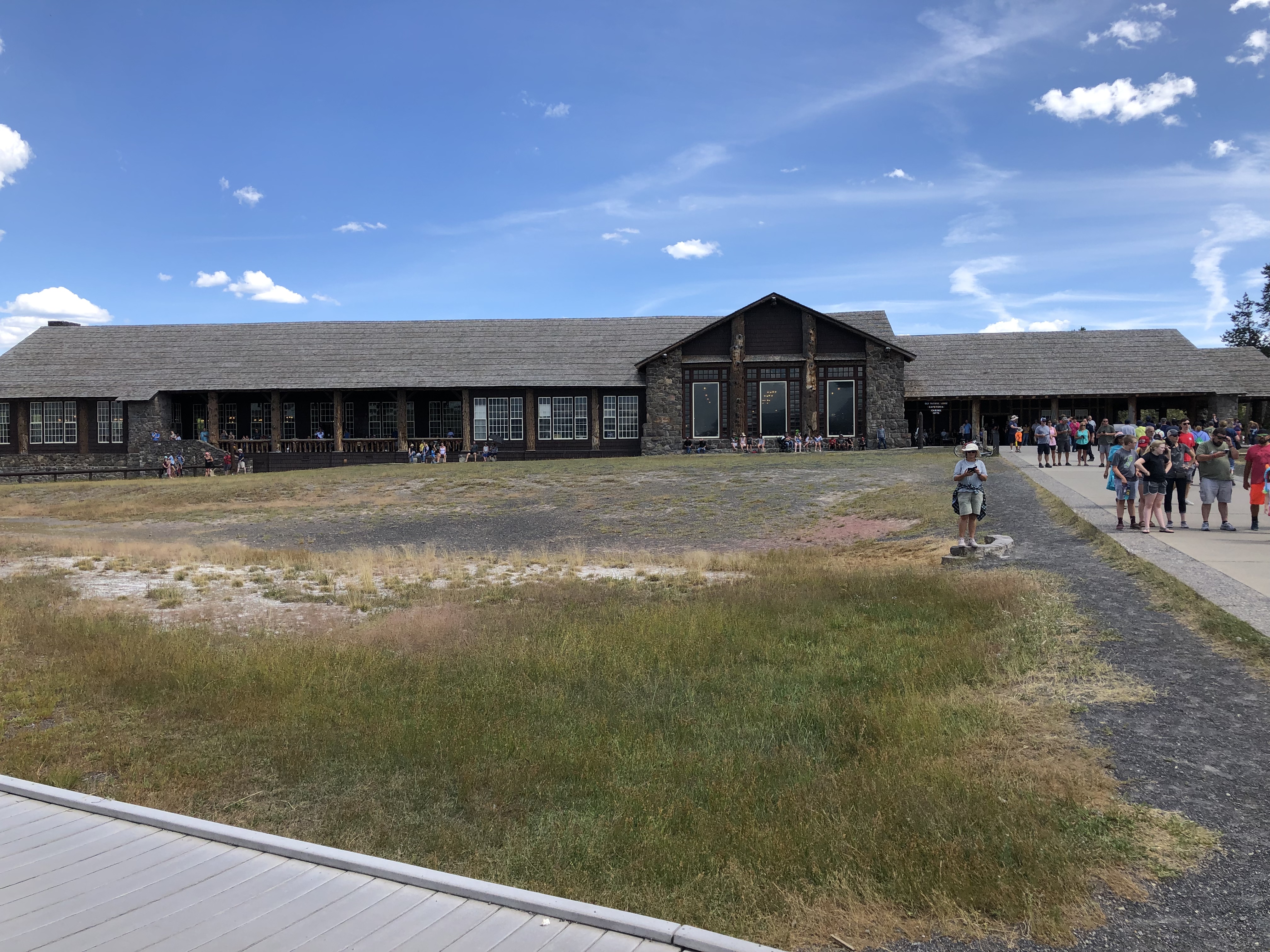 I had no idea that the Grand Canyon of the Yellowstone River existed. The canyon below the Lower Yellowstone Falls was at one time the site of a geyser basin that was the result of rhyolite lava flows, extensive faulting, and heat beneath the surface related to the hot spot. No one is sure exactly when the geyser basin was formed in the area, although it was probably present at the time of the last glaciation.
I had no idea that the Grand Canyon of the Yellowstone River existed. The canyon below the Lower Yellowstone Falls was at one time the site of a geyser basin that was the result of rhyolite lava flows, extensive faulting, and heat beneath the surface related to the hot spot. No one is sure exactly when the geyser basin was formed in the area, although it was probably present at the time of the last glaciation.


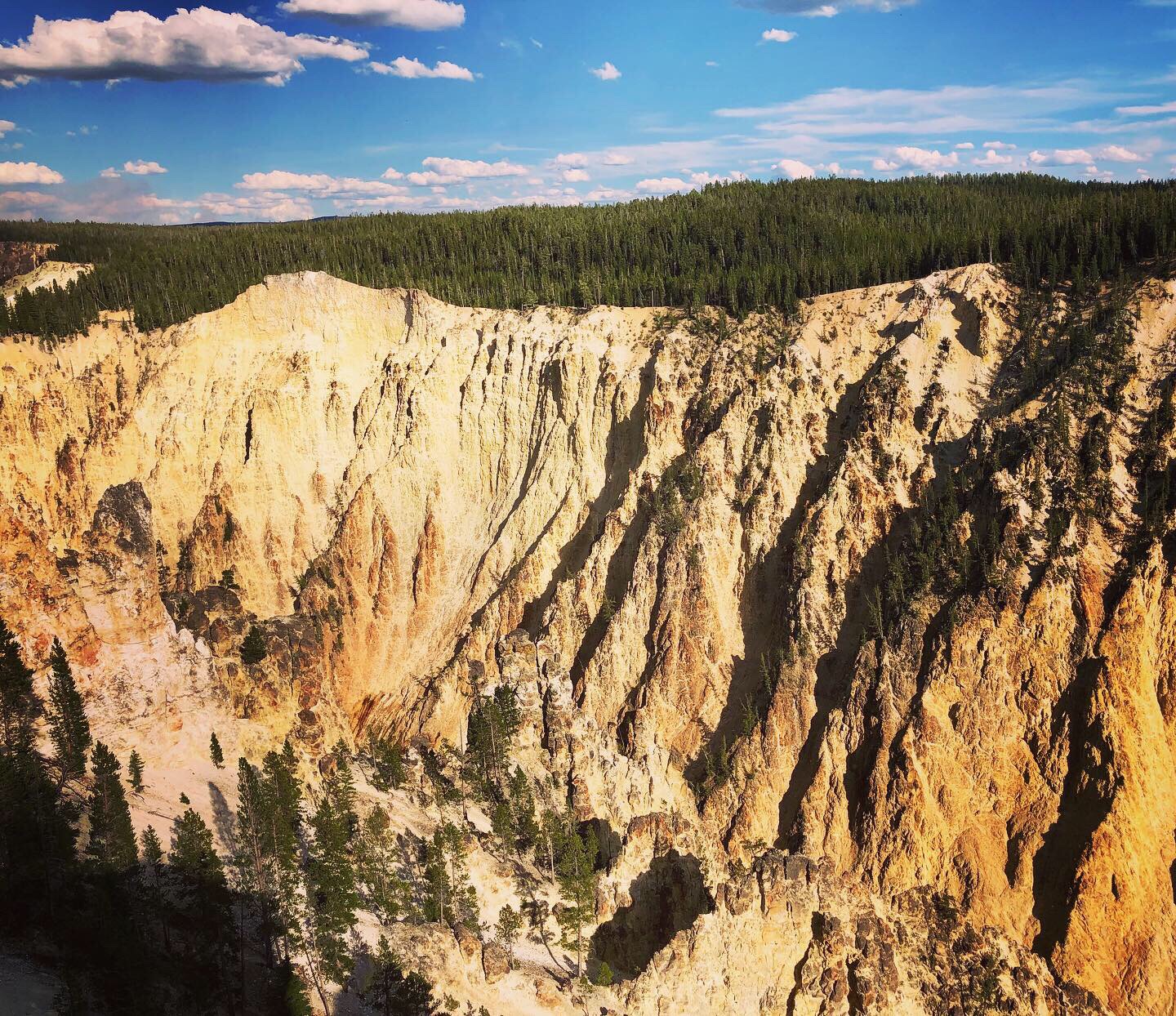
 As development spread across the West, the 2.2 million acres of habitat within the park became an important sanctuary for the largest concentration of wildlife in the lower 48 states. The abundance and distribution of these animal species depend on their interactions with each other and on the quality of their habitats, which in turn is the result of thousands of years of volcanic activity, forest fires, changes in climate, and more recent natural and human influences.
As development spread across the West, the 2.2 million acres of habitat within the park became an important sanctuary for the largest concentration of wildlife in the lower 48 states. The abundance and distribution of these animal species depend on their interactions with each other and on the quality of their habitats, which in turn is the result of thousands of years of volcanic activity, forest fires, changes in climate, and more recent natural and human influences.

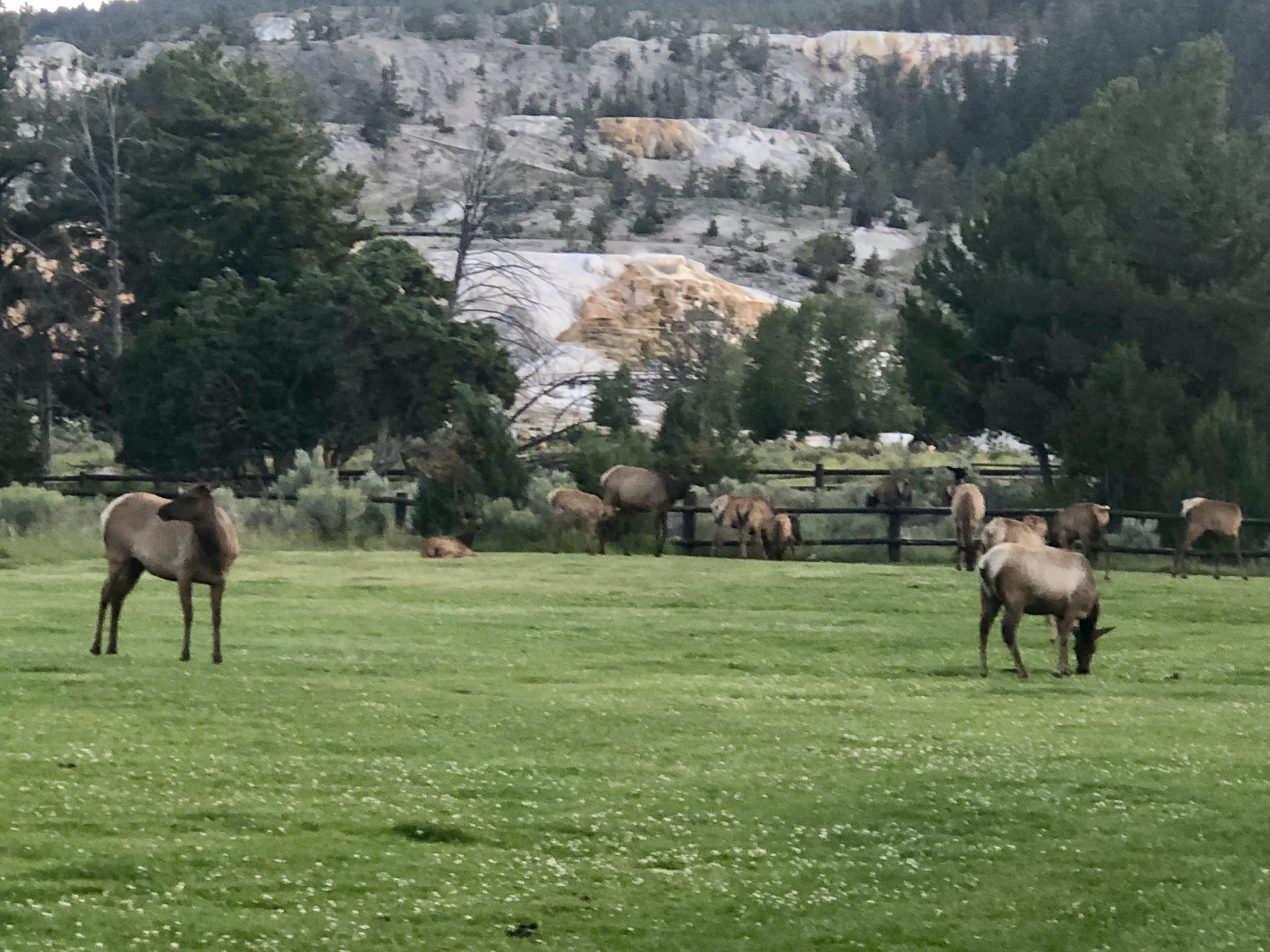
 We stopped in Gardiner on our way out of Yellowstone. Quaint, Old West-style Gardiner sits on the north edge of Yellowstone, making it a convenient gateway town. It’s the only year-round entrance to the park. Pretty much everything in Gardiner is colorful from the scenery and people to the names of dishes on menus.
We stopped in Gardiner on our way out of Yellowstone. Quaint, Old West-style Gardiner sits on the north edge of Yellowstone, making it a convenient gateway town. It’s the only year-round entrance to the park. Pretty much everything in Gardiner is colorful from the scenery and people to the names of dishes on menus.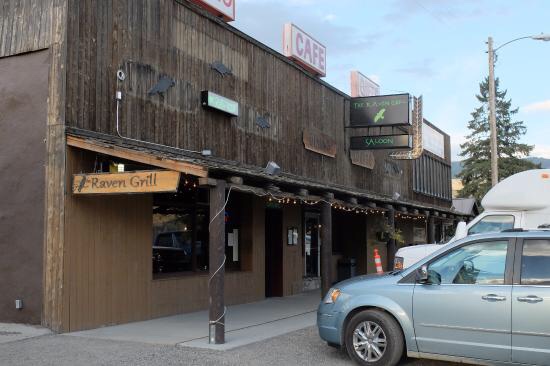
 Montana is known as “Big Sky Country” and on the ride back to town after dinner we were treated to a sublime lighting show that illuminated the outline of the mountains in the otherwise pitch-black sky. Before hitting the road for the next destination, Glacier National Park, on our epic road trip through the North American Wild West, we fulfilled the lifelong wish of the family matriarch, Geri Yoder. Mama G commented that the river streaming through the park took her breath away. “I wish I was back in my 30’s and could run down and dip my toes in that river.” We found a spot with easy access to the water near the campground and she giggled with excitement as she stuck her feet in the Yellowstone River.
Montana is known as “Big Sky Country” and on the ride back to town after dinner we were treated to a sublime lighting show that illuminated the outline of the mountains in the otherwise pitch-black sky. Before hitting the road for the next destination, Glacier National Park, on our epic road trip through the North American Wild West, we fulfilled the lifelong wish of the family matriarch, Geri Yoder. Mama G commented that the river streaming through the park took her breath away. “I wish I was back in my 30’s and could run down and dip my toes in that river.” We found a spot with easy access to the water near the campground and she giggled with excitement as she stuck her feet in the Yellowstone River. Travel is about fulfilling dreams and making memories. The joy of shared experiences bonds a family together.
Travel is about fulfilling dreams and making memories. The joy of shared experiences bonds a family together.

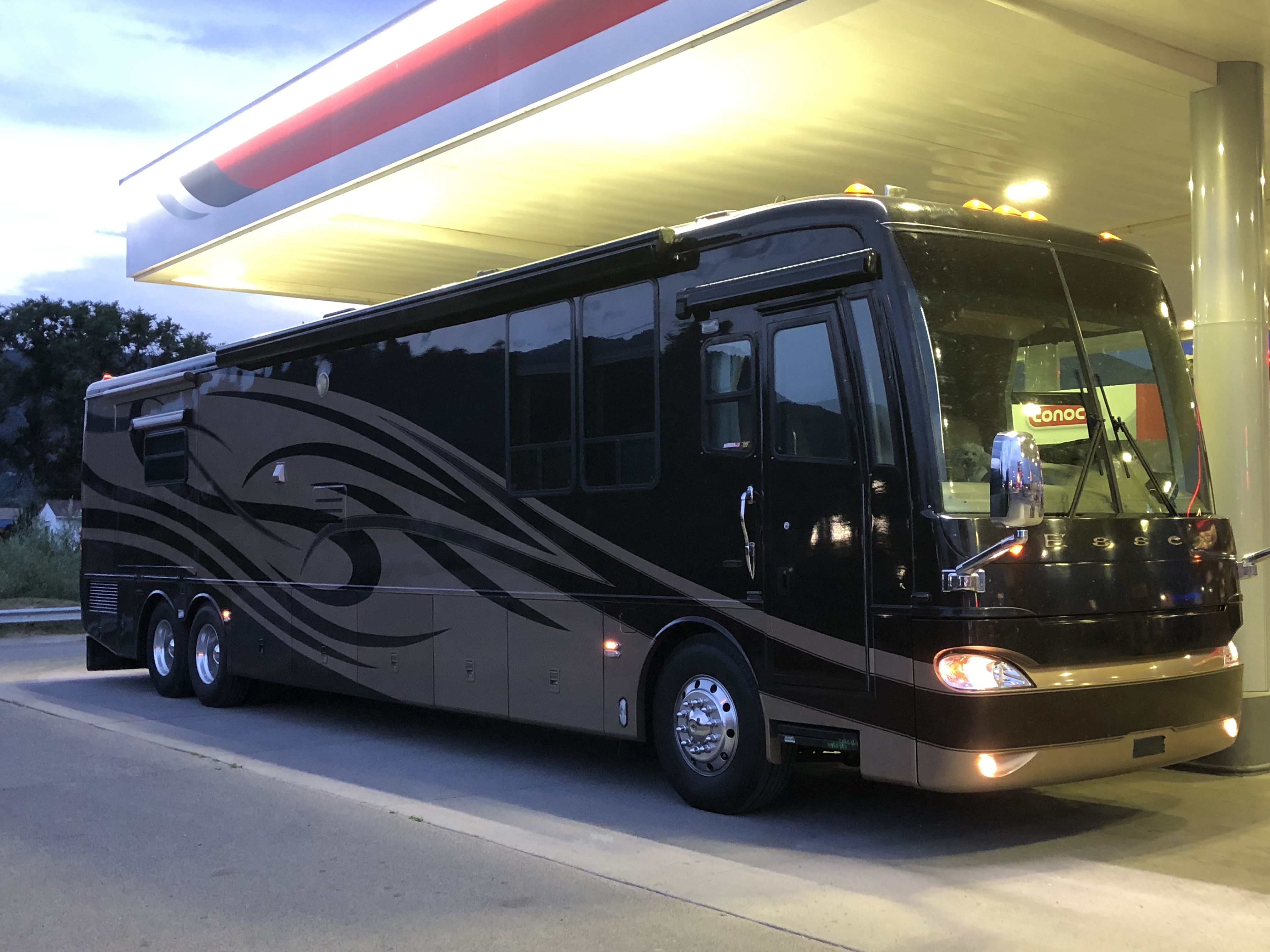 Our first stop was the iconic Mount Rushmore. About a 20 minute drive from Rapid City, Mount Rushmore National Memorial is a massive sculpture carved into the Black Hills region of South Dakota. Completed in 1941 under the direction of Gutzon Borglum and his son Lincoln, the sculpture’s roughly 60-ft.-high granite faces depict U.S. Presidents George Washington, Thomas Jefferson, Theodore Roosevelt and Abraham Lincoln. The site also features a museum with interactive exhibits. Having seen the monument on everything from post cards to television and history books to cartoons, it was gratifying to behold in person. Sam’s Mom, Geri Yoder, whom we affectionately call “Mama G” remarked that it had such an impact on her that she would have been satisfied if the sojourn had ended there. However, there was so much more to explore.
Our first stop was the iconic Mount Rushmore. About a 20 minute drive from Rapid City, Mount Rushmore National Memorial is a massive sculpture carved into the Black Hills region of South Dakota. Completed in 1941 under the direction of Gutzon Borglum and his son Lincoln, the sculpture’s roughly 60-ft.-high granite faces depict U.S. Presidents George Washington, Thomas Jefferson, Theodore Roosevelt and Abraham Lincoln. The site also features a museum with interactive exhibits. Having seen the monument on everything from post cards to television and history books to cartoons, it was gratifying to behold in person. Sam’s Mom, Geri Yoder, whom we affectionately call “Mama G” remarked that it had such an impact on her that she would have been satisfied if the sojourn had ended there. However, there was so much more to explore.

 About 10-15 minutes down the road is Crazy Horse Memorial. Crazy Horse is the world’s largest mountain carving located in the Black Hills of South Dakota. It is considered The Eighth Wonder of the World in progress. The Mission of Crazy Horse Memorial Foundation is to protect and preserve the culture, tradition and living heritage of the North American Indians. Impressively, the site features a museum and university.
About 10-15 minutes down the road is Crazy Horse Memorial. Crazy Horse is the world’s largest mountain carving located in the Black Hills of South Dakota. It is considered The Eighth Wonder of the World in progress. The Mission of Crazy Horse Memorial Foundation is to protect and preserve the culture, tradition and living heritage of the North American Indians. Impressively, the site features a museum and university. We made our way along the breathtaking Needles Highway stopping for reflective photos at Sylvan Lake with its mammoth rock formations jutting up from the water like a movie set. This heavenly slice of Americana evoked patriotism and childhood memories. At one point, Sam started singing “Home on the Range” while driving the green hills and pastures of Custer Park before coming upon a heard of wild buffalo. This is, after all, where “the buffalo roam and the deer and the antelope play.” The giant creatures literally surrounded our vehicles and reminded my parents and I of being on safari in Africa, especially when we saw elongated, open-air Jeeps emblazoned with “Buffalo Safari” logos.
We made our way along the breathtaking Needles Highway stopping for reflective photos at Sylvan Lake with its mammoth rock formations jutting up from the water like a movie set. This heavenly slice of Americana evoked patriotism and childhood memories. At one point, Sam started singing “Home on the Range” while driving the green hills and pastures of Custer Park before coming upon a heard of wild buffalo. This is, after all, where “the buffalo roam and the deer and the antelope play.” The giant creatures literally surrounded our vehicles and reminded my parents and I of being on safari in Africa, especially when we saw elongated, open-air Jeeps emblazoned with “Buffalo Safari” logos.






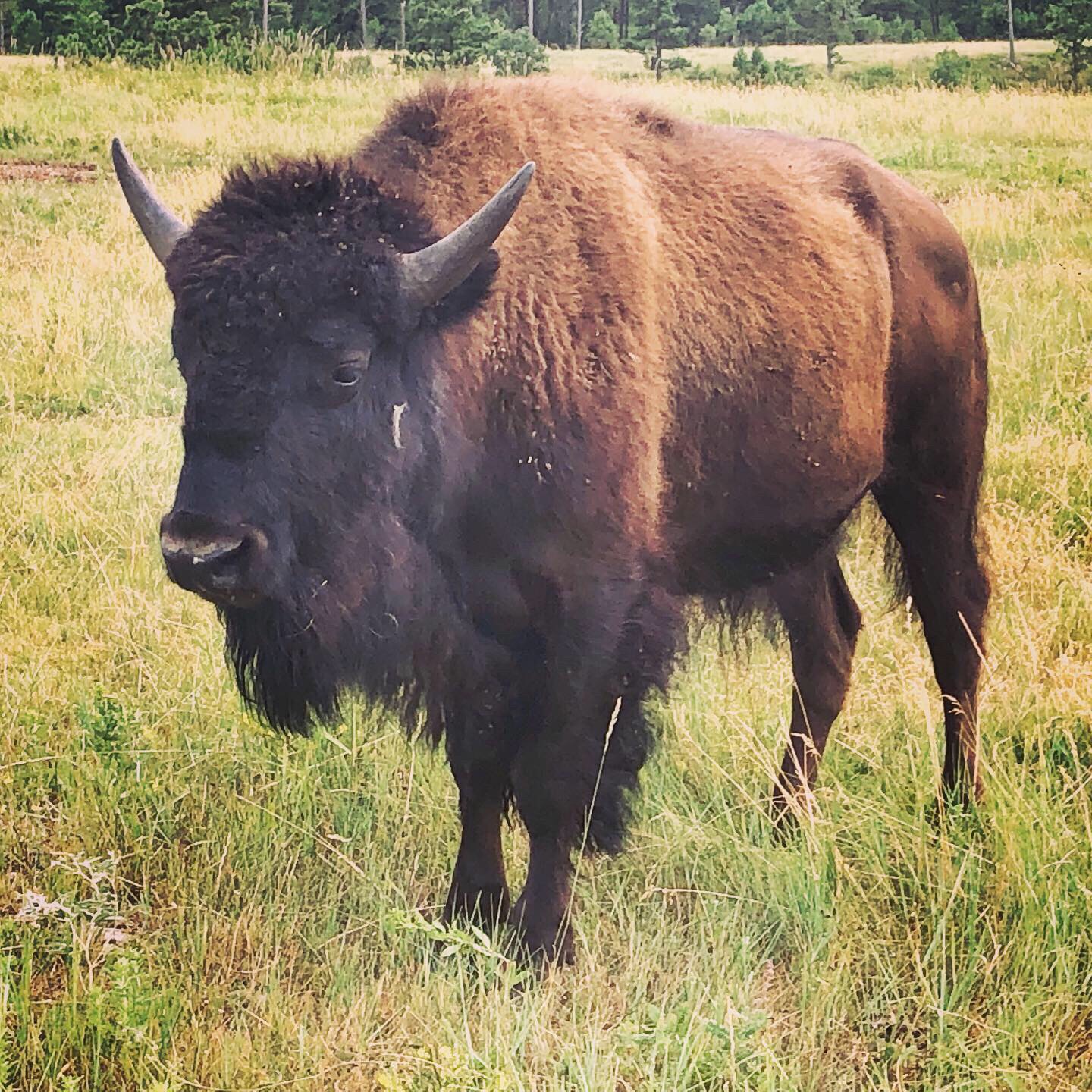
 We drove to The Badlands taking in the countless billboards for Wall Drug Store along the way. The rugged beauty of the Badlands draws visitors from around the world. These striking geologic deposits contain one of the world’s richest fossil beds. Ancient mammals such as the rhino, horse, and saber-toothed cat once roamed here. The park’s 244,000 acres protect an expanse of mixed-grass prairie where bison, bighorn sheep, prairie dogs, and black-footed ferrets live today. The prairie dogs were especially entertaining as they jumped from hole to hole squeaking and squealing with delight. They reminded me of “Alvin and the Chipmunks” and even tough-guy Sam thought they were adorable. A herd of big horn sheep grazing and napping in tall, wild grass with the striped clay canyons and orange sunset in the backdrop was something you’d see on National Geographic Television.
We drove to The Badlands taking in the countless billboards for Wall Drug Store along the way. The rugged beauty of the Badlands draws visitors from around the world. These striking geologic deposits contain one of the world’s richest fossil beds. Ancient mammals such as the rhino, horse, and saber-toothed cat once roamed here. The park’s 244,000 acres protect an expanse of mixed-grass prairie where bison, bighorn sheep, prairie dogs, and black-footed ferrets live today. The prairie dogs were especially entertaining as they jumped from hole to hole squeaking and squealing with delight. They reminded me of “Alvin and the Chipmunks” and even tough-guy Sam thought they were adorable. A herd of big horn sheep grazing and napping in tall, wild grass with the striped clay canyons and orange sunset in the backdrop was something you’d see on National Geographic Television.





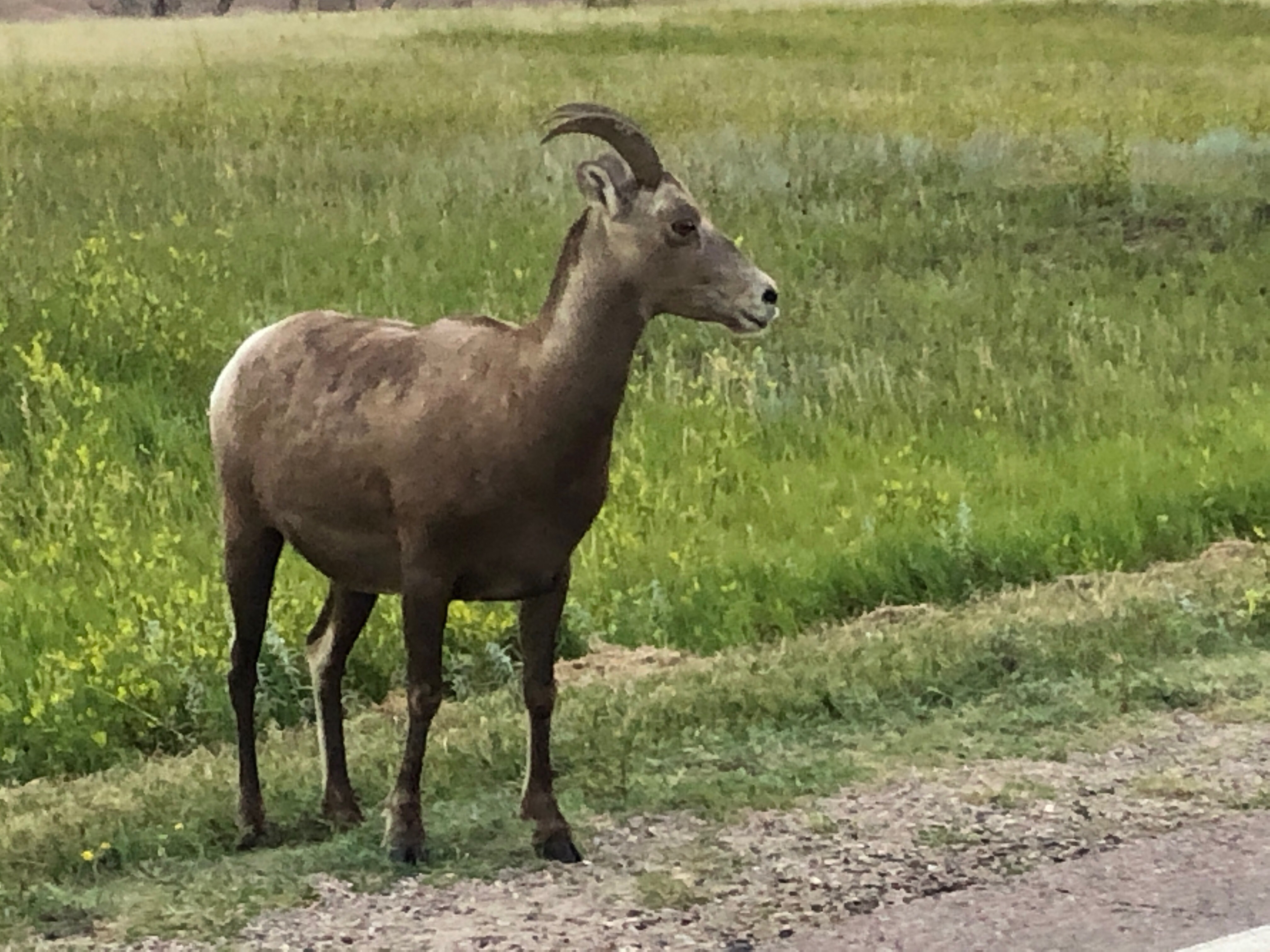



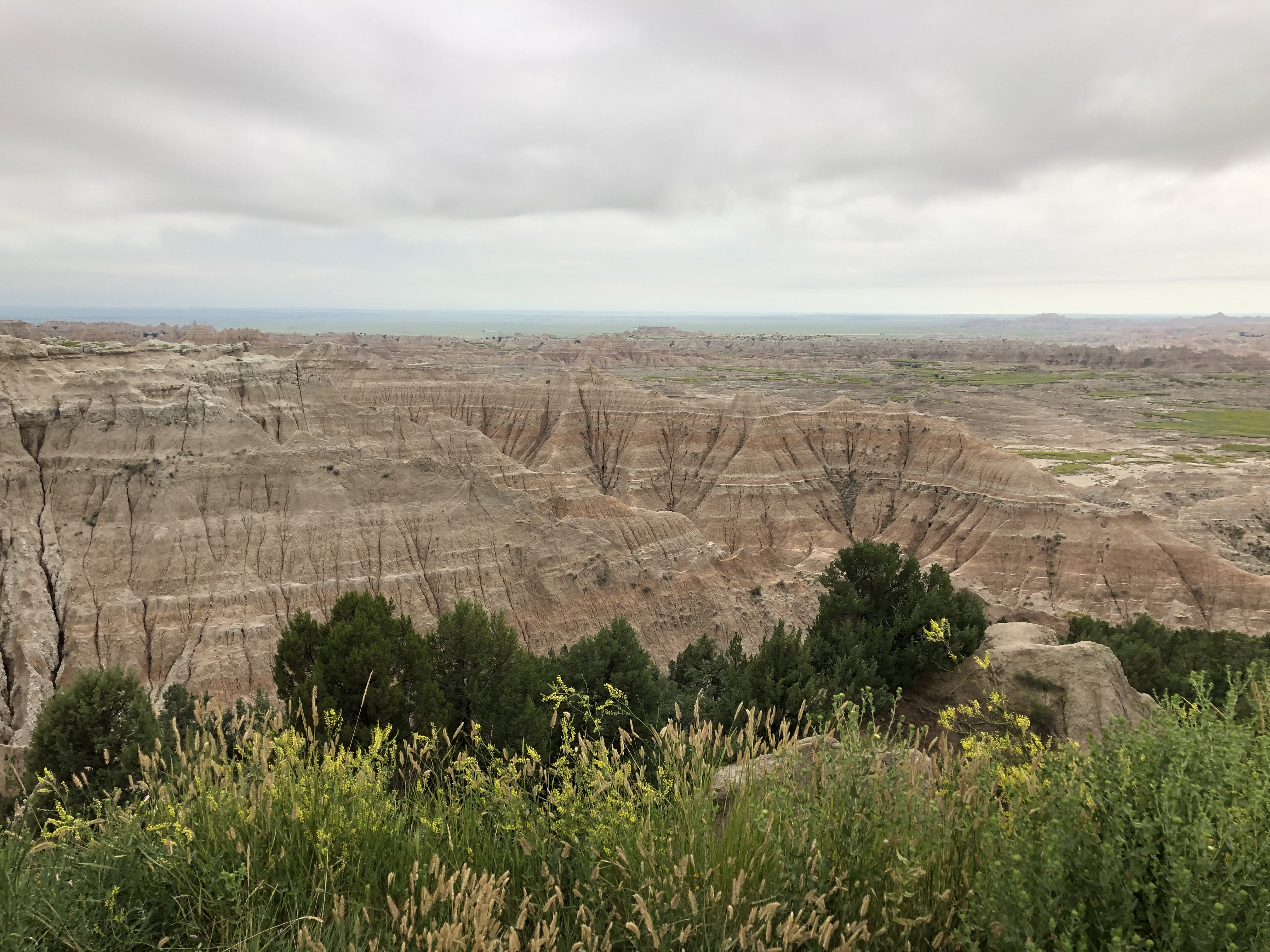 Wall Drug Store, often called simply Wall Drug, is a tourist attraction located in the town of Wall, South Dakota. It is a cowboy-themed shopping mall consisting of a drug store, gift shop, restaurants and various other stores, as well as an art gallery and an 80-foot brontosaurus sculpture. Unlike a traditional shopping mall, all the stores at Wall Drug operate under a single entity instead of being individually run stores. The New York Times has described Wall Drug as “a sprawling tourist attraction of international renown [that] draws some two million annual visitors to a remote town.”
Wall Drug Store, often called simply Wall Drug, is a tourist attraction located in the town of Wall, South Dakota. It is a cowboy-themed shopping mall consisting of a drug store, gift shop, restaurants and various other stores, as well as an art gallery and an 80-foot brontosaurus sculpture. Unlike a traditional shopping mall, all the stores at Wall Drug operate under a single entity instead of being individually run stores. The New York Times has described Wall Drug as “a sprawling tourist attraction of international renown [that] draws some two million annual visitors to a remote town.”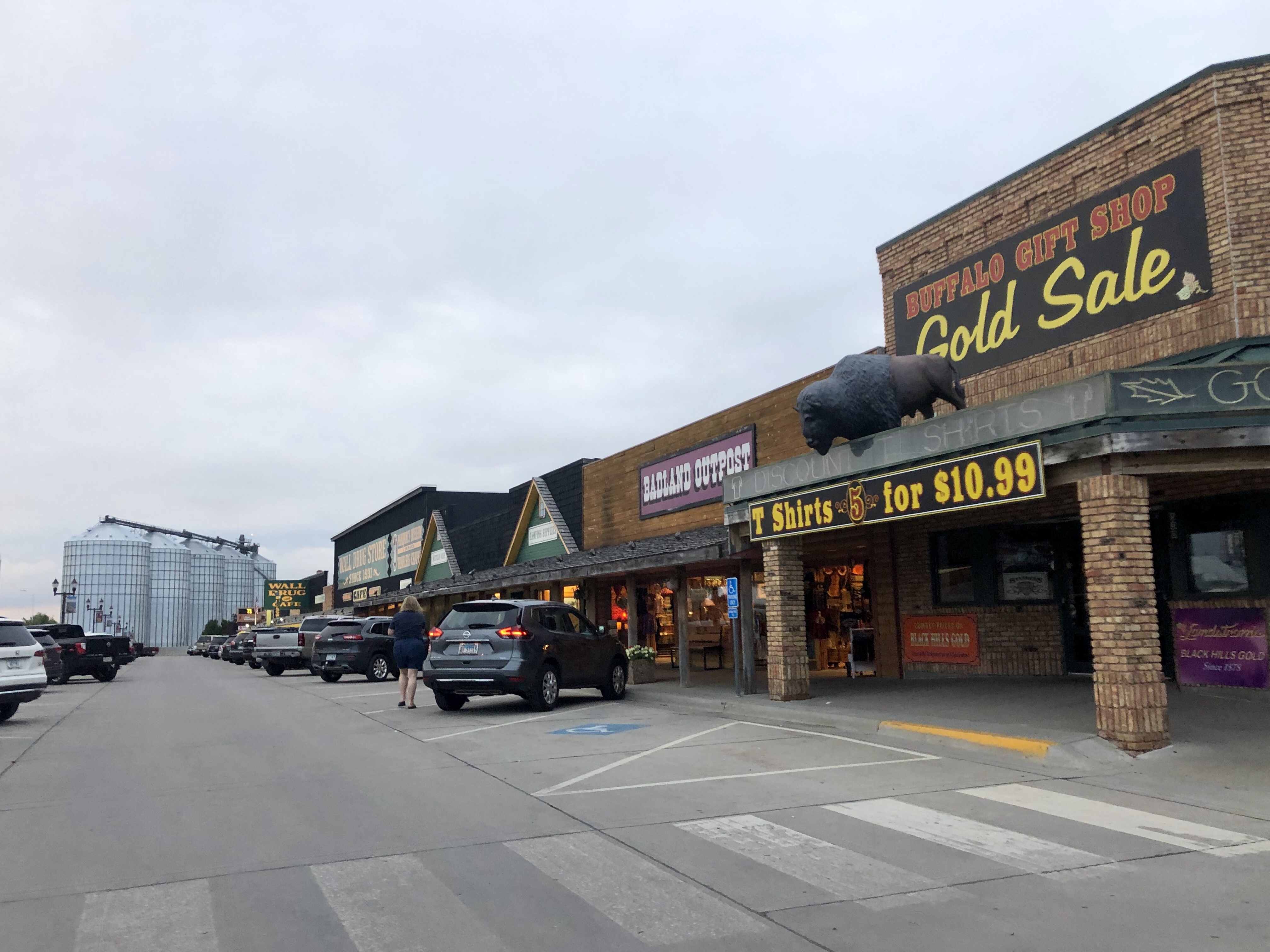
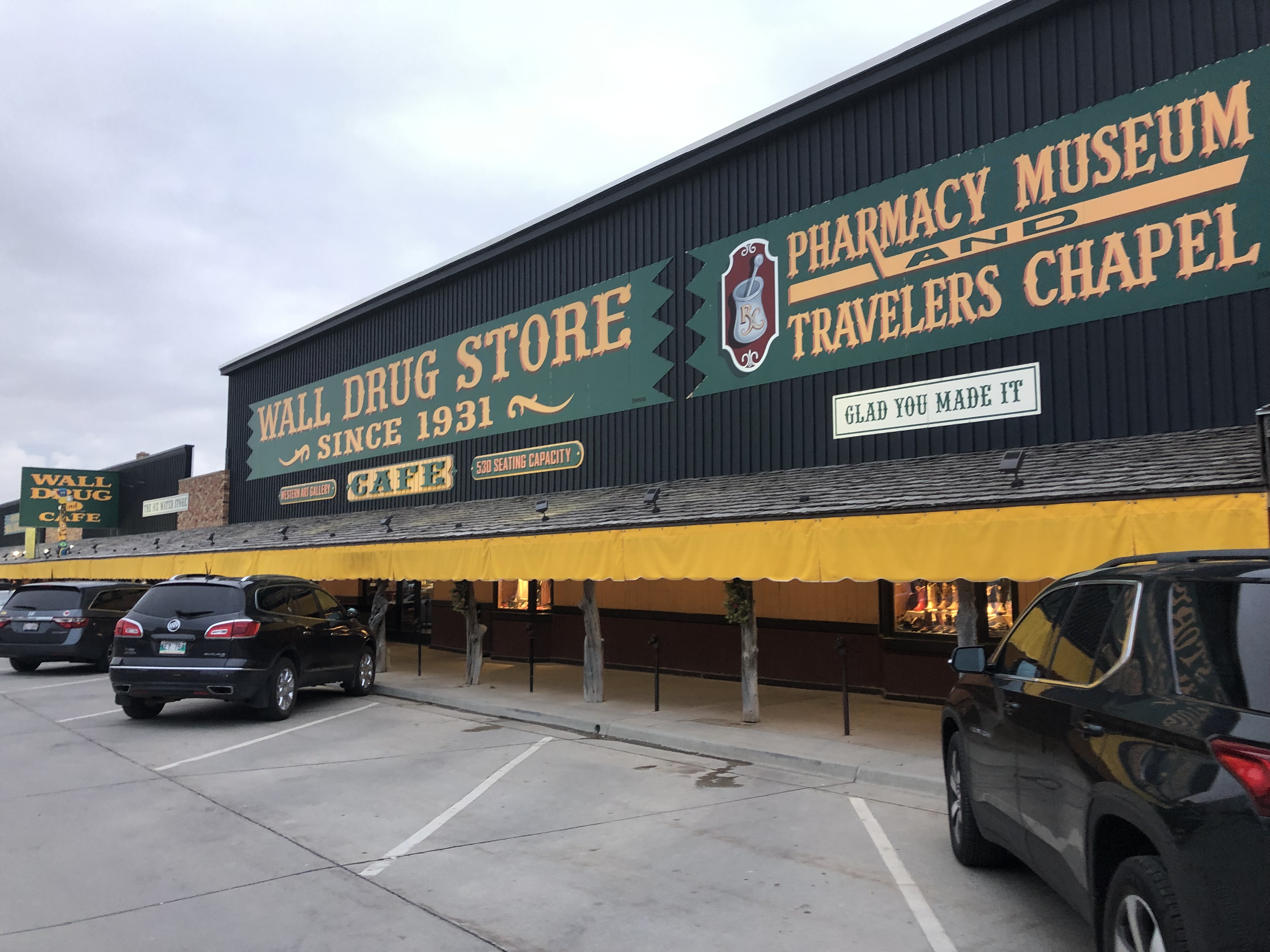 Steak was on the menu for both nights which is no surprise for the mostly meat-and-potato loving crowd visiting the middle of cowboy country. The night before I arrived the group enjoyed Dakota Steakhouse where my Dad devoured a 44-ounce ribeye. We had good burgers and hand cut fries in Keystone despite the annoying flies which are prevalent throughout South Dakota. Local beef production is the norm and Red Rock Restaurant was no exception though the undercooked steaks had to be sent back for more time on the grill. The last day in Sturgis we found Jambonz Grill and Pub featuring southern cooking from Louisiana roots. They even have Po Boys.
Steak was on the menu for both nights which is no surprise for the mostly meat-and-potato loving crowd visiting the middle of cowboy country. The night before I arrived the group enjoyed Dakota Steakhouse where my Dad devoured a 44-ounce ribeye. We had good burgers and hand cut fries in Keystone despite the annoying flies which are prevalent throughout South Dakota. Local beef production is the norm and Red Rock Restaurant was no exception though the undercooked steaks had to be sent back for more time on the grill. The last day in Sturgis we found Jambonz Grill and Pub featuring southern cooking from Louisiana roots. They even have Po Boys. The Sturgis Motorcycle Rally is held annually for 10 days starting the first Friday in August, which was the day we happened to be there. Even though it was only the first day, street fairs were already active and motorcycles lined the crowded streets. Young women in bikinis offered “bike washes.” The rally was begun in 1938 by a group of Indian Motorcycle riders and was originally held for stunts and races. Attendance has historically been around 500,000 people, and the event generates around $800 million in revenue for this tiny town.
The Sturgis Motorcycle Rally is held annually for 10 days starting the first Friday in August, which was the day we happened to be there. Even though it was only the first day, street fairs were already active and motorcycles lined the crowded streets. Young women in bikinis offered “bike washes.” The rally was begun in 1938 by a group of Indian Motorcycle riders and was originally held for stunts and races. Attendance has historically been around 500,000 people, and the event generates around $800 million in revenue for this tiny town.


 From Sturgis we ventured on to Deadwood. The discovery of gold in the southern Black Hills in 1874 set off one of the great gold rushes in America. In 1876, miners moved into the northern Black Hills. That’s where they came across a gulch full of dead trees and a creek full of gold and Deadwood was born.
From Sturgis we ventured on to Deadwood. The discovery of gold in the southern Black Hills in 1874 set off one of the great gold rushes in America. In 1876, miners moved into the northern Black Hills. That’s where they came across a gulch full of dead trees and a creek full of gold and Deadwood was born.
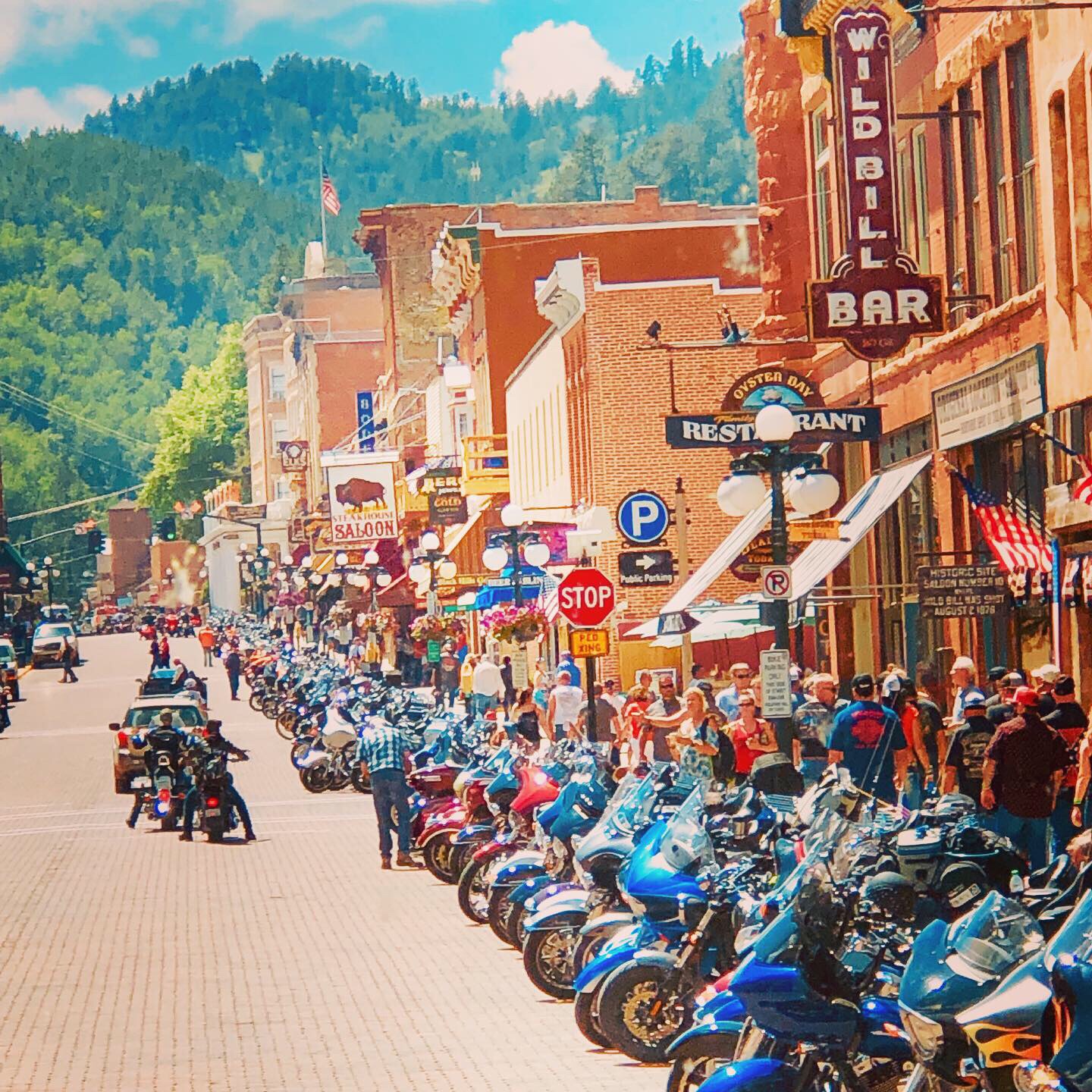 South Dakota is a slice of Americana that is filled with history and natural wonders. Rapid city is a great home base from which to explore many of the attractions. Continuing on, we made our way through Wyoming and into Montana, headed for Livingston from which we would explore Yellowstone, the topic of my next blog.
South Dakota is a slice of Americana that is filled with history and natural wonders. Rapid city is a great home base from which to explore many of the attractions. Continuing on, we made our way through Wyoming and into Montana, headed for Livingston from which we would explore Yellowstone, the topic of my next blog.

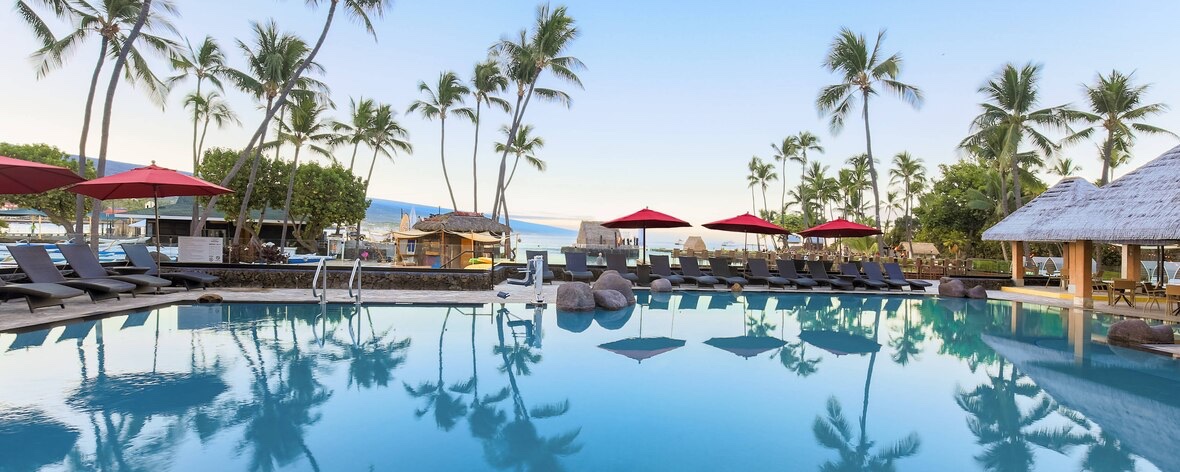

 I walked along the sea wall with waves crashing up onto the sidewalk and found myself at an open air restaurant called The Fish Hopper. With locations in Monterey, California and Kailua-Kona, the restaurant specializes in fresh seafood as well as steaks and features breathtaking views of the Pacific Ocean. I opted for one of the daily features, Parmesan encrusted mahi mahi.
I walked along the sea wall with waves crashing up onto the sidewalk and found myself at an open air restaurant called The Fish Hopper. With locations in Monterey, California and Kailua-Kona, the restaurant specializes in fresh seafood as well as steaks and features breathtaking views of the Pacific Ocean. I opted for one of the daily features, Parmesan encrusted mahi mahi. After dinner, I continued walking along Alii Drive where I stumbled upon San Francisco Bay Gourmet Coffee Bar, which features locally grown coffee and Tropical Dreams locally made ice cream. Unable to decide on a flavor, I ended up trying three: mud pie, kona coffee and macadamia nut. They also have açaí bowls, overnight oats, and baked goods.
After dinner, I continued walking along Alii Drive where I stumbled upon San Francisco Bay Gourmet Coffee Bar, which features locally grown coffee and Tropical Dreams locally made ice cream. Unable to decide on a flavor, I ended up trying three: mud pie, kona coffee and macadamia nut. They also have açaí bowls, overnight oats, and baked goods.
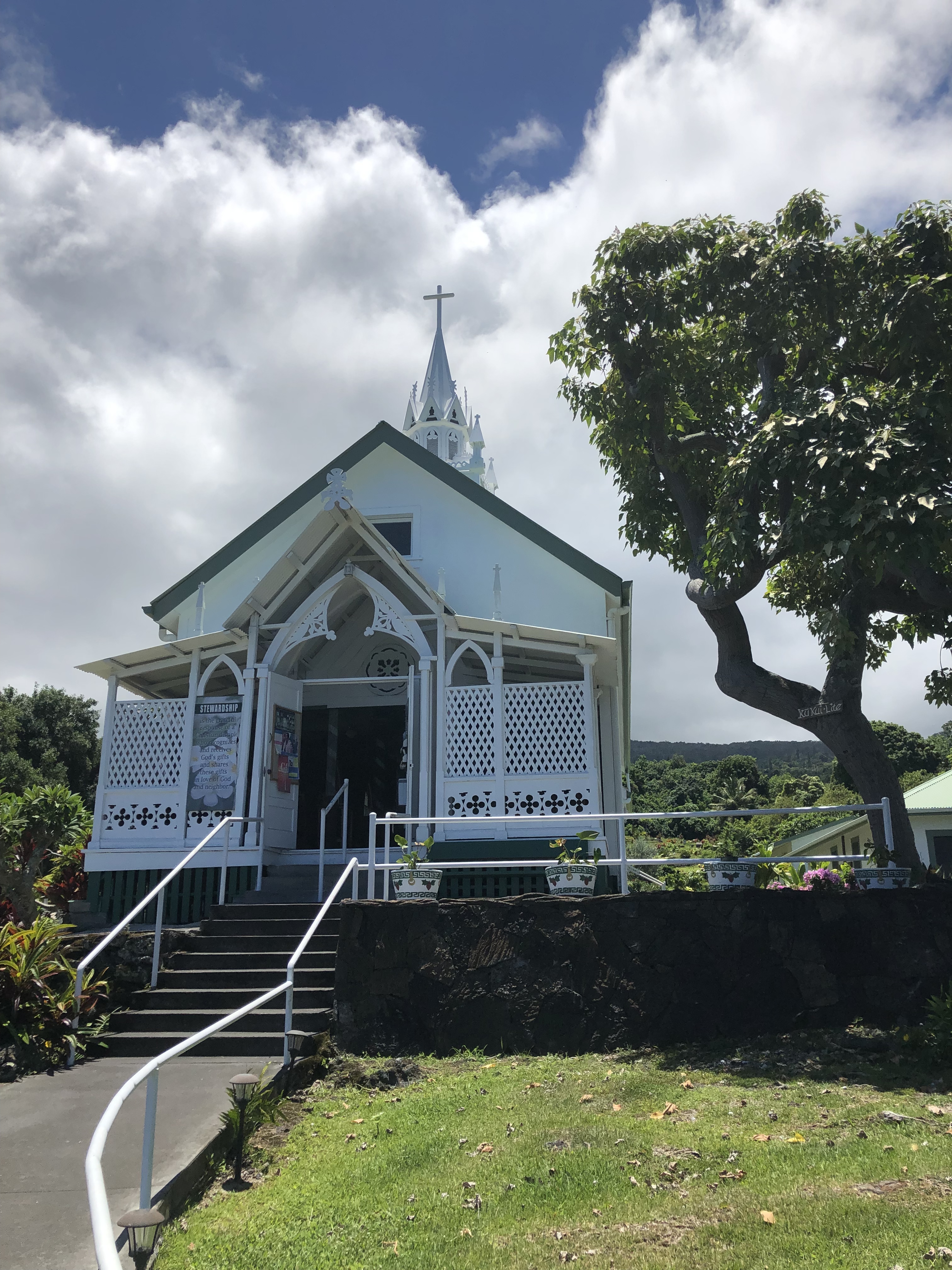
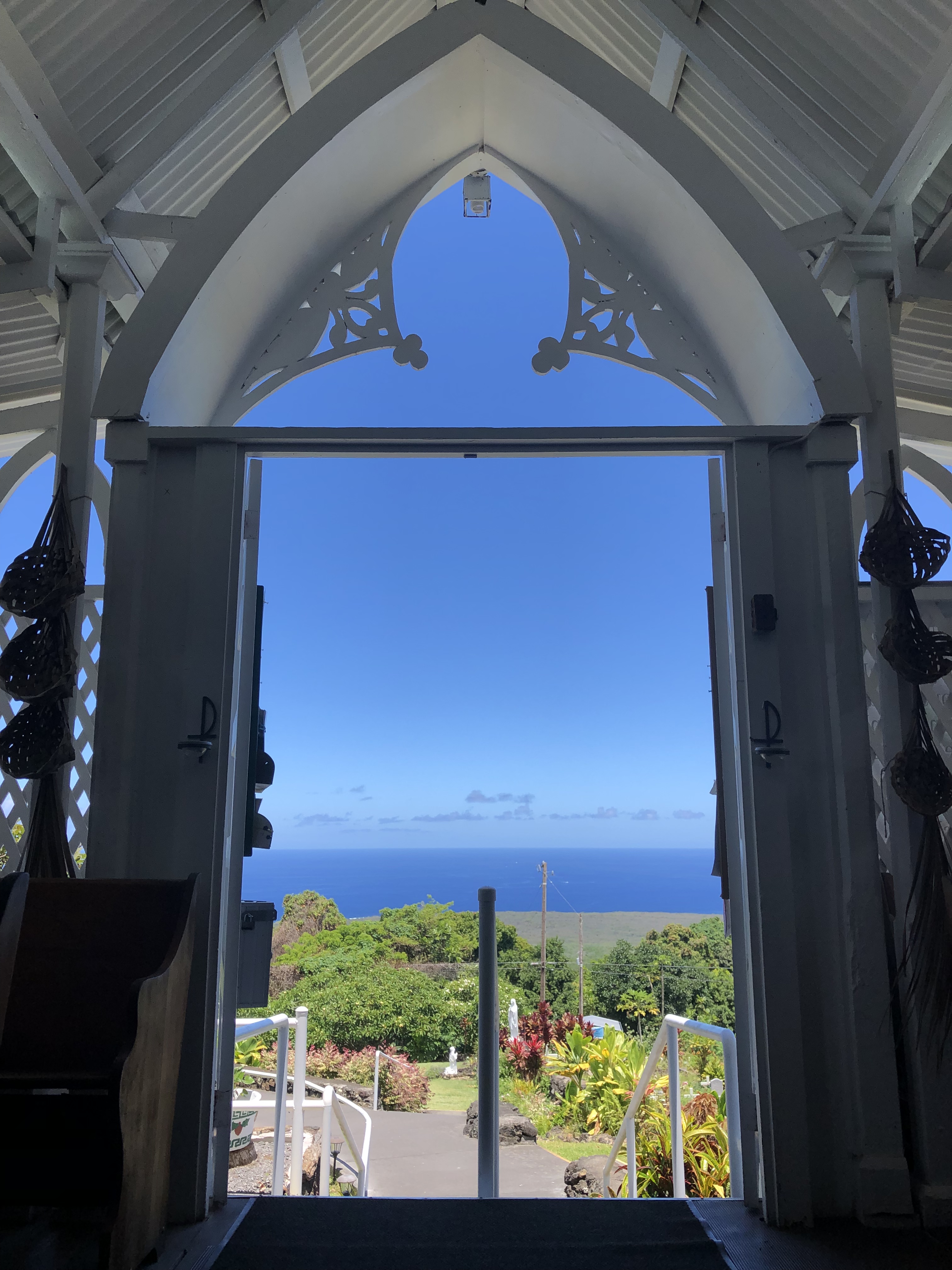

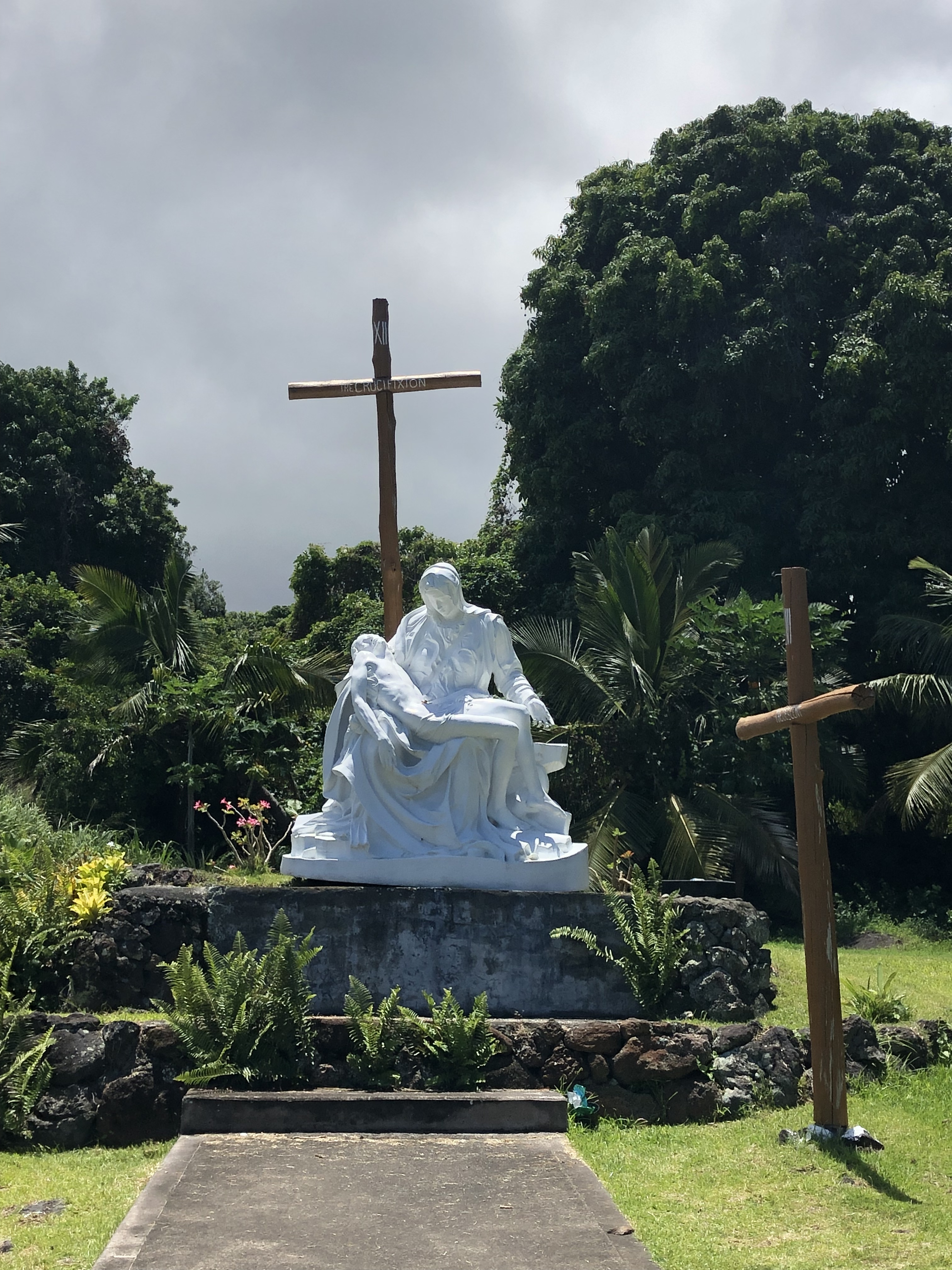
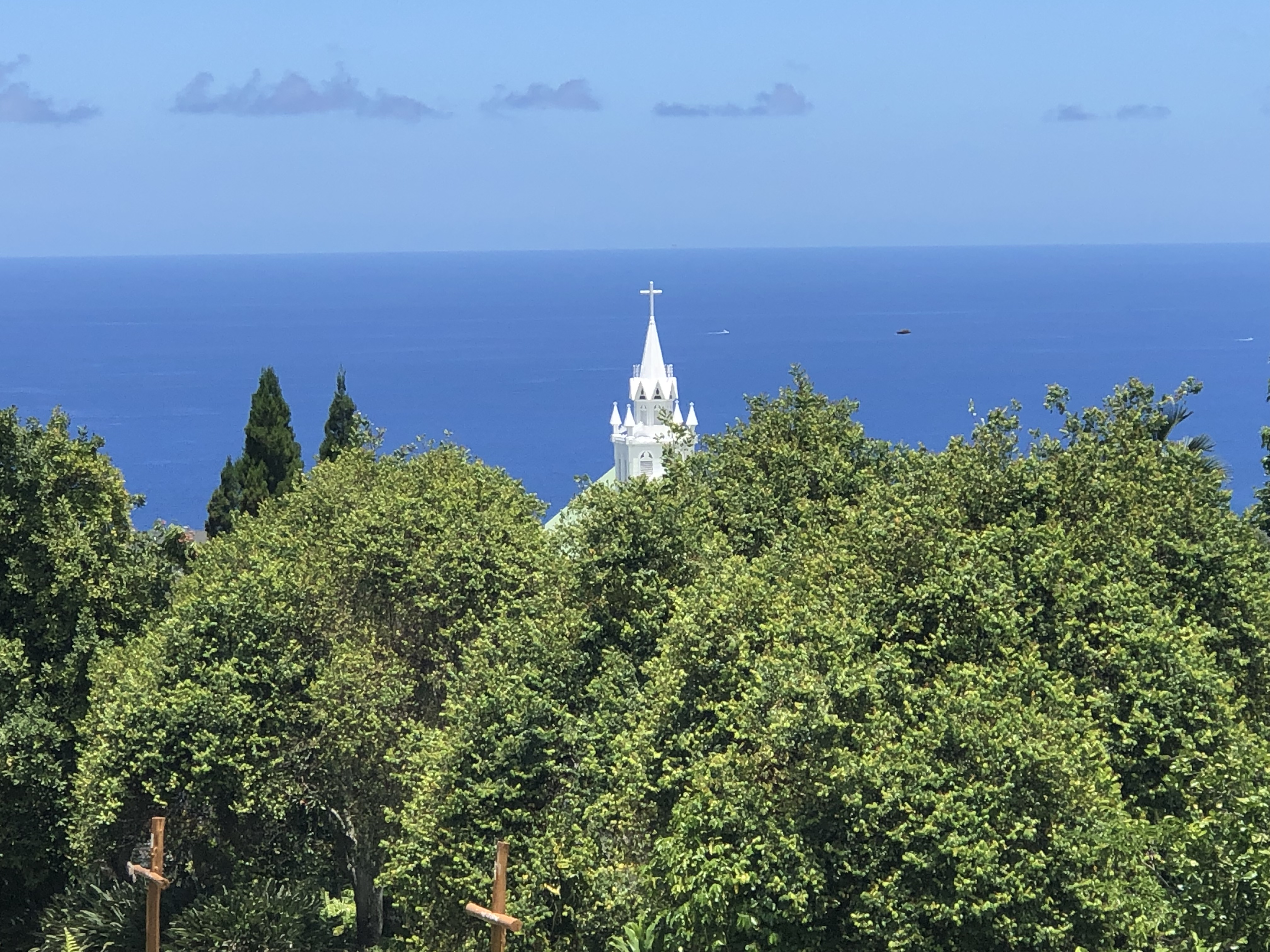 From the church, I made my way to Pu’uhonua O Hōnaunau National Historical Park (Place of Refuge). Pu’uhonua O Honaunau is an ancient place of sanctuary and one of the best spots to learn about the wealth of Hawaiian culture.
From the church, I made my way to Pu’uhonua O Hōnaunau National Historical Park (Place of Refuge). Pu’uhonua O Honaunau is an ancient place of sanctuary and one of the best spots to learn about the wealth of Hawaiian culture.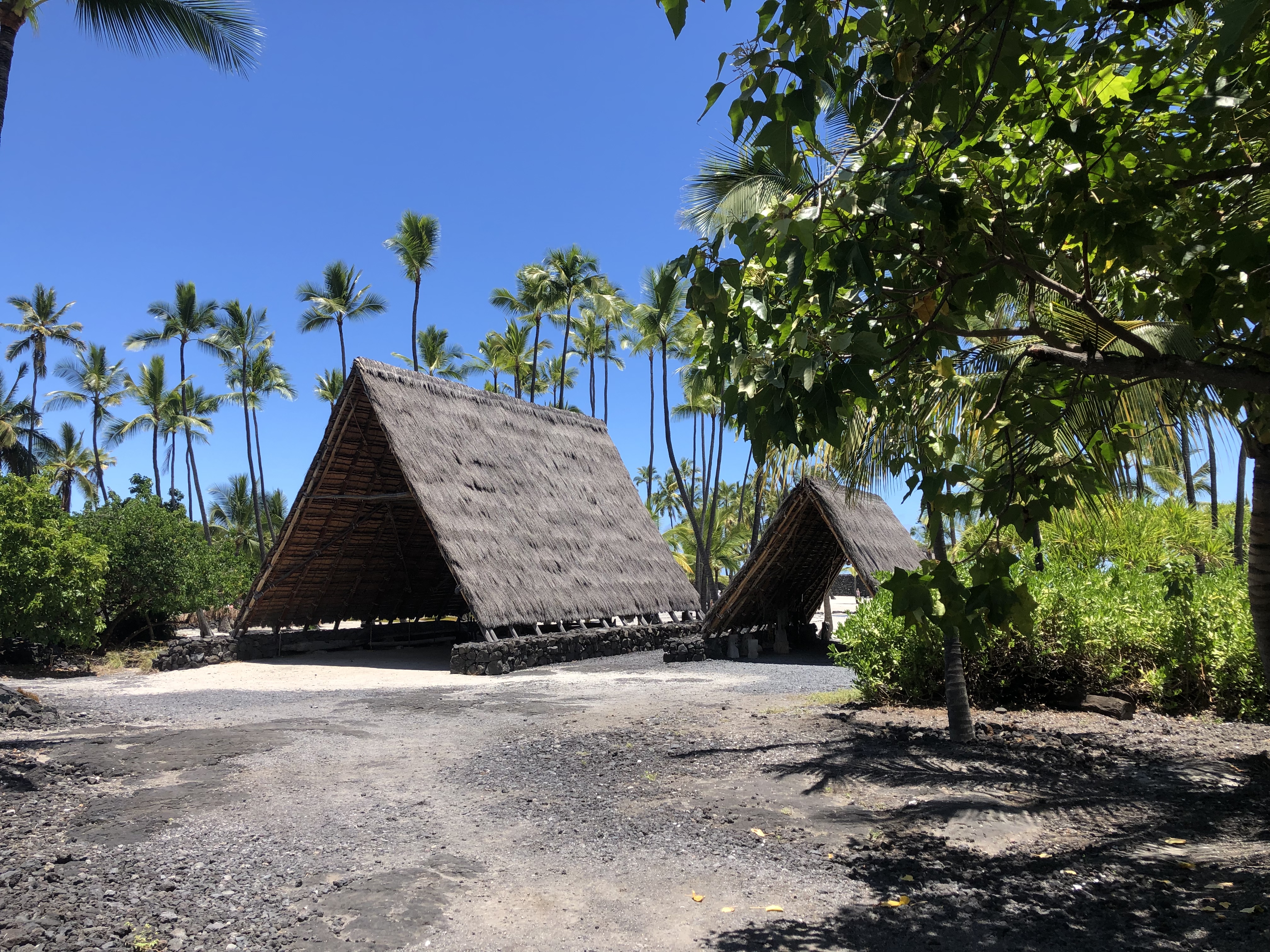



 From the park I drove north through the Kohala coast. Kohala is a land of extremes, from the jagged lava fields surrounding Waikaloa to lush mountain ranch lands in Waimea. Waimea is also known as Kamuela, which happens to by my partner’s Hawaiian name (Samuel in English).
From the park I drove north through the Kohala coast. Kohala is a land of extremes, from the jagged lava fields surrounding Waikaloa to lush mountain ranch lands in Waimea. Waimea is also known as Kamuela, which happens to by my partner’s Hawaiian name (Samuel in English). With an elevation over 2,600 feet, Waimea/Kamuela is cooler than the island’s coastal towns. It also lies at the crossroads of the Big Island’s lush and wet windward side and its sunny and dry leeward coast — everything grows here. It holds one of the best farmers markets you’ll ever go to and is packed with farm-to-table restaurants that are consistently rated as some of the best on the islands.
With an elevation over 2,600 feet, Waimea/Kamuela is cooler than the island’s coastal towns. It also lies at the crossroads of the Big Island’s lush and wet windward side and its sunny and dry leeward coast — everything grows here. It holds one of the best farmers markets you’ll ever go to and is packed with farm-to-table restaurants that are consistently rated as some of the best on the islands. I drove through Historic Honoka’a Town, which is where my partner’s mom’s Hawaiian lineage is traced. Her great grandfather Rickard was the town sheriff and the family homestead is now a Salvation Army. The North Hawaiʻi Education and Research Center (NHERC), part of the University of Hawaii Hilo, features an exhibit space all about the Rickard family, for which a street is also named.
I drove through Historic Honoka’a Town, which is where my partner’s mom’s Hawaiian lineage is traced. Her great grandfather Rickard was the town sheriff and the family homestead is now a Salvation Army. The North Hawaiʻi Education and Research Center (NHERC), part of the University of Hawaii Hilo, features an exhibit space all about the Rickard family, for which a street is also named.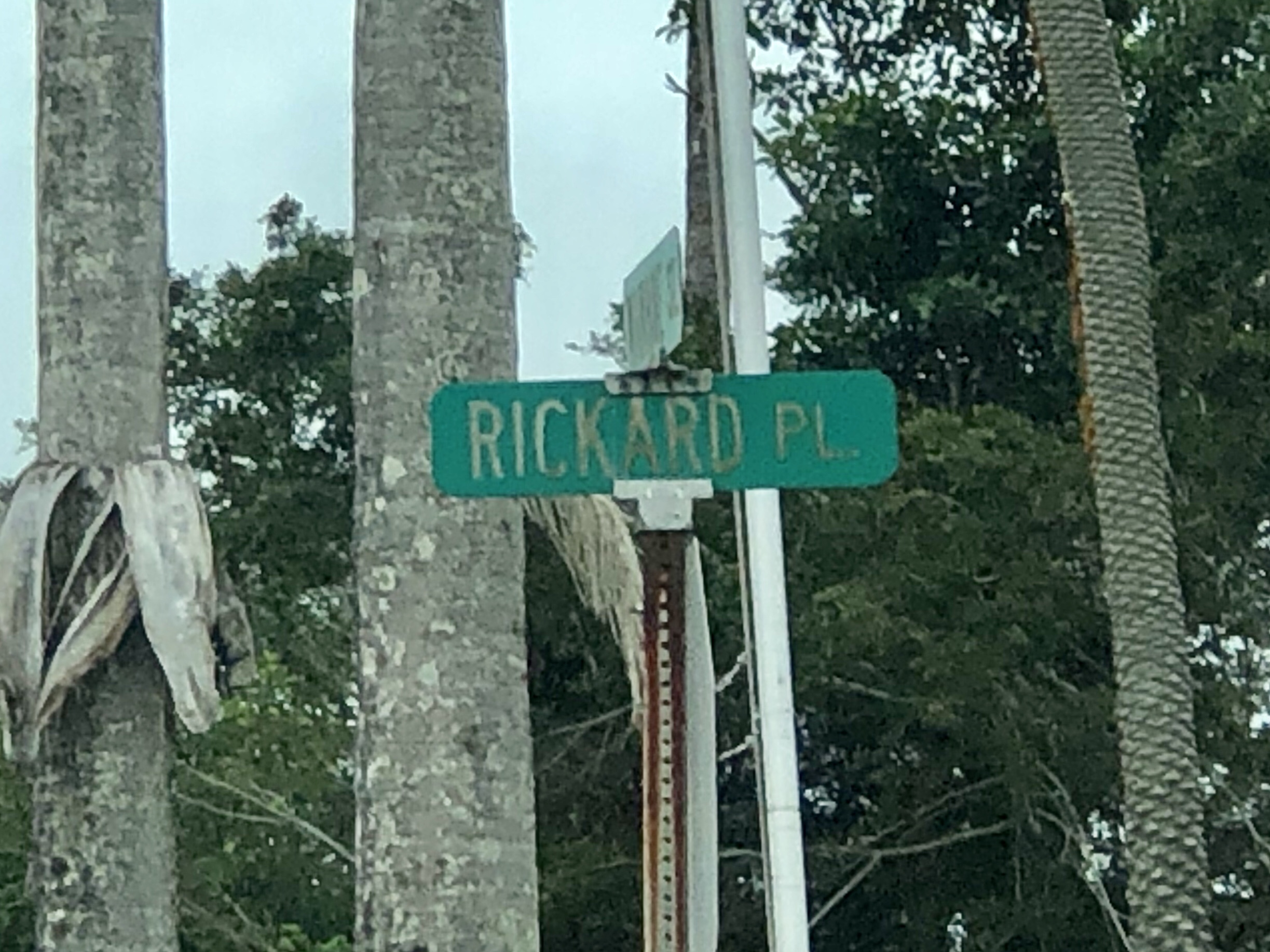 Much of the Big Island is a rural dream of wide-open spaces, and the Hamakua region’s small towns, including Honoka’a and Kukuihaele, have a classic small town charm. About a six mile drive from Honoka’a is the Waipio Valley Lookout. I had seen this breathtaking black sand beach with mountain backdrop while watching “Scenic Hawaii” on the television at home and had to see it for myself. Rich in history and natural beauty, the Waipio Valley is best viewed from the Waipio Valley Lookout.
Much of the Big Island is a rural dream of wide-open spaces, and the Hamakua region’s small towns, including Honoka’a and Kukuihaele, have a classic small town charm. About a six mile drive from Honoka’a is the Waipio Valley Lookout. I had seen this breathtaking black sand beach with mountain backdrop while watching “Scenic Hawaii” on the television at home and had to see it for myself. Rich in history and natural beauty, the Waipio Valley is best viewed from the Waipio Valley Lookout.
 Just down the hill is the Waipio Valley Artworks Café and Gallery, exclusively featuring Hawaii Island artists and koa furniture. I chatted with the shopkeeper, Midge who also told me about the Waipio Valley Shuttle, a four-wheel drive tour of the valley where you see 1,200 foot waterfalls, roaming wild horses and taro fields.
Just down the hill is the Waipio Valley Artworks Café and Gallery, exclusively featuring Hawaii Island artists and koa furniture. I chatted with the shopkeeper, Midge who also told me about the Waipio Valley Shuttle, a four-wheel drive tour of the valley where you see 1,200 foot waterfalls, roaming wild horses and taro fields.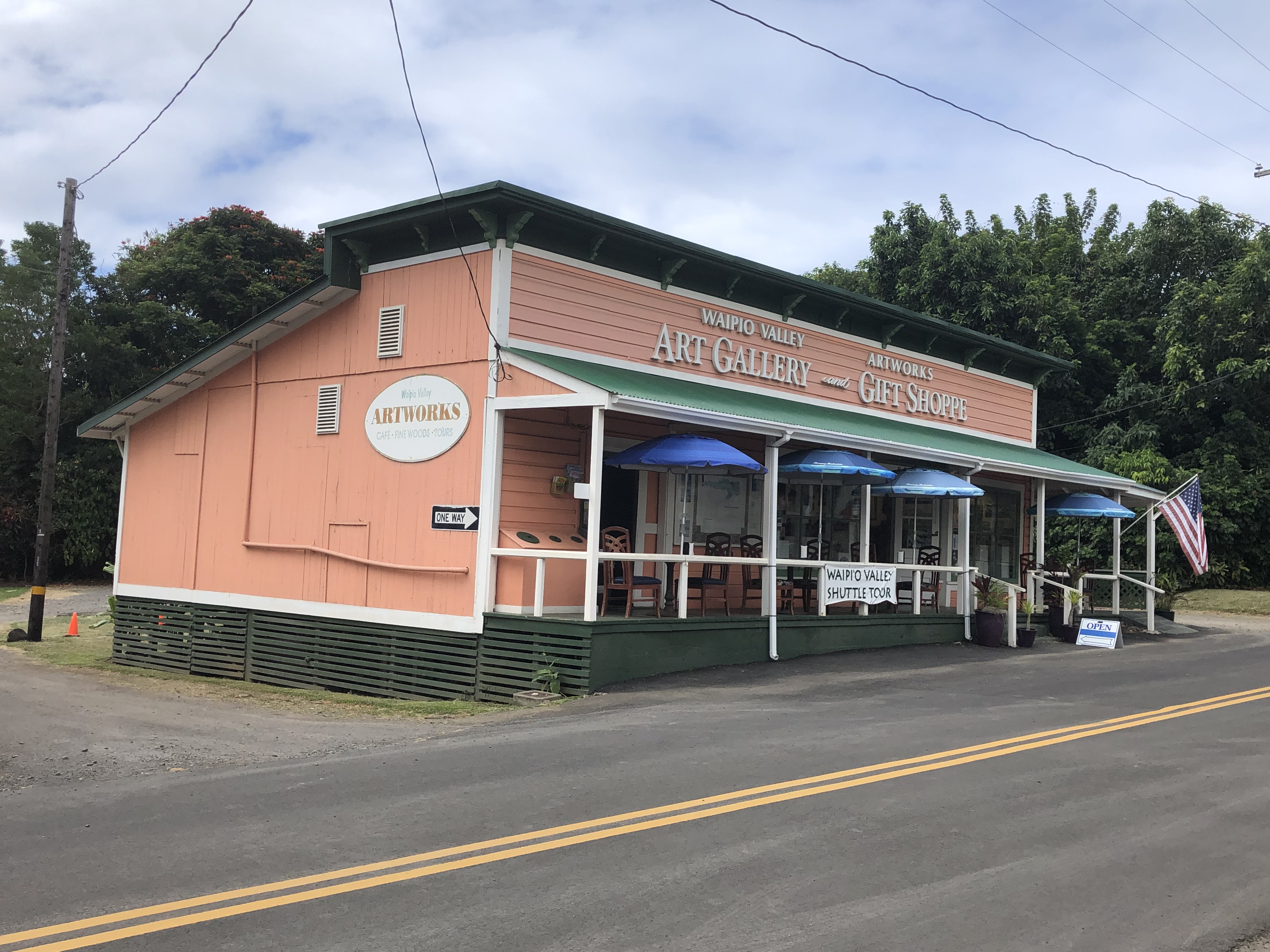 From the Waipio Valley, I made my way to the Waikoloa resort area where recent episodes of “The Real Housewives of Beverly Hills” were filmed at the Marriott Beach Resort. The housewives were on island for the wedding of Camille Grammar, who owns a home in one of the elite private communities in the area. Across from the Marriott are the King’s Shops, featuring restaurants and retail on a man-made lake. I couldn’t resist a Tommy Bahama silk aloha shirt that is exclusive to the islands and is new to the collection—it features vibrant sunset colors, palm trees and a giant hula dancer embroidered on the back.
From the Waipio Valley, I made my way to the Waikoloa resort area where recent episodes of “The Real Housewives of Beverly Hills” were filmed at the Marriott Beach Resort. The housewives were on island for the wedding of Camille Grammar, who owns a home in one of the elite private communities in the area. Across from the Marriott are the King’s Shops, featuring restaurants and retail on a man-made lake. I couldn’t resist a Tommy Bahama silk aloha shirt that is exclusive to the islands and is new to the collection—it features vibrant sunset colors, palm trees and a giant hula dancer embroidered on the back.
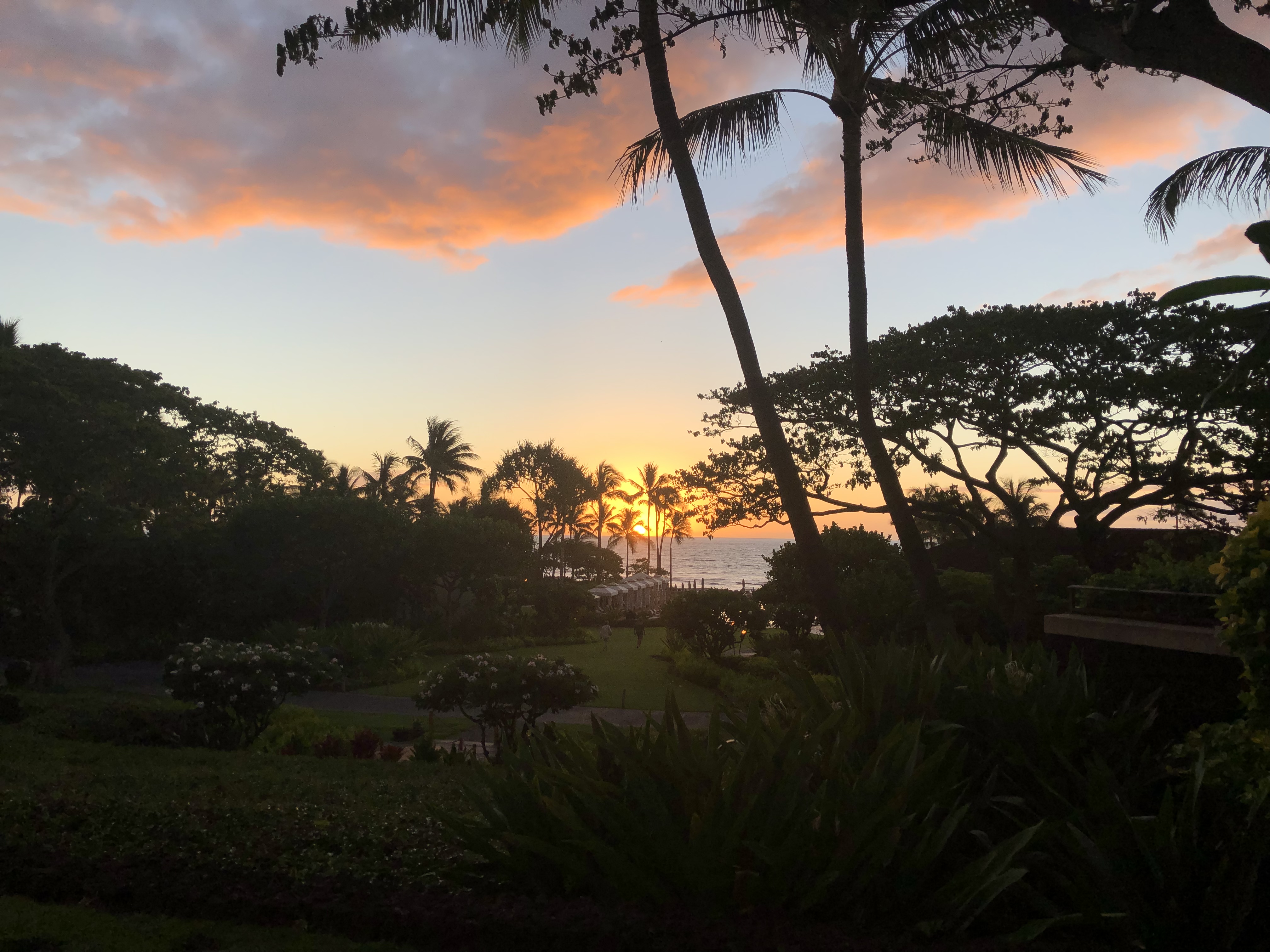
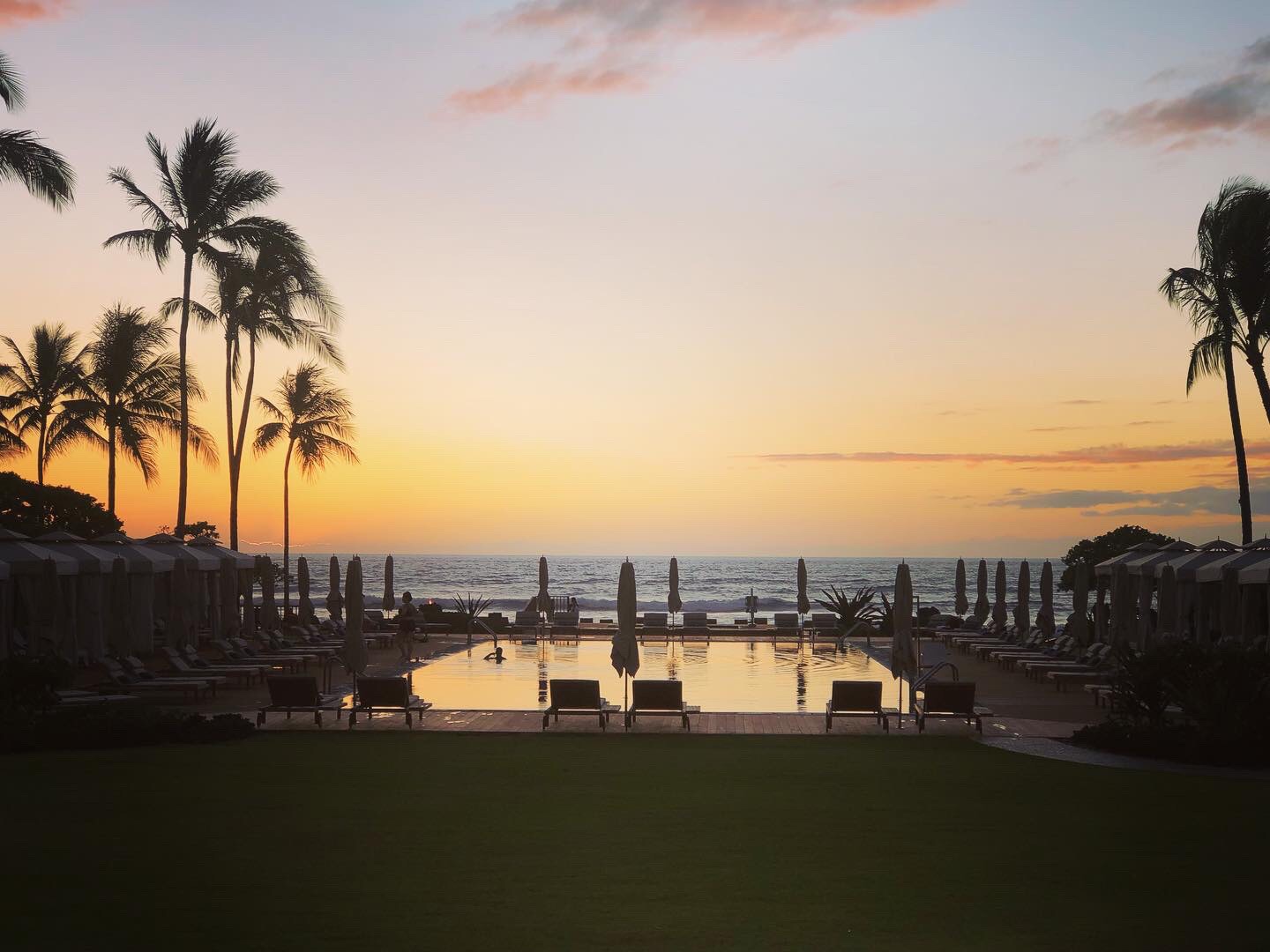 On Sunday afternoon before heading home, I visited the Hulihe’e Palace. Located across the street from Mokuaikaua Church, on the scenic Kailua Bay’s shoreline, this is one of the most important historic structures in Kailua. Built in the 1800’s for Hawaiian royalty, it is today a fascinating museum dedicated to preserving Hawaii’s unique cultural heritage.
On Sunday afternoon before heading home, I visited the Hulihe’e Palace. Located across the street from Mokuaikaua Church, on the scenic Kailua Bay’s shoreline, this is one of the most important historic structures in Kailua. Built in the 1800’s for Hawaiian royalty, it is today a fascinating museum dedicated to preserving Hawaii’s unique cultural heritage.

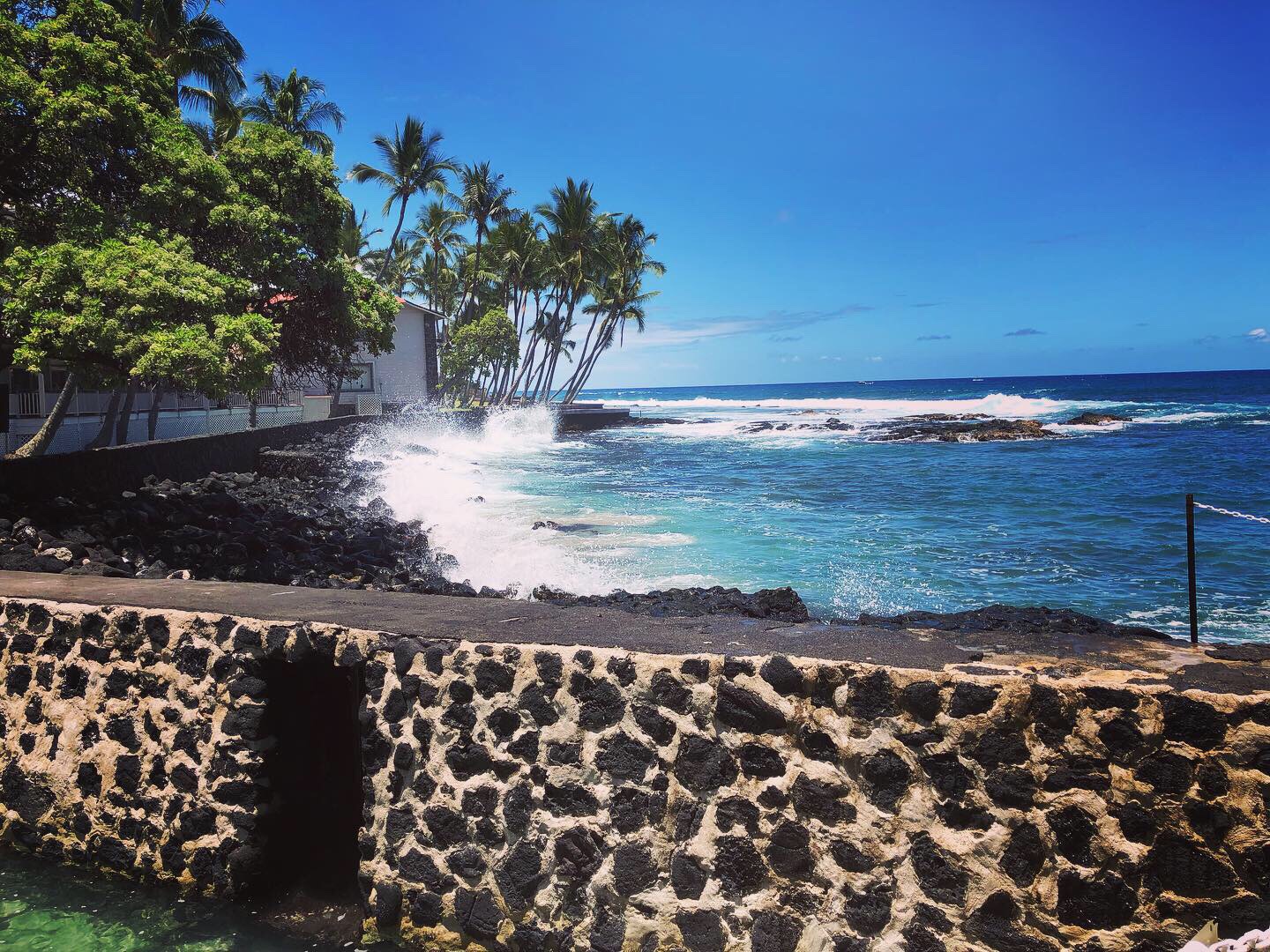 I walked to the opposite end of Alii Drive to the Royal Kona Resort featuring Don The Beachcomber Restaurant, which claims to be the home of the original mai tai. The waves crash against the sea wall at the ocean front restaurant and lounge, where you can enjoy pizzas, fish and chips and burgers.
I walked to the opposite end of Alii Drive to the Royal Kona Resort featuring Don The Beachcomber Restaurant, which claims to be the home of the original mai tai. The waves crash against the sea wall at the ocean front restaurant and lounge, where you can enjoy pizzas, fish and chips and burgers.

 After lunch it was time to head to the airport and return to Oahu, just as it started to rain. With each island offering its own unique flavor and vibe, I am getting used to island hopping as a way of playing tourist and enjoying a change of surroundings in this island paradise in the middle of the pacific, which I’m now fortunate to call home.
After lunch it was time to head to the airport and return to Oahu, just as it started to rain. With each island offering its own unique flavor and vibe, I am getting used to island hopping as a way of playing tourist and enjoying a change of surroundings in this island paradise in the middle of the pacific, which I’m now fortunate to call home.